THE NAWIC JOURNAL 2022
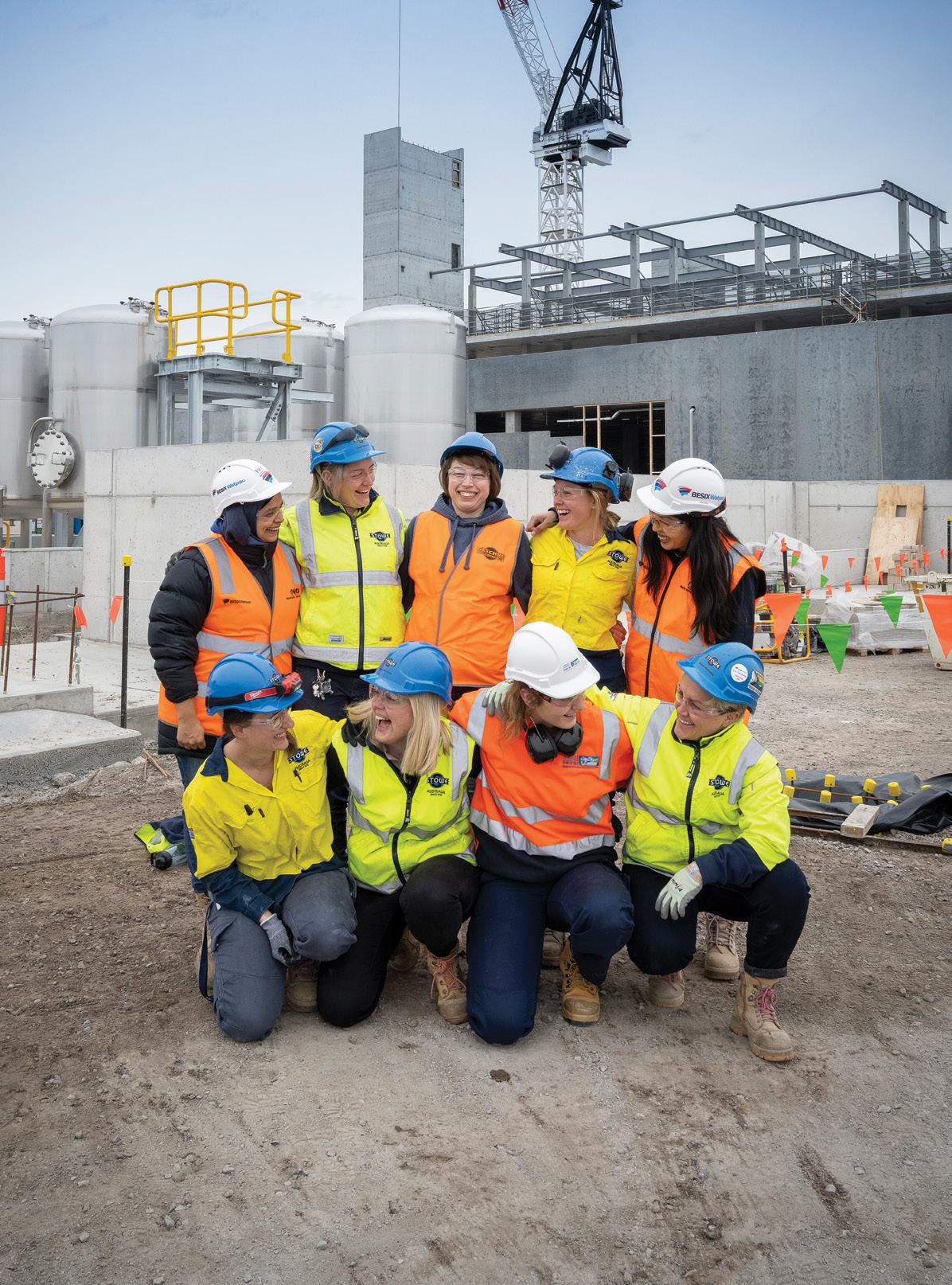

Twenty-seven years ago, NAWIC Australia was founded in Melbourne, on Wurundjeri land of the Kulin Nation.
We pay our respects to the traditional owners of this land and waterways, as well as elders, past, present and emerging.
We extend this respect to all indigenous peoples of this continent and its adjacent lands, recognising their cultures as the oldest continuous living cultures in human history.
We recognise the deep spiritual connections and relationship Aboriginal and Torres Strait Islander people have with community, as well as the lands, oceans, waterways, air and sky.
We acknowledge that the land we live, work and play on always was and always will be Aboriginal land.
Editor: Vicky Young Designer: Nikala Drager
Cover: Laura Pollar, Jess Mckenzie, Jamie Olden, Olivia Kennedy, Lucy Phillips, Tegan Connolly, Anastasia Shepelova, Rachel David, Hira Salman Photography: Sarah Louise Photography
Stowe at CSL Banksia, WATPAC Managing Contractor
NAWIC assumes no liability or responsibility for any inaccurate, delayed or incomplete information, nor for any actions taken in reliance thereon. The information contained about each individual, event or organisation has been provided by such individual, event organisers or organisation without verification by us.
The opinion expressed in each article is the opinion of its author and does not necessarily reflect the opinion of NAWIC. Therefore, NAWIC carries no responsibility for the opinion expressed thereon.
©The NAWIC Journal 2022. Any form of reproduction of any content from this publication without the written permission of NAWIC is strictly prohibited.
ABOUT NAWIC 1 THE NAWIC BOARD OF DIRECTORS 2 CHAIR PERSON’S FOREWORD 4 GENERAL MANAGER’S FOREWORD 5 COMMISSIONER’S FOREWORD 6 ACTION FROM ADVERSITY NAWIC’s International Women’s Day Scholarship 2022 Winner – Gabrielle French 7 AMY’S BRIGHT IDEA 2021 Bright Idea Scholarship Winner Amy Chapple Shares With Us Her Journey So Far 9 MENTAL HEALTH & PREVENTION OF SUICIDE IDEATION Among Female Workers Should Be an Industry Priority 11 WINGS TO FLY An Interview with Isha & Salonee Sarnaik 13 DIVERSITY & INCLUSION Let’s Stand Together & Call It Out to Create Change 15 AN INTERVIEW WITH ROBYN LOWE Electrical Trades Teacher, Mentor, NAWIC Member and D&I Advocate 17 MALE ALLY PPTEU 2022 Award Inspired by NAWIC 19 INFRASTRUCTURE PRODUCTIVITY IN AUSTRALIA IS DECLINING – Here’s How to Turn It Around 21 TINY HOUSES 23 RETHINKING OCCUPATIONAL HEALTH & SAFETY MANAGEMENT OF WOMEN IN CONSTRUCTION 25 GROWING NAWIC’S ‘WOMEN ON TOOLS’ An Interview with Radmila Desic, AM FAIB & Life Member of NAWIC 27 FULTON HOGAN Helping the Richmond Football Club Women’s Program Kick Goals 29 EBONY ANTONIO SHINES A LIGHT ON FEMALES IN CONSTRUCTION 31 BE THE CO-PILOT FOR THE NEXT GENERATION 33 PROCURING CULTURE CHANGE IN CONSTRUCTION 35
Publisher: NAWIC PO
Glenmore Park 2745 T: 1800 767 977 E: admin@nawic.com.au W: www.nawic.com.au ELEVATING MARKETING FOR SMALL & MIDSIZE CONSTRUCTION BUSINESSES 39 UPGRADING THE WORLD’S LARGEST TRAM NETWORK 42 CELEBRATING WOMEN in the Construction Industry at Development Victoria 44 BRADFIELD CITY CENTRE’S FIRST BUILDING Restoring Women’s Country 47 MANAGING FLEX TO GROW A CAREER ALONGSIDE A FAMILY 49 CHANGEMAKERS Meet the Women Shaping the Future of Our Industry 52 JUGGLING MOTHERHOOD 55 TRANSFORMING LIVES Why Sustainability Must Strike at the Heart of Our Projects 58 SWITCHING ON CUSTOMERS & YOUNG WOMEN TO ACHIEVE #25BY2025 – with 3 Pillars & a Bulldozer 60 2021 NAWIC AWARDS FOR EXCELLENCE 63 2021 NAWIC Awards for Excellence WA 64 2021 NAWIC Awards for Excellence NT 67 2021 NAWIC Awards for Excellence TAS 71 2021 NAWIC Awards for Excellence NSW 74 2021 NAWIC Awards for Excellence ACT 77 2021 NAWIC Awards for Excellence SA 80 TAYLOR’S TRAILBLAZER Katherine Barrionuevo, Senior Design Manager 83 2021 NAWIC Awards for Excellence VIC 84 2021 NAWIC Awards for Excellence QLD 87 HOUSING DEVELOPMENT SETS NEW BENCHMARK FOR WOMEN AT RISK 91 HOW CAN WE ENCOURAGE & CREATE MORE PATHWAYS FOR WOMEN ON BOARDS IN CONSTRUCTION? 93 EMPOWERING GIRLS TO FIND THEIR PLACE IN CONSTRUCTION 95
Project:
Box 8327,
CONTENTS
ABOUT NAWIC
At NAWIC we welcome women in construction from all walks of life, cultures, ages and career stages. Our members work in remote and regional locations, in the city, by the coast, on farms and in factories, as sole traders and in large commercial and government enterprises and infrastructure. NAWIC members work onsite on the tools, in the office and a hybrid of these, are apprentices, business backbones, male allies and CEO’s, and everything in between. Our corporate members are organisations with a genuine commitment to workplace gender diversity and inclusion.
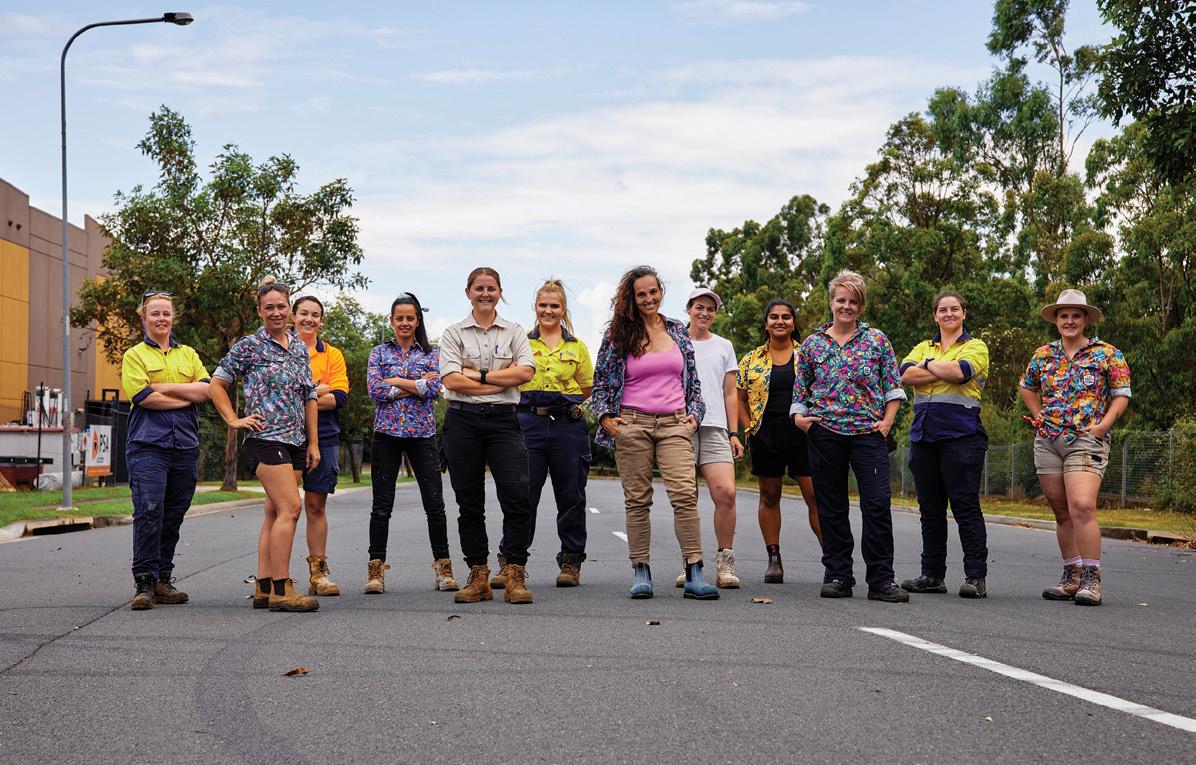
Whether you are beginning your career, looking for a new chapter or refining your lifetimes work, at NAWIC you will find a diverse community of likeminded people; great people doing great work.
A not-for-profit and the Peak Body championing the diverse collective of women and non-male identifying people in construction, NAWIC provides a forum for its members to meet and exchange information, ideas and solutions. Our members have an opportunity to expand personal and business networks, maintain awareness of industry developments, improve skills and knowledge and make a contribution to other women in the construction industry.
We rise together.
THE NAWIC JOURNAL 2022
1
THE NAWIC BOARD OF DIRECTORS

SAMANTHA WOODWARD Vice Chairperson
Samantha is the Founder and Managing Director of THINK SAVVY - an organisation that provides services and high-tech solutions in the governance, risk, safety and compliance spaces. THINK SAVVY collaborates with medium and large enterprises nationally and internationally. Samantha has twenty plus years of experience in non-traditional working environments, including the mining and resources sector and the construction industry. As a woman in STEM, Samantha also has a passion for software technology and effectively bridges the divide between operational priorities and technology solutions, through demystifying technology. Prior to joining the NAWIC Board, Samantha held various roles in the NAWIC VIC Chapter including President and Sponsorship Chair. In her Director role, Samantha is an active voice for increased engagement of women and girls in the construction industry. She aligns herself with the priorities of celebrating women and encouraging them to be bold and brave while also advocating for industry change.
JENNIFER GILLETT Director
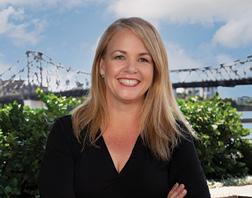
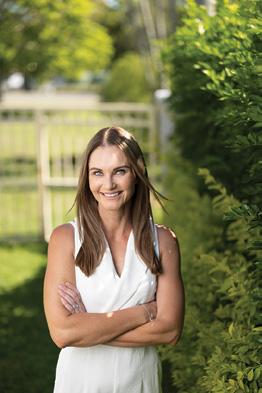
Jennifer is the current State General Manager with Essence Project Management and has 20 years’ experience in property & construction. Her experience has crossed industry, states and countries delivering major projects for a diverse range of organisations. Jennifer has been able to adapt and work in multiple industries for the past 20 years working across commercial property, air, rail, banking, health, government and retail in different cultures and countries.
Jennifer has been committed to encouraging diversity & career development within the property and construction industry. She has held roles with the Property Council of Australia (PCA) , the Australian Institute of Project Management (AIPM) and most recently with National Association of Women in Construction (NAWIC) as immediate past State President and Current Director on National Board (including Advocacy Committee) driving cultural change for all, awareness and increased female participation in the construction industry.
As the Precontracts Manager for John Holland’s Infrastructure and Major Projects Division, Loren leads the team that fuels the overall sustainability of the business, through the development and delivery of successful work winning outcomes. With degrees in Civil Engineering, Marketing and Public Relations, Loren has close to 15 years’ experience in the construction industry. She is an active member of the industry currently undertaking the role of Deputy Chair of the Infrastructure Association of Queensland (IAQ), has been an active Member of the National Association of Women in Construction since 2015, and has previously held board roles for Queensland Rugby League and a government funded Community and Social Housing organisation. In August 2022, Loren was appointed as a member of the Board of Professional Engineers of Queensland and has recently commenced her Master of Construction Law at the University of Melbourne.
2 THE NAWIC JOURNAL 2022
LOREN HICKEY Director
Lyn is a MSc qualified Quantity Surveyor with over 15 years experience in both Ireland and Australia within commercial construction. Lyn has held senior management positions for large scale businesses in Western Australia for over 6 years, during which time she has been pivotal in developing sustainable and strategic growth. In her current role as Pre-Construction Manager with ADCO Constructions Lyn oversees all preconstruction activities for ADCO WA and is also a member of the Senior Leadership Team. Lyn’s mission as a NAWIC Board Director is to is to work with a team of likeminded women to “achieve an equitable construction industry where women fully participate” and to do her utmost to contribute towards our Strategic Goal of a 25% diversity target by 2025.
Miriam is a projects and infrastructure partner at Ashurst, based in Perth. With more than 17 years’ experience in the construction industry Miriam’s focus is on the mining, social infrastructure, waste and water sectors. She has a depth of experience acting for both the private sector and government. Miriam loves working on WA based projects and has advised on major WA projects including the Fiona Stanley Hospital project, the Perth Children’s hospital project, the development of Elizabeth Quay and redevelopment of the Perth Museum. She also advised on the Kwinana Waste to Energy Facility for the Rivers Regional Council and the East Rockingham Waste to Energy Project as well as numerous iron ore projects in the Pilbara for BHP, including the recent South Flank project. Miriam has been actively involved with the WA Chapter of NAWIC since its inception in 2009 and a member of the National Board of Directors since 2017. She has thoroughly enjoyed contributing the growth of the WA chapter and now focussing on strategic issues for NAWIC as a board member.
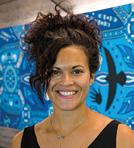



Kylie’s love of technicality and project management led her to a career in construction management. With a back ground in Civil Engineering and Management, Kylie has fulfilled multidisciplinary roles including Site Engineer, Design Engineer and Quantity Surveyor across her career. She has worked nationally in Perth and Melbourne, as well as internationally, having spent 5 years in Dubai, UAE. Currently, Kylie is working as an Assistant Project Manager working for Multiplex, and is based in Perth. Throughout her career, Kylie has always been extremely passionate about the future of women in construction, and enjoys encouraging, motivating and mentoring within the community. She hopes that we can all play our part in working towards a more inclusive and empowered future for all.
Lisa has worked in construction for 13 years, having joined the industry as a Graduate Project Manager at Transport for London where she quickly fell in love with project management and rail and construction projects. Lisa relocated to Melbourne from London in February 2021 and she is currently working for Metro Trains Melbourne as a Package Director leading the Airport Station and Viaduct sections of the Melbourne Airport Rail project. As a woman of colour and a senior construction leader who is not an engineer , Lisa is passionate about breaking down barriers for women of colour in the industry and ‘carrying the flag’ for non-engineers in construction. When it comes to hiring a diverse team made up of the best people for the job, you can count on Lisa to lead by example.
Kristine joined NAWIC in 2007 and became Chair of the ACT members of the NSW/ACT Chapter as it then was. After a few years she helped found the ACT Chapter of NAWIC and served as President of the ACT Chapter for over two years. She has a long history and background in construction having been the Construction Partner at Meyer Vandenberg Lawyers for several years before moving to Brisbane and joining Thiess. During her time in Brisbane, Kristine was the Project Lawyer on both the Airport Link project and the Victorian Desalination project. Kristine moved back to Canberra and worked as the Project Lawyer on the Light Rail project and is now working within the Infrastructure Delivery Directorate within the ACT Government. Kristine is very passionate about the role of women in the construction industry and has both mentored and been mentored by some of the most talented and innovative women in the industry.
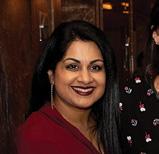
JESSICA EVANS Director
As a Client Relationship Manager at Taylor
Construction, Jessica focuses on building long-term, genuine partnerships and is driven to provide the industry’s highest customer experience. Her business development and relationship management skills have been honed through her years of experience in the construction industry in both Australia and Asia. Additionally, Jessica sits on the Beneficiary Review Committee at the Property Industry Foundation (PIF), a not-for-profit organisation dedicated to bringing the property and construction industry together to build homes for homeless youth.
 LYN O’BRIEN Director
KYLIE JUDD Director
LISA HOGBEN Director
LYN O’BRIEN Director
KYLIE JUDD Director
LISA HOGBEN Director
3 THE NAWIC JOURNAL 2022
MIRIAM D’SOUZA Director
KRISTINE SCHEUL Director
CHAIR PERSON’S FOREWORD
As NAWIC wraps up its 27th year in Australia it is important that we take a look at all the fantastic achievements of the people in the construction industry who are making waves and implementing real change.
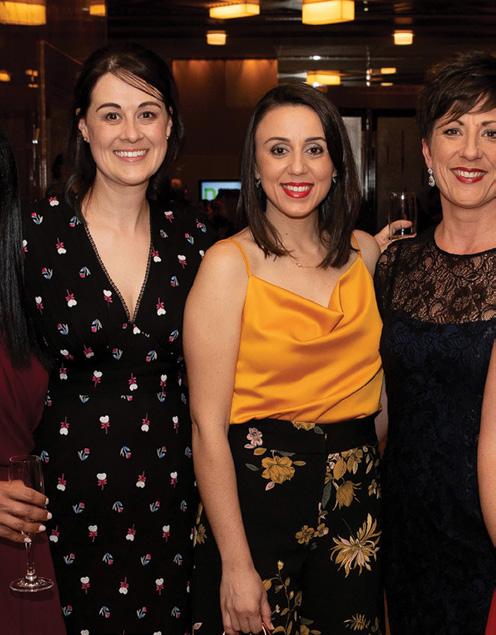
Australia has pulled through a global pandemic and construction is pushing on despite labour shortages and major supply chain issues. Builders and subcontractors everywhere are desperately trying to find more staff in order to keep up with the huge demand of work. While the numbers of women taking on construction roles is increasing, until significant changes are made in workplace and industry culture and equal opportunities, the number of women leaving the industry will also continue to increase leaving us in the exact same position. Some businesses are setting a fantastic example and implementing great initiatives and making a real change to culture, recruitment and paid parental leave. It is my hope that by sharing knowledge, experiences and stories of resilience and success between organisations and businesses, more progress will continue to be made.
According to the ABS in 2022 13% of the construction industry are female identifying; 11% in managerial, professional services and admin, only a staggering 2% in trades. There is much work to be done with both industry and government to achieve our goal of 25% participation by 2025.
At the start of 2020 NAWIC was able to partner with the University of Queensland Business School and the Australian Gender Equality Council (AGEC) to conduct a nationwide survey to determine how this pandemic impacted the people of Australia. The report, which was published this year, makes 13 recommendations which include more accessible early childcare, flexible and hybrid working, mental health support, parental leave entitlements and addressing gender role stereotypes. When implemented, the recommendations will help to rectify the impacts of the pandemic and eliminate gender imbalances to create more equitable culture that will only aid to strengthen the entire country going forward.
In early 2022, NAWIC launched its own survey to see what the pressure points are for women in construction. The survey revealed that 82% of participants strongly agree or agree that the role of women in construction is changing for the better. 73% strongly agree or agree that they feel respected and valued as much as their colleagues. Whilst these figures are a step in the right direction, there is still a long way to go for women in the construction industry. 48% of participants stated they have received inappropriate or unwanted attention from colleagues during their career and 73% have experienced gender-based adversity within their construction career.
NAWIC membership is now sitting at over 9,000 members in Australia. I feel so honoured to be part of an association that is full of individuals and organisations who want to improve the culture of construction. Without the hard work of our members and volunteers NAWIC would not be what it is today and we definitely would not be able to continue to push forward in
changing our industry. Thank you to everyone for their contribution no matter how big or small.
With the addition of 5 new directors to the NAWIC Board at the 2021 NAWIC AGM there has been an incredible amount of momentum and drive with many new national initiatives being able to be rolled out with the assistance of our national team as they also support the ever growing chapters. I would like to take this opportunity to thank outgoing directors Kristine Scheul and Miriam D’Souza for their dedication to NAWIC not only at Board level over the last 5 years but also for the many years of hard work as volunteers at chapter level. You are both passionate advocates for women in construction and your push for an equitable industry is tremendous.
Through our three key pillars, advocacy, education, community and connections, NAWIC strives to support all women in construction from tradespeople on the tools every day to project managers trying to deliver projects, construction lawyers negotiating complicated contracts, general managers looking ahead at the challenges within their business and young undergraduate students who may feel overwhelmed by their choice to join the construction industry.
We all know the challenges of the construction industry, and yet despite this, I have met so many people who just love being part of construction, myself included. I would never take back my decision to be a part of this industry. Working as a team, knowing the ins and outs of a project that the general public will never get to experience and being able to walk past a job and say, I was part of that, brings me so much joy. I hope that we will all be able to share our love of the industry with many more young women and men as the industry continues to grow and become more flexible, inclusive, supportive and in line with the times.
The general sentiment of the construction industry is that we know what needs to happen. We know the stats and figures and we know that making these changes will not only help to make construction better for women but it will also improve conditions for everyone involved in the industry. The time for talking is over. It is time to take action and to rise together!
Chair Person, NAWIC
THE NAWIC JOURNAL 2022
Christina
Yiakkoupis
GENERAL MANAGER’S FOREWORD
As I reflect on this year’s achievements and progress I am filled with happiness and pride. The last year saw our biggest membership growth in 27 years. NAWIC proudly represented over 7,000 individual members and 200 corporate members during the FY21/22. To our new and returning members a very warm and heartfelt welcome. Without the support of our members, sponsors, dedicated volunteers and our wonderful staff, NAWIC would cease to exist.
We have had some significant changes over the past year that has aided our continued success. The launch and implementation of our new membership & pricing structure was a huge task and I would like to thank all involved in the membership change. A lot of consultation and work went into the planning, together with a significant software deployment to allow this change to occur. Another significant project was the introduction of a new organisational structure that enabled NAWIC to hire internal staff to support our volunteers and membership base operationally. We are extremely proud of the work being done by the operations team and are excited about the future growth of the association.
Many of you will be familiar with our mission for #25by2025. I recall sitting in the strategy meeting, where 25% of women in construction by 2025 was born and feeling a sense of pride that NAWIC would set the tone and goal for the construction industry. We know that real cultural change happens when female representation exceeds 30% in any given organization. Currently we are sitting at an average 13% in Australia and we know that striving for 25% seems like a huge task. If we work together as an industry and all do our part in achieving this goal the target will become achievable. We all need to
commit to achieving more equality, inclusion and diversity in the construction industry, as well as changing the culture that currently taints the industry and leads to a leaky pipeline. By removing the entrenched cultural barriers through programs such as our Male Allies, it will improve the perception of the industry encouraging more young females to enter and remain in the industry.
Through the work of our amazing volunteers NAWIC held over 160 events which welcomed over 7,000 guests and awarded 75 wonderful people who are excelling in their field of work. Congratulations to all our nominees and award winners. We are extremely proud to have awarded over $60,000 in scholarships and grants nationally and donated over $19,000 to various charities throughout the year.
We are looking forward to another huge year and I am confident that we will build a better industry by working together. #werisetogether
Lauren Fahey
General Manager, NAWIC

5 THE NAWIC JOURNAL 2022
COMMISSIONER’S FOREWORD

As the first Public Sector Gender Equality Commissioner for Victoria – and indeed, Australia – I’m pleased to provide this foreword for NAWIC’s journal.
As Commissioner, I am responsible for overseeing the implementation of the Gender Equality Act 2020 and I also play a key leadership role in promoting gender equality in Victorian workplaces and communities. The Act is the first of its kind in Australia and is recognised globally as leading gender equality legislation. It applies to over 300 Victorian public sector organisations that have 50 or more employees, including universities and local councils (a total of approximately 450,000 workers or 12% of Victoria’s workforce).
Earlier this year, my Commission released a baseline data report, as well as an insights portal, which published the workplace gender audit data and Gender Equality Action Plans of all organisations covered by the legislation. Each organisation must report on their progress towards gender equality to me every two years, ensuring organisations are kept accountable for achieving gender equality in their workplaces. This level of transparency, along with regular public reporting and strong compliance powers for me as Commissioner demonstrates that gender equality is no longer a ‘nice to have’ – it’s a must have. It is already spurring workplaces to take purposeful action towards achieving gender equal workplaces.
However, there is much more work to be done to achieve gender equality in Victoria, and Australia more broadly. Gender equality makes industries and workplaces strongerand it’s time for the construction industry to catch up.
The construction industry is the largest gender segregated, male-dominated workforce in Australia.1
Part of the reason for this is the prevalence of outdated gender stereotypes about what men and women are capable of, as well as the industry’s rigid work practices, and the way hours and pay fit in a ‘male = breadwinner’ model that fails to accommodate the family needs of all employees. Gender equality in the construction sector is also undermined by sexist workplace cultures with limited accountability or deterrents for inappropriate behaviour by men, as well as occupational health and safety hazards for women, including gender-based violence2, inappropriate equipment and clothing, and a lack of adequate bathroom facilities.
Gender equality will strengthen the construction industry. It will unlock access to a larger portion of the labour force, leading to productivity gains and addressing chronic labour shortages. This will also reduce workforce gender segregation, improve women’s (and their families’) economic security, and contribute to closing the gender pay gap. Employing more women can also have positive impacts on workplace mental health through challenging the macho culture in the industry, especially around bullying.3
Recognising the issue of gender inequality in construction, the Victorian Government launched the Building Equality Policy in early 2022. My Commission has played a part in implementing this policy, which applies to all government construction projects over the value of $20 million. It seeks to disrupt the existing stereotypes, norms and roles in the industry by setting targets for women in management, trade, nontrade, and apprentice roles to attract, recruit, retain women in the construction industry. It also requires organisations and project teams to collect gender data and develop plans to improve gender equality within head offices and on site. Although this data will not be made public, it’s an important first step in helping organisations and on-site projects understand their gender gaps.
The NAWIC Journal 2022 focuses on innovative ways in which gender equality and the empowerment of women have been advanced in the construction industry over the past 26 years. It features industry news, profiles of key players in the sector, inspirational women, companies leading change and academic research. I congratulate NAWIC for its continued advocacy and action to promote gender equality in the construction industry. I also want to use this opportunity to call for much more innovative and radical action from the industry to achieve gender diversity and equality. It’ll be good for business, the economy, and for everyone working in the sector – and it’s about time.
 Dr Niki Vincent Public Sector Gender Equality Commissioner, Victoria
Dr Niki Vincent Public Sector Gender Equality Commissioner, Victoria
6
1
2
Victoria,
December
Industrial Relations Victoria, Victoria’s Women in Construction Strategy, Industrial Relations Victoria, 2022, accessed 2 December 2022.
Industrial Relations Victoria, Victoria’s Women in Construction Strategy, Industrial Relations
2022, accessed 2
2022. 3 S Holdsworth et al., Women in Construction: Exploring the Barriers and Supportive Enablers of Wellbeing in the Workplace, Royal Melbourne Institute of Technology (RMIT), 2020, accessed 2 December 2022.
THE NAWIC JOURNAL 2022
ACTION FROM ADVERSITY
NAWIC’s International Women’s Day Scholarship 2022 Winner – Gabrielle French
The most valuable of information available to those who wish to make change is the lived experience of those who have endured the status quo that needs addressing; specifically that of the bold female tradies who have done the hard yards, navigated difficult territory, often at great personal expense, and have succeeded despite unfathomable obstacles. It was that lived experience of Gaby French that has driven her to embark on a journey of awareness-raising and change-seeking at a time that, whilst we seem to have come so far, we really do have a long, long way to go.
Gaby is winner of The National Association of Women in Constructions (NAWIC) 2022 International Women’s Day Scholarship and is using this opportunity to shed a crucial light on her experiences, to take her findings far and wide to enact much needed change.
It’s been only two months now that I’ve been working for BUSY Sisters Mentoring Program. In that short time, I’ve heard a vast spectrum of experiences from women working in male dominated areas. Whilst it’s been heartening to hear how well some of our apprentices are doing and just how much they love the work, it has also become obvious why organisations like BUSY Sisters have come about.
To get a clearer picture of the female apprentice’s experience, I began to join Facebook groups set up to support them. It is apparent that the number of these has grown and is still growing as women attempt to fill the gap in support available, or just share their experiences for the benefit of their peers. It was while browsing one of these pages that I came across Gaby’s research. Here was someone cutting through to the real issues and seeking to make changes in our industries that, up until now, have been just too slow in coming.
Gaby made a career change decision after age 40 and enthusiastically headed into a new trade only to find that her recruitment had been purely designed to secure a tender, ticking the ‘female’ box for the contract, but the company providing her with no support, no one to train her, or even an actual job to do. Her attempts at being useful saw her branded as burdensome, and ‘difficult to work with.’ Her mental health took a serious downturn. What followed was a series of inexplicable, inexcusable experiences, from serious breaches of confidentiality with the EAP provider, indecent
exposure from management, gaslighting, bullying and harassment; all documented, demonstrable, and undeniable. And all while watching her fellow young male apprentices being appropriately fit out for the job with vehicles, tools, proper training, and a pat on the back.
Gaby was already an incredibly accomplished woman, with a whole other successful career behind her, as well as a Bachelor of Psychology to her name. She couldn’t imagine what it would have been like for a young apprentice fresh out of school to endure this sort of treatment, considering how it nearly killed her; and she was a mature aged, educated and had considerable life experience.
Gaby is now taking what didn’t kill her and making herself and others stronger for it. Her story does not dance about difficult subject matter but outlines with brutal honesty what she has endured and uses it to pose direct and specific changes where women and apprenticeships are involved.
Some of the areas in which Gaby seeks to affect change are:
⋅ Psychological wellbeing for women in light of the isolation experienced in male dominated workplaces.
⋅ Attitudes and assumptions about women’s abilities and those about mature aged apprentices.
⋅ The role of RTO’s in completion rates of qualifications for females during their apprenticeships and the profile of those teaching them, with a view to improve gender diversity.
⋅ The role that the apprenticeship support organisations play in assisting specifically female apprentices and their obligations regarding WHS in this matter. Balancing the relationship with the employer, with meeting the needs of the apprentice.
⋅ The rights and recourse of an apprentice if their employer is not fulfilling their training obligations.
⋅ The experience of female apprentices taken on to meet tender obligations, and the negative impact on these apprentices once the contract has been met.
⋅ The practical side of employing and supporting women in workplaces such as appropriate toilets, sanitary bins, suitable PPE etc.
7 THE NAWIC JOURNAL 2022
Gaby is not alone in the experiences which put her at risk of serious psychological harm, not to mention potentially leaving her in a professional wasteland. She is not the first, and won’t be the last, unfortunately, but she is to be applauded for having the strength to take them and use them as a tool for progress.
With resolute determination, Gaby completed her apprenticeship and now also works tirelessly as an advocate for women in the trades as the founder of Aussie Girls on the Tools. She knows only too well that this sort of cultural change is slow and difficult and takes the commitment of everyone involved in the workplace. It’s well past time that increased female participation in industry is understood as the solution to many a problem, such as skills shortages, rather than a novel inconvenience or the ticking of a gender equality box on a tender. From the day-to-day language we employ to the imagery used in marketing, it is all important and plays a role in moving forward.
Gaby will soon evaluate the surveys, interviews and other data gathered, to take forward nationally to obtain a grant to implement a range of related actions. It is anticipated that this body of research is going to be a significant contribution to breaking the bias surrounding women in male dominated roles and will be a huge step towards some ambitious, but surely achievable goals. Specifically improving the experience of women choosing opportunities that should be freely available to them, educating and changing the attitudes that shape the problem behaviours towards them, and achieving 25% participation of women in these industries by 2025!
Caroline Miall Mentor, BUSY Sisters
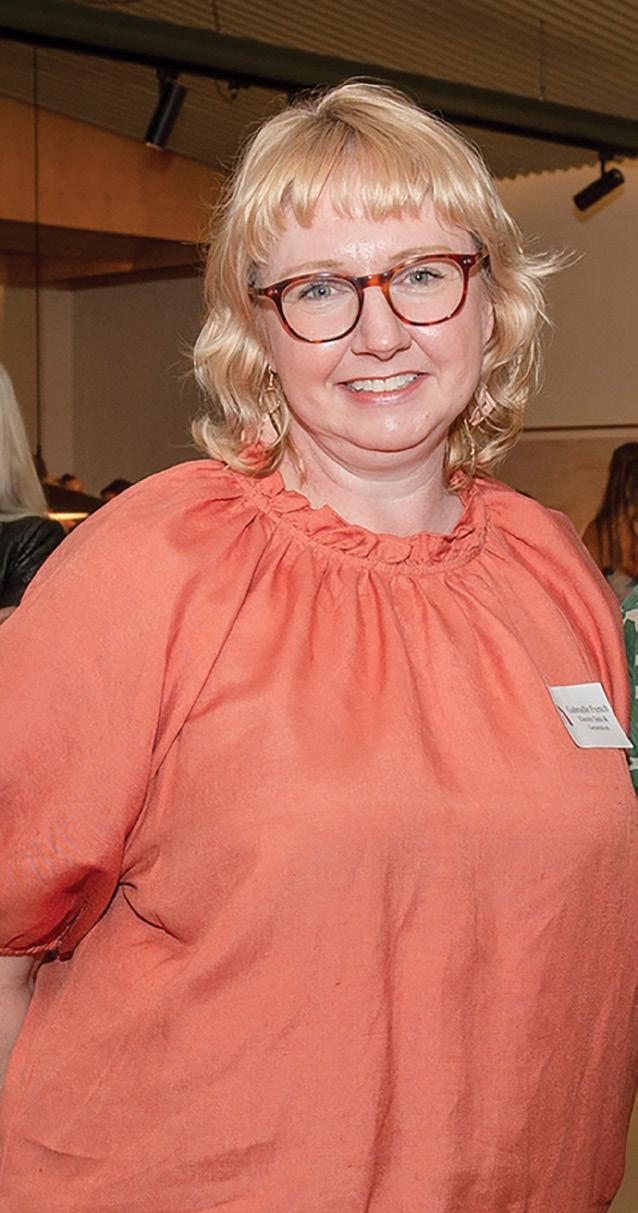
8 THE NAWIC JOURNAL 2022
NAWIC’s International Women’s Day Scholarship 2022 Winner, Gabrielle French
AMY’S BRIGHT IDEA
2021 Bright Idea Scholarship Winner Amy Chapple Shares With Us Her Journey So Far
Amy Chapple is the 2021 Bright Ideas Grant Scholarship recipient for Hats Off 4 Change (HO4C) “Hard hats with a difference”
The first company of its kind in Australia; HO4C is the onestop-shop for hard hats, working responsibly to design, manufacture, supply and recycle hard hats.
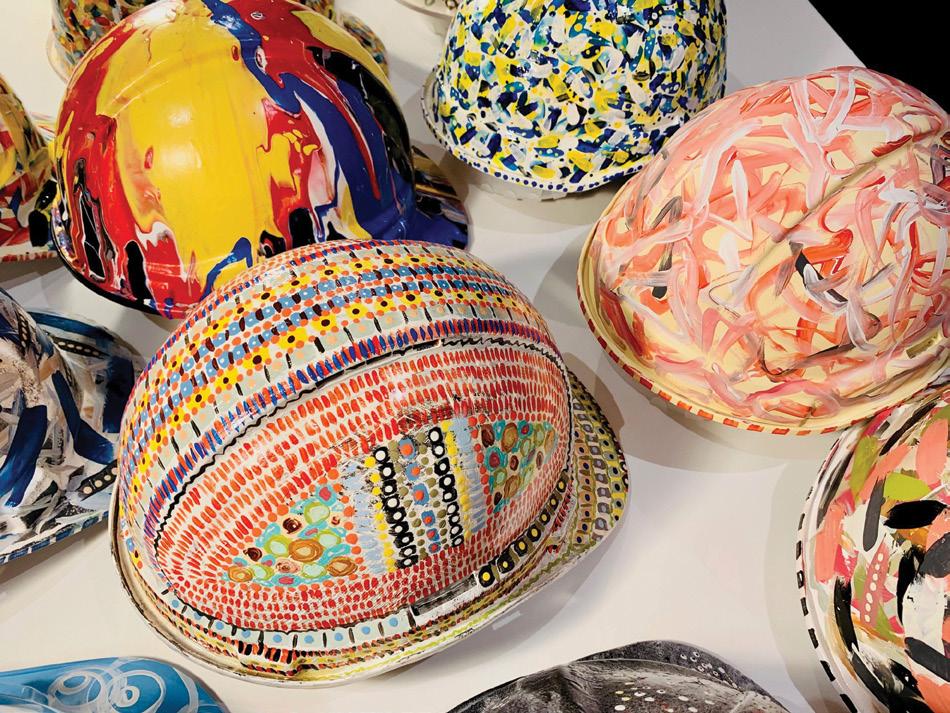
HO4C was inspired by four areas of passion for Amy:
⋅ Painting, art and design
⋅ Protecting our environment
⋅ A desire to understand and celebrate our First Nations’ people’s culture and history
⋅ Visiting and working in the Pilbara region of WA
As the saying goes “a picture can tell a thousand words”. For centuries First Nations have used art and painting as their tool to connect and convey culture. HO4C was inspired by our 500 different Aboriginal peoples in Australia, each with their own language, stories and customs. Amy believes respectful communication and listening create the framework for successful collaboration and art is the universal language to connect people. HO4C was a way to connect my passions with purpose, break barriers and start conversations, tell stories, and protect people and respect others. Amy wants people and businesses to have the freedom to express their values, communicate purpose and be heard. With HO4C, we can be safer, respectful and make a difference.
9 THE NAWIC JOURNAL 2022
HO4C produces high quality, safe and locally sourced and manufactured hats to meet all PPE requirements. Amy believes PPE should not only be about personal safety, but also respecting our People, Place of work and the Environment:
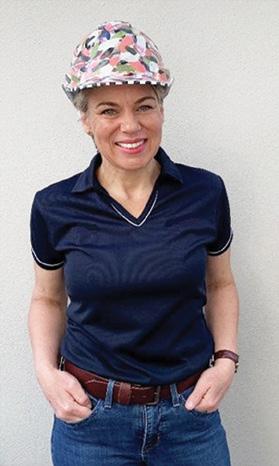
⋅ Place specific, contextual, respectful of Traditional owner lands, customs and heritage
⋅ People informed, aware and notified to “inspect, replace and recycle” (within 3 years)
⋅ Environment preservation, landfill reduction and HO4C recycling program
HO4C is committed to reducing landfill and believe product stewardship, corporate social responsibility and supporting a circular economy. Construction and demolition waste account for 44% of all landfill waste. In 2021, global hard hat sales totalled $6.1b (AUD)*, with $35 the average price per helmet with a company logo. Market predictions have this set to increase to $11.3b AUD 2030 (Grandview Research 2021).

With a maximum safety lifespan of three years that’s a lot of helmets going to landfill. Amy is hoping HO4C can address these safety and environmental issues.
“Buy Local” and “Close the Gap” policies ensure HO4C source Australian made products and supports AIPP committed suppliers and artists. This is not about taking, it’s about giving back, to communities, to educating future generations, to the environment.
HO4C is exploring other avenues to raise awareness of safety, promoting charities, emerging Australian artists from non-indigenous backgrounds, a “Lids 4 Kids” school program providing the opportunity to “paint their own Lid”. The ultimate goal is to develop the technology to make a new HO4C hat from recycled HO4C hats.
HO4C hats not only stand out for safety, they are the voice to stand up for Change; reinterpreting traditional PPE acknowledging the importance of People, our Place of work and the Environment.
Let’s collectively “take our hats off” for our people, our planet and for change. For further information about Hats Off 4 Change, contact Amy Chapple E: amy@hatsoff4change.com M: 0450 587 252

10
Amy Chapple
MENTAL HEALTH & PREVENTION OF SUICIDE IDEATION
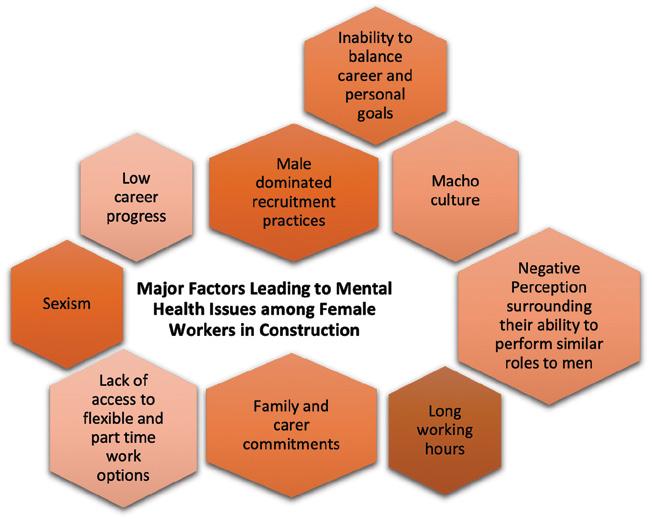
Among Female Workers Should Be an Industry Priority
The culture of the construction industry is dominated by traditionally held masculine ideologies such as stigma against seeking help for the risk of suicide and mental health problems. Construction workers are known to be at a greater risk of suicide than other occupational groups in Australia. The inability to balance work and personal needs can negatively influence wellbeing. Professor Sarah Payne working with other researchers highlights that the effects of working and living conditions on suicide may vary depending on gender. Research notes that female workers are more likely than male workers to report elevated rates of work-related stress and psychological injury arising from the unique challenges they face in the construction industry. As reported by the Australian Institute of Health and Welfare (AIHW), rates of suicide attempt and self-injury are higher for females than males. In 2019–2020, females accounted for almost two-thirds (63%) of intentional selfharm hospitalisations in Australia. According to AIHW, this may be partly due to differences between the methods used by males and females—with males tending to use more lethal methods than females.
Women Building Australia reports that in 2020, female workers accounted for 14% of the workforce in the building and construction industry in Australia: an increase from 11% in 2019. Although considerable effort has been made to attract women to the construction industry, they face many unfavourable conditions. Dr Adedeji Afolabi and a group researchers indicate that the major issues faced by female workers in construction industry include long working hours, family and carer commitments, lack of access to flexible and part-time work options, male dominated recruitment practices and the negative perception surrounding their ability to perform similar roles to men. In addition, antifeminine characteristics in the construction workplace persist, including a macho culture, sexism, difficult conditions for balancing career and personal

goals, intolerable working conditions, low career progress and expectations of mimicking male aggressive behaviour. In addition, the demanding work environment in construction has considerable potential to have a negative effect on every workers’ non-work lives. The Women in Construction Strategy of the Victorian Government also notes many of these factors as negatively affecting the physical and mental health of women in construction.
Dr Jacqueline H Watts indicates that high levels of depression, anxiety, stress and burnout among construction workers are driven by construction workplace characteristics such as the conflict-ridden, ‘dog-eat-dog’ work environment and the culture of blame. The effects of these
11 THE NAWIC JOURNAL 2022
MAJOR FACTORS LEADING TO MENTAL HEALTH ISSUES AMONG FEMALE WORKERS IN CONSTRUCTION
characteristics can be exacerbated by non-work-related factors including low socio-economic status, marital status and associated issues and can lead to detrimental outcomes for the mental wellbeing of workers. In addition, site-based construction work is physically demanding and is associated with inherent risks that are also detrimental to workers’ physical and mental wellbeing. The many characteristics of the construction industry that can lead to poor mental health outcomes means it is necessary to address suicide prevention in the industry at the primary level, which includes reducing the risk factors of suicide. MATES in Construction highlights that suicidal ideation, which refers to having thoughts about suicide, also requires intervention because it is associated with substantial psychological distress and is a likely predictor of later suicide attempts and death by suicide.
Despite a plethora of research into the occurrence of suicide in the construction industry, very little research has been conducted focusing on female workers and the unique risks that they face in the industry and the preventive factors that could help them. A ‘one size fits all’ approach to managing work–life balance for construction workers has limitations. Professor Payne working with a group of researchers highlights the importance of having gender-sensitive suicide prevention strategies because a gendered perspective will create understanding of suicide mortality in men and women. Thus, the association of these risk factors with the suicide ideation of female workers in the construction industry requires further research accompanied by more initiatives at the policy level and at the work site level.
A team of researchers from the University of South Australia led by Associate Professor Rameez Rameezdeen aims to investigate work-related and non-work-related suicide risk, as well as protective factors related to female workers in construction, in order to develop strategies to reduce the harmful effects of those factors that result in suicide ideation among those female workers. This project is a collaboration with MATES in Construction South Australia and is funded by the same university.
The project aims to have three major outcomes to help solve this issue. The first outcome is to explicate what constitutes suicide behaviour and the process of suicide prevention tailored to female workers in the construction industry. This outcome will highlight the importance of broadening current conceptualisations of construction
industry suicides within public policies from that of a male perspective to one that includes individuals who identify as female. The second outcome of the research is an analysis of the work-related and non-work-related drivers of suicide risk and protective factors, and their association with suicide ideation of female workers. The research will bring forward drivers of suicide risk and potential protective factors, as identified by female workers. This outcome should create understanding in decision makers such as employers and managers at the work site level to enable them to provide customised support to female workers by addressing the suicide risk factors and utilising the protective factors in their project planning and implementation. The third outcome is to provide recommendations on specific strategies to reduce the harmful effects of work-related and non-workrelated factors that contribute to suicide ideation and to improve the mental health of female construction workers. The strategic directions generated by this research could uplift the collective effort of the entire industry in developing suicide prevention programmes customised for females. These programmes should be made available to female construction workers in recognition of the growing evidence that they are suffering from mental health issues. Eventually, improved work conditions will encourage and inspire new female entrants into the construction industry. This will result in more female students entering construction-related higher education programmes that will attract, motivate and retain a diverse workforce in the construction industry.
12 THE NAWIC JOURNAL 2022
Lecturer, UniSA STEM, University of South Australia
Dr Aparna Samaraweera
Doctoral Researcher, UniSA STEM, University of South Australia
Shanika Vidana Gamage
A/Prof
Associate Professor, UniSA STEM, University of South Australia
Rameez Rameezdeen
WINGS TO FLY
An Interview with Isha & Salonee Sarnaik
Twin Sisters Isha Sarnaik and Salonee Sarnaik were still only in their formative years when their Uncle, Unmesh Gaidhani, an Engineer, would take them to construction sites in their home town of Mumbai. It was during these excursions that they developed a keen interest in construction. We spoke with them about how their career has brought them to Australia and how their roles fuel their desire to be changemakers, for women, for the industry and the betterment of society.
Engineering isn’t a traditional career option for women, particularly in your hometown of Mumbai. Tell us about your journey.
Since we were young we both knew Engineering was exactly what we wanted to do. Studying for our Bachelor’s Degree many people said ‘why don’t you study what arts or teaching or something else’. We were the only two girls in our batch doing Engineering at the time.
There’s a perception that because we are girls that we’ll become family orientated; that girls can have a career or family, but not both. This is simply untrue. We can do it all and better. Our family is very progressive and keenly dismissed people who suggested our parents were wasting money on our education.
Our Grandfather stood up for us. He said they we can study as much and for as long as we want. He is values education. We have Aunties who are lawyers and pilots. We were lucky to have women who are independent to look up to.
Our Dad has said many times; “My duty is to support you and give you wings. Then you can fly wherever you want to”.
Why did you both chose to come to Australia?
The thing about Australia that was appealing was the quality of education. The double master’s degree offered by Griffith University is the only one of its kind enabling us to achieve a Master’s Civil Engineering and a Master’s in Construction Project Management. Studying here is far more practical than our studies in India, with more research and onsite opportunities.
Following on from your studies, where are you now?
Salonee: I’m with Fulton Hogan working on an amazing project in Hobart Mediv Midway Point. The project has now achieved practical completion with an iconic finish proving to be one of the attractions of Midway Point in Tasmania. In
Tas Fulton Hogan I am only female engineer. We also have two female undergraduates, and everyone is very glad to have them.
Isha: I’m with Dalton Consulting Engineers working in design for land development and infrastructure. Currently I am engaged in a residential subdivision which is a decade long development.
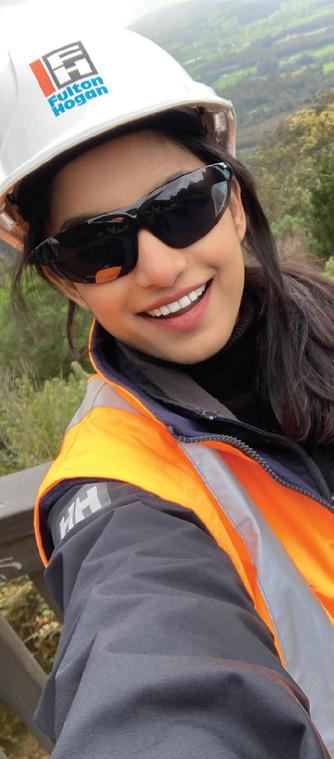
And specifically, in your respective workplaces, you were both taken on as part graduate programs. Tell us a little about how that works?
Isha: I was assigned a mentor from the start. I chat with him, he’s senior to me and been through the same things recently. I have someone to ask ‘how did you overcome this’ and work through the solution together.
Salonee: I was assigned a mentor and as well as a buddy. I feel free to ask any time of questions. Just recently he spent 2 hours with me explaining something I asked about in detail, until I felt confident and understood. It’s so supportive. I personally feel like I have learned so much working with my mentor.
My Buddy is from the graduate program, just one year ahead of me. He knows exactly knows what stage we are in and what we know in terms of our practical systems. I feel free to talk and ask whatever I need. It’s quite empowering
And what has been your experience working as a female in the male dominated construction Industry?
We’ve has an amazing experience. Initially we were really scared as we’d heard about how our voices wouldn’t be heard. However, we’ve both been really welcomed from day one and feel our opinion is heard. It is male dominated but we feel just as equal as our male colleagues.
13 THE NAWIC JOURNAL 2022
In your experience what improvements could be made in the industry for women?

We have observed that there could be times where the site compound may not necessarily be fully equipped for women, such as having proper dedicated female toilets, having sanitary bins in place, or having a separate change/wash area etc. Although this has been implemented on most of the sites that we have worked on, we believe, a conscious effort should be made to equip every site compound on construction sites suitable for females. This will not only guarantee that women feel safe & comfortable on-site but will also motivate and encourage more women to consider a career in construction. It’s all about the efforts put in by everyone to work towards building a better narrative for women in construction. Building a better future for the construction industry.
Where will your wings take you next do you think?
Salonee: Along with achieving a dynamic career in Civil Engineering, I aim to construct sustainable & environmentally friendly structures. This comes from my experience in construction that has made me realize how vital it is to care for and preserve our environment without causing it harm. I believe that it is just as important to build environmentally safe structures as it is to build structurally safe structures. After all, the future is green engineering.

Isha: I would like to see more renewable energy incorporated in infrastructure and design, like eliminating the use of gas and using biogas or geothermal energy instead. This is not only just good for the planet but is also cost efficient in the long run. My goal is to spread awareness about new energy resources and renewable energy and educate as many people as possible about the many benefits of using these.
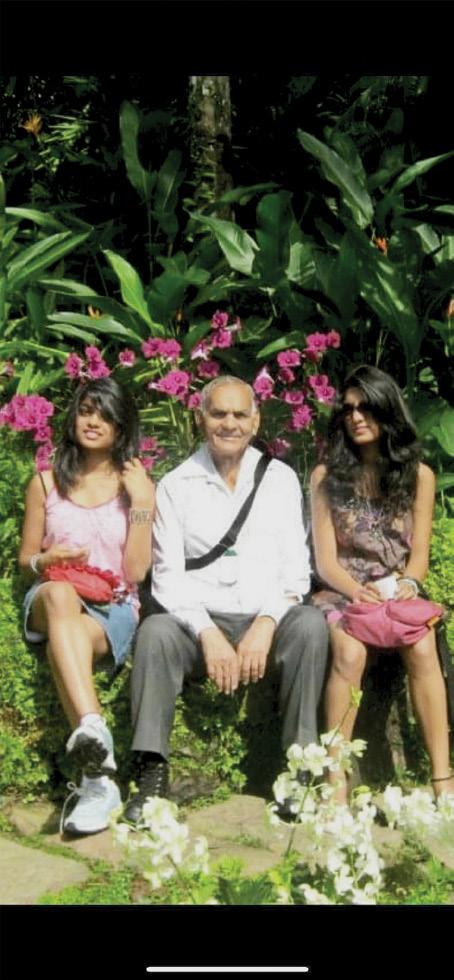
14 THE NAWIC JOURNAL 2022
DIVERSITY & INCLUSION
Let’s Stand Together & Call It Out to Create Change
was 14 years old when I first became aware that some people might treat me differently because of the colour
In a small town in south-east England, as I walked to the bus stop after school with my friends, I found myself surrounded by a crowd of older kids from another school.
A girl who I now know is called Sam, took two steps towards me and said:
“Why don’t you piss off back to your Arab land”
And then she punched me in the face.
My world slowed down. What was probably just a matter of seconds felt like an hour. Other than a few sniggers, nobody did anything.
Feelings of shame, humiliation and rejection intensified as the circle of witnesses dispersed, and I walked towards my bus trying desperately not to cry. I felt like everyone was watching me, but I had never felt more alone. It hit me like a second punch.
That evening, when my mother drove like a banshee to Sam’s school and marched into the head teacher’s office, there was no doubt in my mind, my mother’s, or the head teacher’s that I had been the victim of a racist act.
That punch paired with those words was clear cut. I will keep the trauma with me always, but I got empathy, action and a kind of closure.
Not-so-micro-inequalities
But what about when it’s not so obvious? When the discriminatory acts are small, or subtle, or gray?
These are labelled ‘micro inequalities’, or when related to race or ethnicity, they are collected into the term, ‘casual racism’. Both terms are used to define seemingly small acts that can make someone feel singled-out, unwelcome or unworthy.
In the workplace, casual racism might look something look like this:
⋅ Assuming that a black employee is of a lesser employment status.
⋅ Commenting on how well a person of colour speaks English.
⋅ Asking a black woman if you can touch her hair, or touching it without asking.
⋅ Asking a person of colour where they’re really from.
⋅ Using a derogatory term in a “joking” manner.
“Just like other forms of racism, casual racism can marginalise, denigrate or humiliate those who experience it. Harm can occur even if conduct isn’t motivated by hate or malice [..] because racism is as much about impact as it is about intention”.
Dr. Tim Soutphommasane
For a person of colour, it doesn’t feel casual or small. These moments provide us with a stark reminder of our hypervisibility in a workplace where there aren’t many people that look like us.
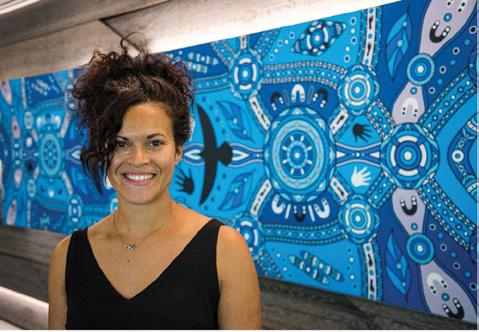
And then when somehow nobody sees it or calls it out, we feel the sting of the second punch.
Silent witness
Thomas Vance, a counsellor and postdoctoral psychology fellow at the New School for Social Research in New York calls this phenomenon, in which no one in a group of witnesses chooses to call out or disrupt a problematic event, the bystander effect
Though there might be something in your gut that’s telling you something isn’t right, “the greater the number of people present, the less likely people are to help a person in need or distress […] because being part of a large crowd makes it so no single person has to take responsibility for an action.” NY Times
When it comes to racism, casual or otherwise, being silently anti-racist is not enough. We need to speak up
15 THE NAWIC JOURNAL 2022
Lisa Hogben
Get uncomfortable
Whether you are a person of colour on the receiving end of casual racism, or somebody witnessing it, it’s time for us all to get comfortable being uncomfortable.
Yemi Penn, an Author, Speaker and Thought Leader specialising in diversity, inclusion and trauma, talks about the need to give language to convey the impact and depth of casual racism incidents to help people understand and reflect on their action or inaction.
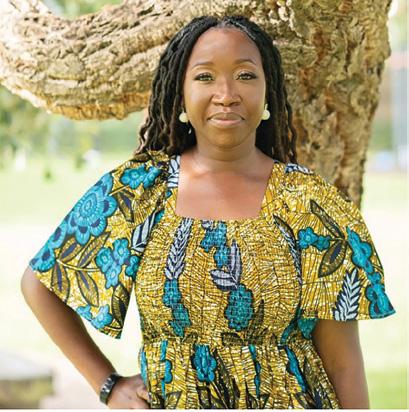
“It’s hard and it hurts to do it, but if we don’t find the words, change will be slower to come.”
Actions matter, and we can take courage and instruction from active bystander techniques, which encourage disruptive action from witnesses in the face of discriminatory acts:
⋅ Distract: Attempt to diffuse the situation or divert attention by changing the subject or perhaps ‘accidentally’ dropping something.
⋅ Delegate: Escalate the matter to a manager or colleague who might be better-placed or more able to give the feedback than you are.
⋅ Document: If someone else has stepped in and behaviour is escalating, take notes to record the situation.
⋅ Delay: Speak to the victim after the incident and make sure they’re OK.
⋅ Direct: Speak up in the moment to directly intervene by calling out the words or behaviour of the perpetrator.
It’s going to feel really uncomfortable. But remember that whatever discomfort you might feel stepping in as an active bystander, the person on the receiving end of the discriminatory behaviours is feeling a lot worse.
Taking action demonstrates solidarity. It tells the victim that they are welcome and valued here, and that what’s just happened is not OK.
It won’t take away the harm, but it will provide empathy, action and a kind of closure.
Take care of yourself
According to Women of Colour Australia (WoCA), six out of ten women of colour have experienced discrimination at work, despite the majority (59%) of companies having a diversity policy in place.
If you fall into that 60%, Siti Mustaffa, a Mechanical Engineer and NAWIC ACT committee member, can empathise, and wants you to know that you are not alone.

“Recount the experience to a trusted colleague and tell them how it made you feel. Consider if you feel safe, if you think you will be OK to continue your work, or if you need to step away. If you need their company for a little longer, that’s OK too.”
Remember that it is not your responsibility to educate the perpetrator, nor is it your job to decide what should be done about it if/once you’ve reported it.
But if you think you can, the NAWIC family stands with you as you bravely turn that lived experience into meaningful change.
We see you, we care, and we pledge to take action
16 THE NAWIC JOURNAL 2022
Lisa Hogben
Yemi Penn, Author, Speaker and Thought Leader
Siti Mustaffa, Mechanical Engineer and NAWIC ACT committee member
AN INTERVIEW WITH ROBYN LOWE
Electrical Trades Teacher, Mentor, NAWIC Member and D&I Advocate
Continual learning is a hallmark of your career. Tell us about your where you began and where you are now.
Started my apprenticeship after year 10 then went on to do industrial electronics. During this time was in the Army reserves and moved up to foreperson then manager of an electrical company. Later changing to IT from my programming experience with PLCs. I trained as a Web Application Programmer, then moved up to IT manager, eventually running my own IT company doing bespoke Web Applications. Got back into the electrical trade after my children finished school as a Project Manager on electrical industrial/commercial sites, and now teaching electrical apprentices & the Electrical Contracting Certificate.
I have a broad spectrum of skills that are a perfect fit for my current role as VET Lecturer and Workplace Assessor – Electrotechnology.
I am continuing my journey as a student doing a Bachelor of Adult and Vocational Education, wanting to improve my delivery and design skills for students.
You identify as a Transgender Woman and chose to be an advocate for empowerment and change in the construction industry. Tell us about this.
Yes, I am a Transgender Woman and an educator in Electrical trades. I recognise who I am and how I present to society. In my life, there is love and acceptance, tolerance and indifference and scorn.
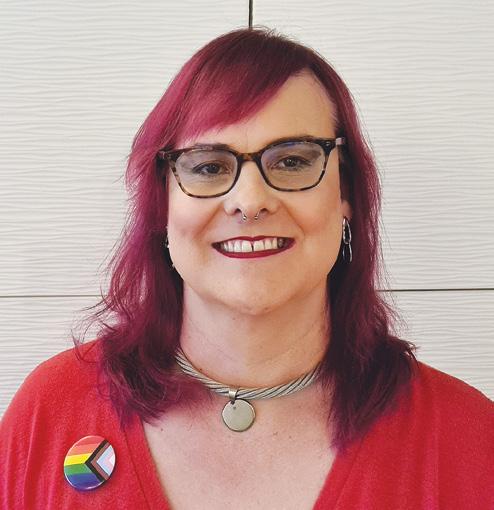
As an educator and a tradesperson, I feel I must be active in the Electrical and the broader community. For the current and next generations, I chose to be visible, to be present. I advocate for those who choose to express their true self or who are questioning themselves.
At the heart of the construction industry there is continual change. Change can happen, it’s one of life’s few constants. In the construction industry we understand and adapt to change easily. Yet when it comes to social change and maybe our personal growth, why do we resist so much? Our brains get comfortable in routine, comfortable in recognisable patterns which become our daily norms. But we filter out and ignore what we think is not relevant to our personal narrative.
So how can we teach ourselves to readily accept the value of individuality that is different to the social construct?
What have you observed in your lived experience that can help us as an industry create change and see more acceptance?
I have had the personal experiences where individual’s social construct has been aimed at me. Seasoned trade professionals, whose job includes constant change, have said they’re too old to change or understand me. Learning and adapting is a personal choice. Saying no is just de-prioritising and devaluing that person to accommodate your internal narrative.
Many argue “If you haven’t learnt something new today, you’re not trying”.
The first step is accepting there is a societal problem.
Step two is we need to stop ignoring it. This is the hard one it takes strength to call someone out and go against the herd, you may become a target as well. However when speaking up becomes the norm, acceptance and diversity will become the norm too.
17 THE NAWIC JOURNAL 2022
How does Diversity & Inclusion fit with teaching and mentoring?
Like a hand in a glove.
There is still a huge way to go to break the binary construct and normalise human diversity. Sharing my life experience and being visible is what I hope to contribute to our change journey. I articulate and welcome discussion with my students about D&I.
Diversity being how every person identifies with any variety of personal attributes and characteristics, and the respect for and appreciation of these qualities.
Inclusion refers to the ability and willingness of all people in the workplace to fully contribute, collaborate and be engaged with everyone.
Diversity and inclusion add knowledge and strength to society in all aspects of our lives.
What can we do differently moving forward?
EQUALITY is everyone getting a pair of shoes.
Being visibly inclusive creates big ripples; supporting those who need it most is crucial. No matter what you do in the construction industry we can all be respectful and inclusive, it takes no time and cost nothing.
DIVERSITY is everyone getting a different type of shoe EQUITY is everyone getting a pair of shoes that fits
ACCEPTANCE is understanding we all wear different kids of shoes INCLUSION & BELONGING is wearing the shoes you want without fear of judgment.
One great example of D&I Leadership is that of Virgin Atlantic. They lead their industry by enabling staff to choose the uniform which they feel most comfortable in. Virgin Atlantic also provide the option for employee’s to choose their preferred pronouns for their name badges. Applications increased by 100% since the announcement.
Whether you are an educator, parent, mentor and/or leader, exposing the next generation to the world in all its beautiful diversity in positive way is invaluable, especially at an early age. An Ally is someone who stands up for, supports and encourages the people around them. It’s a term that gets used a lot in the LGBTQIA+ community and focuses on celebrating diversity and ensuring all people are safe to be there true selves. We can all be an Ally.
I am sure you have experienced it; actions matter and your actions matter. An employee or colleague who feels safe and part of the team is empowering and brings immense organisational value. By continuing to work together we can make our work and social lives welcoming and inclusive to all. We can share in the richness of knowledge and culture that social diversity has to offer.
18 THE NAWIC JOURNAL 2022
MALE ALLY
PPTEU 2022 Award Inspired by NAWIC
This year the Plumbing and Pipe Trades Employees Union (PPTEU) in QLD came up with the initiative to recognize a Male Ally within the Plumbing Industry. This award was inspired by the National Association of Women in Construction’s Male Ally program. The PPTEU has been working closely with NAWIC since January, with Rian Kelso the Apprentice Program and Project Manager joining the NAWIC Women on Tools Committee. The relationship between the two organisations has been one that has taken off with a bang. Plumbing being a Male dominated trade the Union has seen a small change in the uptake of females in their industry. They’ve identified that it is time to tackle the attraction and retention of women in their trades, targeting the cultural shift required to see improvements in this area.
Introducing the Male Ally Award at the 2022 PPTEU Awards was one of the initiatives Rian from the PPTEU felt would bring attention to the need for supportive and inclusive male allies to the forefront. Recognizing males that support women in trades, was step one for the PPTEU QLD, in the education piece for their domain. Damian O’Sullivan the recipient of the Male Ally Award 2022, has been a supporter of women in trades and continues to demonstrate his passion for change in this space. Damian currently works for Multiplex on Queens Wharf; he is also the president for the PPTEU QLD. Damian was nominated to be awarded the Male Ally 2022 due to his passion for standing up for women in

the workplace, his ongoing encouragement to women in leadership roles and the uptake of female apprentices within the Plumbing industry.
In a recent interview with Damian, he stated that he believes that training and education is the key to addressing the issues women face with working in the construction industry. Understanding what women face in the construction industry and then how to work with women in their very male dominated environment is key to the culture shift that is required to retain, attract and support women in construction industry. Damian shared insight about his own bias around women being able to be plumbers when he was younger. At the beginning of his trade as an apprentice, he was faced with his bias. A young women did her apprenticeship with Damian at TAFE, he was in the same class as her and happened to work in the same location up in Redcliffe. During their time at trade school there were many manual tasks that were required, one of which was to bend copper pipe. During this class, Damian could see his fellow female apprentice struggling with the task. She asked him if he would assist her to bend the copper pipe as she felt she wasn’t strong enough. He was quite upfront with her and said, “If you can’t bend the pipe in here at trade school how do you think you can qualify for a plumber out in the real world?” to that she said, “If I can’t bend it myself, I will buy the bend, problem solved.” It was at this stage Damian realised that there is always more than one way to do a task or a job. In Damian’s words, “I was very quickly put back in my box.”
The PPTEU QLD is a huge supporter and advocate for women in trades, seeing the Male Allies Program as an opportunity to educate the industry. In Damian’s interview he stated, “There are so many barriers that have been faced for women in male dominated industries, I believe that one of the first steps for our industry to break the barriers is Education, communication, and collaboration. Educating the workforce is the first step in understanding the barriers, then working together
19 THE NAWIC JOURNAL 2022
Ruth Gunaseelan, Sheree Taylor, Rian Kelso, Carlie Low, Radmila Desic and Toni Hillman representing NAWIC at the PPTEU Awards.
to support each other to break through some of the mindsets around women working in the constructions industry. We have come along way from where we were, but there is still a fair way to go.”

The Unions play a big role in the mission to advocate for women in male dominated industries and their rights generally. The PPTEU have seen the need to push for more education in the space, through tool box talks with starting apprentice using the NAWIC Passport to Diversity at induction days, to the uptake of the Male Allies Program, with the hopes to roll this our in 2023 do Delegates, Members and Union Officials
across the state. Thank you to Damian O’Sullivan for making it his business to speak up and speak out for women’s rights, to encourage women in the Construction Industry and to see that more women and girls have opportunities to embrace careers in the Construction industry by breaking the bias, breaking down barriers and being proud to advocate for change.
Rian Kelso

THE NAWIC JOURNAL 2022
PPTEU State Secretary Gary O’Hallaran, NAWIC QLD President Sheree Taylor, PPTEU QLD President and Mzale Ally award recipient Damian O’Sullivan and the Hon Mick de Brenni, Minister for Energy and Public Works.
INFRASTRUCTURE PRODUCTIVITY IN AUSTRALIA IS DECLINING
– Here’s How to Turn It Around
Productivity in Australia’s infrastructure industry is declining while unfilled vacancies and candidate shortages continue to prevail.
The market is extremely competitive, with 31% of employers in October 2022 intending to increase their staffing levels over the following three months - an increase of 3% since the same time last year. Recruitment difficulty in Australia as of October 2022 sits at 70% - an increase of 16% since the same time last year.
It is no secret that candidates have a lot of power in these circumstances and our current default solution of offering high counteroffers is not sustainable.
Your company’s strongest asset for attracting talent will be its employer brand. Your company’s employer brand influences the idea people have of what it would be like to work at your company. Employer branding works very much like regular branding. How are you communicating your brand to others? What message about your brand is being spread through word-of-mouth?
From what people see about your brand to what they experience throughout the recruitment process and their experiences while they are employed with you, there are many touchpoints where you can have influence on what people think. Therefore, what you put out and what you do should be preceded by careful consideration of how you want to position your employer brand.
Assess your retention strategy
If salary is the only thing keeping your employees from leaving, you can bet another company will offer them a higher salary to take them from you.
Differentiate yourself from your competition by offering benefits that appeal to your employees and aligns with the nature of your business. Offering a paid day off to employees on their birthday is a common benefit but with tight deadlines, this might not be suitable for companies in this industry. Benefits you could consider include, and are not limited to:
⋅ Corporate health insurance
⋅ Free food
⋅ Subsidies for further study
⋅ Employee assistance programs
⋅ Subsidies for PPE
Apart from retaining employees, offering benefits will lead to a happier, more productive, and culturally supportive workforce.
Diversify your workforce and encourage inclusion
Equality, diversity, and inclusion are all proven precursors to innovation, high performance, and the cultivation of supportive work environments. Creative and critical thinking skills thrive in supportive work environments.
To move forward, we should look at unfilled vacancies as an opportunity to diversify the industry and attract more people into infrastructure in Australia. Women account for only 12% of the industry, the lowest industry participation rate in Australia.
Setting up a more inclusive workplace is one step employers can take to attract a diverse pool of candidates. This means having processes in place to address sexual harassment, offering additional parental leave, ensuring there are adequate facilities, and implementing initiatives that aim to reduce marginalisation of a group employees.
Rethink the recruitment process
Candidates are people and people are impatient. Having friction or hurdles throughout your recruitment process could mean the difference between securing great talent or losing them to your competition.
Think carefully about your current process and remove unnecessary steps or fast track any processes if possible. For that entry-level role, do you really need to have that third interview? Is that contract ready to be sent out? Do it now!
Clearly define key details in your job ads. If this person must travel, tell them where they’ll go and how often. Define the specific suburb they will be working in rather than stating the general city. A candidate might live only 15 minutes away
21 THE NAWIC JOURNAL 2022
from the centre of the city but over an hour away from where you need them. This conversation could be avoided entirely if you clearly define location in the job ad. If you are low on time, consider reaching out to a recruitment agency who can manage the recruitment process for you.
Consider offering relocation assistance
Because there are so many vacancies available across Australia, it may be hard to convince candidates to move for a new role. However, job seekers wishing to relocate do exist!
According to SEEK, 82% of job seekers from Darwin and Hobart are looking for engineering roles away from their local area. 73% of engineering job seekers from Canberra are looking externally and so are 60% from Adelaide.
Candidates looking for construction roles are also considering locations outside of their local area. SEEK has recorded 67% of job seekers from Darwin, 58% from Hobart and 53% from Canberra were interested in such roles.
To ensure inclusivity, for some roles you might also need to consider relocating a candidate’s family as well as the candidate themselves if you want the candidate to accept the role.
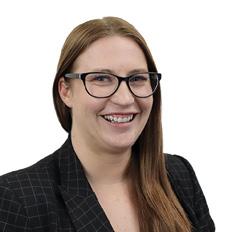
Forecast the skills you’ll need for future projects
More than 40% of the industry’s workforce is expected to retire over the next 15 years. As a result, roles such as civil, geotechnical, structural, and materials engineering and others which require technical specialisation will be in shortage.
Upskilling employees will help to plug these gaps as well as increase employee engagement. Employees are more engaged in their roles when they see their employers are invested in their professional growth.
Employers should also address skills gaps by hiring from graduate talent pools. If you’re not sure how to select candidates from a graduate pool, consider reaching out to a recruitment agency. Recruiters who regularly hire graduates will have a keen eye for desirable attitudes and characteristics that an untrained or inexperienced graduate recruiter would miss. Fuse
Housing ACT is seeking to purchase from the private market and building sector:
Land Multi-unit developments House and land packages
Houses, townhouses, units and land at all stages of development
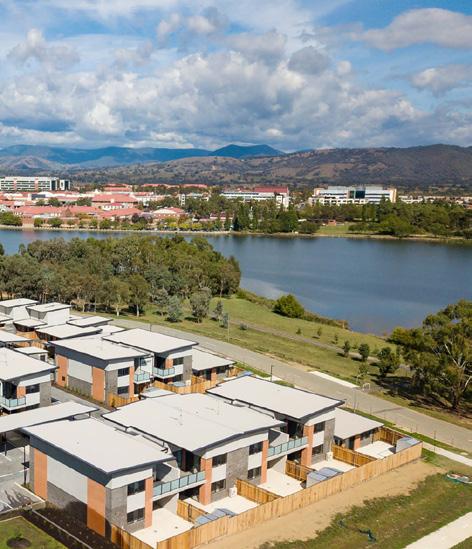
Energy efficient, close to amenities preferred
Substantial deposits on house/land contracts
Expedited settlement on completion Enquire now: growthandrenewal@ act.gov.au
For more information: www.tenders.act.gov.au
Reference: 2020-1044-110
22 THE NAWIC JOURNAL 2022
Recruitment info@fuserecruitment.com
of interest now open
the Growing and Renewing Public Housing program
Casey Bartlett Expressions
Supporting
TINY HOUSES
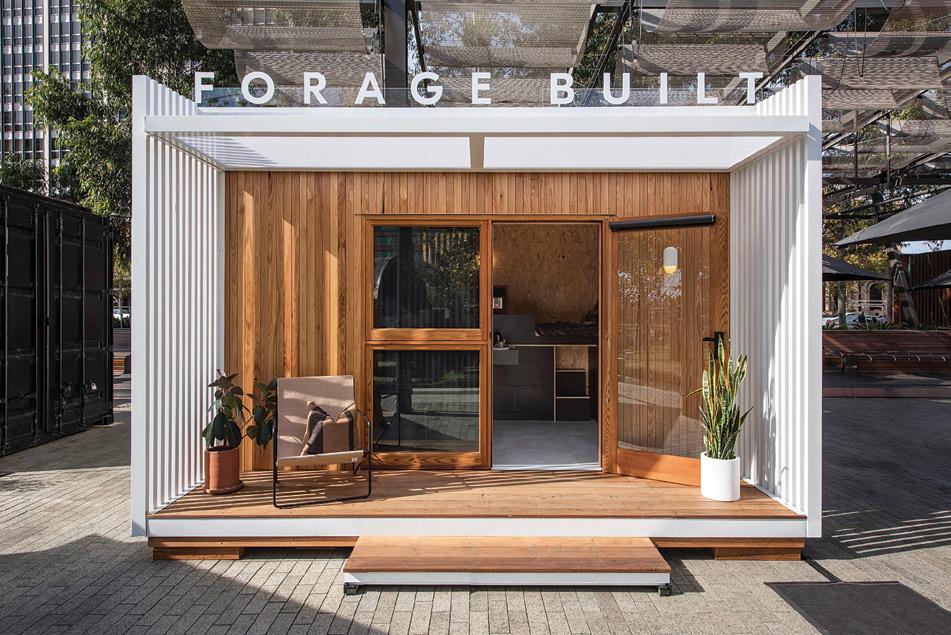
At a time where homelessness is widespread in society with a 20% increase in rough sleepers over the past 4 years, one would question what are we as a Nation doing to enable such a rise. And despite the efforts of many diligent organisations, homelessness continues to be prevalent in the streets of Adelaide and the call for a new housing solution seems more necessary now, than ever before.
Zoe Steele, one of NAWIC’s committee members and Founding Director of the social enterprise, Forage Built is doing just that. Her passion for the empowerment of women and her drive to make a difference particularly in the construction industry, has taken years in the making. But through her experience in industries including education, construction and development, and some really trying times to get her to where she is today, Zoe has learnt that the toughest times can be a precursor to success.
Zoe has always been passionate about helping those less fortunate, particularly in the homeless sector and more recently looking at homelessness of women in their 50’s. She is aware that the opportunities that she has access to, were not so accessible 20+ years ago, with ‘working mums’ being a rare prospect. The notion of women staying at home, caring for the children, supporting their husbands who progressed their careers, was all too common. Unfortunately, the increase in divorce has seen women who have no skills, no opportunity for a career and lack of identity, fall into the downward spiral of homelessness.
The opportunity to be involved in Forage Built came to fruition when both herself and her husband Andrew Steele, Director of Studio Nine Architects, were approached by Tim Pearce, Director of Frame Creative to develop an initiative to help those experiencing homelessness. A vision 4 years in the making, with the idea initiated by Scott Rogasch and Justin
23 THE NAWIC JOURNAL 2022
Westhoff, Directors of Forage Supply Co, Zoe became a part of a bigger picture that could turn the notion of 0% homelessness into reality.
The goal for Forage Built is to provide innovative, sustainable and transportable short to medium term housing, in the form of tiny homes for those experiencing homelessness.
To begin the journey, Zoe and the team conducted surveys with the end-user to find out what they valued.
“We wanted to steer away from designing a dwelling that was a so called ‘band-aid fix’ but rather look at a medium term solution giving the end-user a feeling of dignity and safety, which informed our design”.
Zoe Steele
With this data, plus further research from industry experts such as Hutt Street Centre, and sponsors like Beyond Bank and Lorrequer Wealth & Advisory, the team designed and built the structure of the first prototype in 2021 called The Calyx 16. The generous in-kind contributions from organisations such as Studio Nine Architects, Frame Creative, Revolution Roofing, Reece, Treehouse 3D and Ikea enabled the finalisation of the fitout.
This 16sqm one-person dwelling contains an ensuite, kitchenette, study nook and plenty of storage space throughout. Each square meter is working really hard with overlapping uses and additional height totalling 3.6m, to steer away from the traditional ‘shipping container’ idea. The materials chosen are robust to promote a long shelf life, and sustainable, to promote lowest impact on the environment.
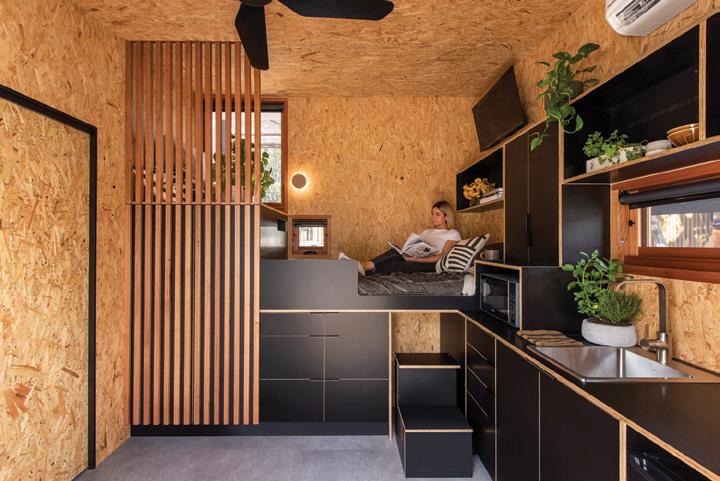
“The design includes large windows connecting to the outdoors and allowing access to natural daylight and ventilation. We’ve created a generous, but intimate space, that can be tailored to each individual.” Andrew
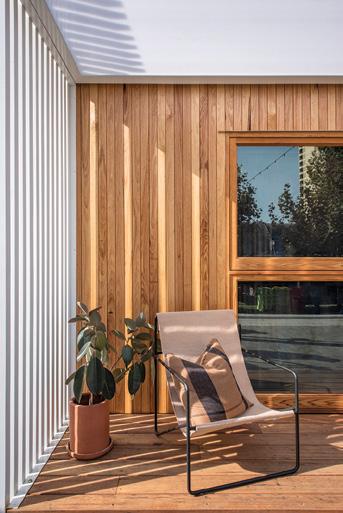 Steele (Architect)
Steele (Architect)
The Calyx 16 is not intended to be used in isolation, but rather built as a village in a community of pods, each separated by landscaping with a central community dwelling acting as a place where the individuals can be up-skilled in preparation for their transition back into society. The village is intended to give the individuals meaningful opportunities for connection. An extra dwelling will also be placed within the village, where a case worker or counsellor can reside.
Zoe has been working tirelessly on the business model to enable a successful outcome and explains next steps to get the village up and running.
“There are three pieces of the puzzle for success of this project. These are land, funding and an operator. Through our pursuits, we have found a number of developers willing to temporarily gift us underutilised land, however funding is an issue and something we are working on”. Zoe
Steele
24 THE NAWIC JOURNAL 2022
RETHINKING OCCUPATIONAL HEALTH & SAFETY MANAGEMENT OF WOMEN IN CONSTRUCTION
The construction industry in many countries, including Australia, is facing severe challenges due to skill shortages. The industry is in dire need of attracting more trades workers and professionals to sustain its growth. As a result, the need to recruit and retain female workers in the construction industry extends beyond the argument for gender-diverse or inclusive workplaces; it is also about the survival and sustainable growth of construction organisations. While initiatives from the government, organisations, educational institutions, and professional bodies to promote construction careers among women and encourage them to join the industry are commendable, it is also essential to provide a safe and supportive work environment to retain them in the industry, especially in site-based roles.
Although construction workers from different genders are exposed to a similar work environment and job hazards, research shows that occupational health and safety (OHS) risks are gendered. Women may face unique OHS challenges in construction due to gender-based physiological and psychological differences, work and workplace designs, and maledominated macho work culture. For example:
» some personal protective equipment (PPE) may not correctly fit due to natural physiological and morphological differences.
» tools, equipment, and workstations designed for men could cause musculoskeletal disorders in women.
» tools that fit men’s hands could be too large for women’s tight grip.
» lesser upper body strength may result in women exerting more force when lifting or using various materials and tools, causing upper body sprains and strains.
» expectations of a demanding and challenging work environment may put extra physical and psychological pressure on women.
» exposure to dust, noise, fumes, and chemicals could present reproductive hazards.
» lack of suitable site amenities could lead to bladder and kidney infections.
» discrimination, harassment, bullying, lack of social support and fewer career development opportunities could cause poor mental health among female workers.
» less access to peer support, mentoring, and on-the-job training than their male counterparts could affect female workers’ OHS management knowledge and experience.
However, OHS issues of female construction workers can be overshadowed in OHS records due to their low representation in the industry. Additionally, OHS risk management strategies could fail to recognise and mitigate gender-specific OHS concerns. The limited knowledge about the OHS hazards and risks specific to females may prevent stakeholders from developing tailored strategies to improve the health and well-being of female construction workers. To address this gap, the authors analysed workers’ compensation data (2008-2019) obtained from Safe Work Australia to examine specific OHS risks encountered by female construction workers. The analysis offered the following insights:
⋅ Of the 198,895 incidents, 3,686 were recorded for female construction workers. The overall incident rate for the study period was 1.85%.
⋅ Females in both trade and professional roles had lower injury rates than their male counterparts. Therefore, it would be incorrect to assume that women have a higher rate of injuries than male workers.
⋅ Female trade workers are more than 10 times more likely to be injured than female professionals or office-based workers.
⋅ The most common nature of the injury, injury mechanisms and vulnerable occupations vary between the genders.
⋅ Female building and plumbing labourers recorded the maximum number of incidents, followed by earthmoving plant operators and electricians, despite the number of females employed as electricians being roughly two times that of female earthmoving plant operators and four times that of building and plumbing female labourers. In contrast, the proportion of female carpenters and joiners with partial and temporary incapacities is lower than males.
⋅ Falls on the same level contributed to the maximum number of incidents resulting in either total or partial permanent incapacity or temporary
25 THE NAWIC JOURNAL 2022
MEASURES & ACTIONS
Laws and regulations; codes, standards, and policies recognising genderspecific OHS concerns; audits covering both physical and psychological hazards; enforcement of holistic OHS management approaches etc.
Coordinated or synergised efforts; formal and informal OHS training and knowledge transfer; contractual arrangements covering gendered approach to OHS; availability of appropriate PPEs and tools etc.
Top management support; organisational rules, regulations and procedures to eliminate psychological risks to females; dedicated resources; safety culture; respectful and supportive workplaces; familyfriendly employment policies etc.
Holistic management of gendered OHS risks; more focus on vulnerable trades and injury mechanisms; redesigning work, work processes and workplaces; proper amenities; fair, supportive and respectful culture at the project/site level; zero tolerance to harassment and bullying; on-job mentoring etc.
OHS hazard awareness and knowledge; rational approach to OHS risk management; professional conduct and ethics; respecting and adhering to rules and procedures; change agents and champions for an inclusive workforce etc.
INCLUSIVE OHS MANAGEMENT
incapacity among female workers, followed by long-term exposure to sounds and muscular stress while lifting, carrying or putting down.
⋅ Female construction workers were injured due to falls on the same level more than from a height.
⋅ Soft tissue injuries were the most common type of injury among female workers.
⋅ Psychological disorders due to work pressure, workplace harassment and workplace bullying, which result in total or partial permanent incapacity, were more prevalent among female workers.
⋅ The proportion of permanent incapacity due to work-related anxiety and stress disorders among female workers was almost 12 times more than in males when analysed separately.
⋅ Female workers aged 45 and above had higher representation in permanent incapacity, whilst females below 25 were more prone to temporary incapacity.
The findings could help training providers, construction organisations, and practitioners identify specific OHS concerns and develop comprehensive OHS management and training programs. For example, a high occurrence of injuries due to muscular stress while handling objects demand better ergonomic designs of work processes and automation. Similarly, high rates of incidents resulting from psychological
hazards such as work pressure, harassment, and bullying require more attention to the mental health of female construction workers. In essence, the existing OHS management policies, systems and training programs should be remodelled or redesigned to incorporate gender-specific OHS risks and injury prevention mechanisms rather than a one-size-fits-all approach. Such changes may not be achieved by a single organisation; instead, there must be a concerted effort from all stakeholders. Measures or actions to eliminate or reduce physical and psycho-social hazards and risks must be taken at the policy, industry, organisation, project, and individual levels to attract and retain more females in the construction industry. The diagram above shows a comprehensive approach to remodelling the OHS management for inclusiveness.
Dr Abid Hasan + Professor Imriyas Kamardeen
School of Architecture and Built Environment, Faculty of Science, Engineering and Built Environment, Deakin University
More information about this research can be found in the following published article: Hasan, A & Kamardeen, I 2022, ‘Occupational health and safety barriers for gender diversity in the Australian construction industry’, Journal of Construction Engineering and Management, 148(9), https://doi.org/10.1061/(ASCE)CO.1943-7862.0002352.
Acknowledgments: This article uses data supplied by Safe Work Australia and has been compiled in collaboration with state, territory and Commonwealth workers’ compensation regulators. The views expressed are of the author(s) and not necessarily the views of Safe Work Australia or the state, territory, and Commonwealth workers’ compensation regulators. The authors would like to thank Safe Work Australia for providing the data set for the research. Without their support, the research would not have been possible.
26 THE NAWIC JOURNAL 2022 Enabling policies/regulatory environment Stakeholders’ commitment Organisational support/culture Project team involvement Individual actions
GROWING NAWIC’S ‘WOMEN ON TOOLS’
An
Interview with Radmila Desic, AM FAIB & Life Member of NAWIC
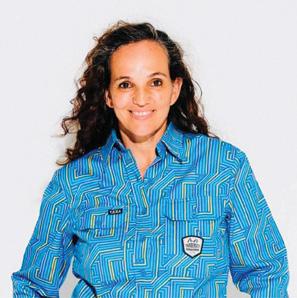
We spoke with Rad, Carpenter/Joiner now Senior Investment Consultant, about the evolution of NAWIC’s ‘Women on Tools’ and driving change for women, for the industry and the betterment of society.
How did NAWIC’s ‘Women on Tools’ begin?
Established in 2016 the Women on Tools (WoT) was originally an advisory committee to inform the Queensland Chapter Council on how to better connect and keep tradeswomen and frontline workers engaged with NAWIC.
Over the past 6 years WoT has established itself as an integral part of the NAWIC community, significantly contributing to the many milestones achieved, including record numbers of trade and apprentice nominations for the Crystal Vision Awards. WOT ensures tradeswomen are seen, recognised and their voices amplified.
We now have a Women in Trades (WiT) in WA and NSW, with most chapters creating trade specific events in their annual calendars.
When it comes to ‘Women on Tools’ we often see imagery that doesn’t appear genuine. What is NAWIC doing to improve this?
In QLD we facilitated a photoshoot with Tradeswomen and apprentices to ensure authentic representation of diverse women on construction site. The aim was to remove stereotypes, break down barriers and create a positive image for women and girls who are considering a career in construction. NAWIC is sharing these images with government and industry to promote real women doing real work onsite. The Australian Building Code Board was the first to jump on this opportunity and we look to seeing our images, our real women on tools, in the public domain.
Share with us some of the events that WOT has held.
Recently we held our first Toolbox Breakfast on the Gold Coast. Toolbox breakfasts are generally held in the morning being a good time of the day for when more tradespeople are available. The event was hosted by TAFE QLD and included a BBQ breakfast where family was welcomed. This is important because we know that Mothers are exploring options in trades and they do not always have access to baby sitters so we encourage people to bring their families with them.
This event was designed for women and girls who are interested in a trade career to speak with mentors and educators. It was also an opportunity
to showcase women who’ve carved out successful construction careers and share and celebrate their success.
We’ve also hosted Speed Careering events for students in Cairns, Townsville, Central Queensland, Sunshine Coast, Brisbane, Toowoomba, and the Gold Coast. Speed Careering works a little like Speed Dating where attendees get a short opportunity to speak with each of the mentor tradespeople and learn more about that career path. We have heard that several have secured apprenticeships following these events which is so exciting.
In March 2022, Ruth (NAWIC QLD Project Coordinator) and Rachael (2021-2022 WoT Co-Chair) ventured up the Queensland Coast to connect with industry in Cairns, Townsville, and Rockhampton. There was an impressive turn out of female students at Speed Careering and amazing Role Models. The inaugural Toolbox Breakfast in Townsville was also a success and it was so encouraging to see the growing support for women in construction in regional Queensland. The local tradeswomen and apprentices are so inspiring and breaking down barriers every day, doing what they do. It was a rewarding trip and we’re looking forward to doing it again soon!
In WA some things we have done as part of the WiT committee include:
⋅ Female only Try a Trade in conjunction with CTF for Year 8 and 9 students;
⋅ Tradie Sundowner networking event
⋅ MBA Female Builders Scholarship
⋅ Women’s Shed
Eileen Wong, our WA President, says since we have created the committee we have definitely seen a marked increase of female trades within the committee and attending our events.
27 THE NAWIC JOURNAL 2022
Radmila Desic
At NAWIC we reference the ‘Leaky Pipeline’ as an overarching set of issues impacting women in construction. This refers to the need to have more young women join the construction industry at the start of their career as well as the need to make them feel safe, retain and promote them.

We have promoted careers in construction for women and girls at schools, career expos, and sport career and development officers. We have hosted Industry leaders Collaboration Roundtables with Apprentices, Group Training Organisations (GTO’s), Union’s, and Industry Associations. WoT provides regular content for Study Work Grow’s monthly magazine to spotlight apprentices. It was great to give our feedback to the Queensland Training Ombudsmen on the challenges and issues female apprentices face in securing an apprenticeship and during their apprenticeship. This sits alongside our mentoring program and the many events where we get together to support each other.

At a practical level these are some of the things WoT does for its members:
⋅ Share stories from the local community and discuss the barriers they are facing in
⋅ Tradeswomen talking about what they do and how they got started in construction, making it relatable to the school students; breaking down the stereotypes
⋅ Showing that trades for ladies is NORMAL and POSSIBLE and that there is support there
⋅ Creating pathway– i.e. how to complete school and transition into a trade or to take build a career in construction / non-traditional trades
⋅ Connecting with local community and resources in industry such as employment partner, education providers and government.
What does the future hold for ‘WoT’?
We are achieving strong stakeholder engagement; however, our goal is to have a greater footprint across regional and remote Queensland and in 2023 we will be looking to host more regional events to provide tradeswomen with opportunities to network and find support from like-minded people. We will continue to promote the Male Allies program and are in discussions on how we can provide this training to Tradespeople who run their own small businesses. We will continue to collaborate closely with the Queensland Government on programs to attract more women and girls in construction.
We hope that other NAWIC Chapters will be inspired to create WoT/WiT events and/or committees to support their onsite members and grow NAWIC’s relevance for all women in construction.
28 THE NAWIC JOURNAL 2022
Back: Carlie Low, Radmila Desic, Cassandra Horan, Rachael Keiley, Penny Cornah, Toni Hillman, Helen Fedoruk, Rian Kelso.
Front: Rachael Price, Ruth Gunaseelan with Zoe the service dog.
Credit: CTF.
Out on the road at the WA WiT Try a Trade event.
FULTON HOGAN
Helping the Richmond Football Club Women’s Program Kick Goals
As part of its ongoing commitment to promote and drive gender equality in the construction industry, Fulton Hogan is proud to partner with the Richmond Football Club Women’s program. The program offers flexible employment pathways, which give the Club’s female players the financial means to focus on playing football at both AFLW and VFLW level.
The partnership which commenced in early 2020 has seen Fulton Hogan employ four Richmond AFLW players in a variety of roles both in the office and onsite. The women are offered on the job training and have been put through a Certificate III in Civil Construction.
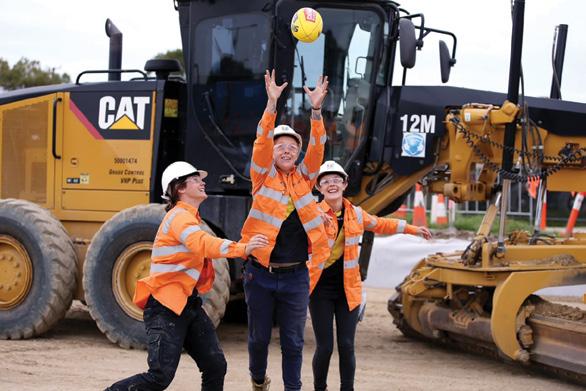
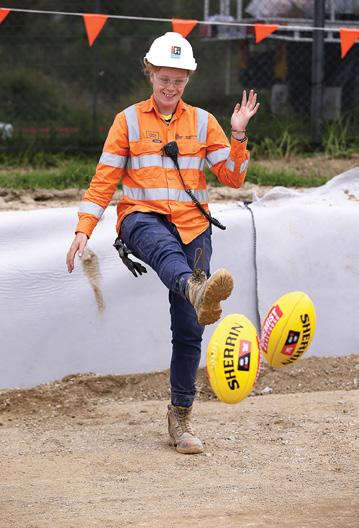
“Fulton Hogan has a real focus on increasing the number of women entering the construction industry,” he said.
“By offering flexible career pathways within our business, we are not only helping footballers to realise their AFLW dreams, but also providing the industry with female role models of which young women and school-aged kids can aspire to.
“The program boosts awareness of viable career options for women in construction and that can only be a good thing for the industry and our own workforce. We know that diverse organisations do better and this is an important step towards improving the gender diversity in our industry.”
Richmond CEO Brendon Gale said at the time, he was thrilled the Club was able to form a partnership that would provide female players with a meaningful career pathway outside of football.
“We are invested in helping all of our players to prosper on and off the field and this partnership gives our girls the opportunity to build a career in construction with excellent mentor programs and pathways.
“Partnerships with organisations such as Fulton Hogan, and their flexible approaches to career pathways are valuable to our Club, the ecosystem of AFLW and most importantly, our players.
“It is fantastic that Fulton Hogan is giving women a chance to serve as brilliant role models to the next generation whilst promoting gender equality in another industry.”
Fulton Hogan is proudly a Work180 endorsed business, further demonstrating its commitment to diversity, equity, and inclusion. With Work180 only endorsing companies who are genuinely committed to removing barriers for women in the workplace, it’s a testament to the work that Fulton Hogan are doing in this space.
Fulton Hogan Alliance General Manager Dean Riha, said the partnership with Richmond offers female footballers flexible employment pathways that support their rigorous training schedule.
Despite moving on from the Richmond Football Club, all four of the women are still employed within Fulton Hogan across three states - demonstrating the ongoing success of the program. Fulton
29 THE NAWIC JOURNAL 2022
Former Richmond AFLW player and current Fulton Hogan employee Tayla Stahl.
Hogan’s continued support has meant that interstate moves for football or family have been made easier for the women with guaranteed ongoing employment when they reach their new homes.
Former Richmond turned Brisbane Lions AFLW player Phoebe Monahan was amazed by the support she received through the program.
‘I started with Fulton Hogan when I was playing for Richmond and was blown away by how supportive they were of my football.” Monahan said.
‘They know that in season, footy comes first, but also make sure I am still learning and developing on site. When I decided to make the move to the Lion’s, I wasn’t sure how it would play out, but my mentor helped facilitate an interstate move to a new role within the company.’
‘Moving states and clubs wasn’t easy, so knowing that I still had a job with a business that understands and supports my footy was invaluable to me’.
Whilst the partnership was initially established for AFLW and VFLW players, the relationship has developed and now sees Fulton Hogan offering employment to Richmond’s partner organisations. Fulton Hogan employees also have the opportunity to offer mentoring to aspiring leaders going through the Korin Gamadji Institutes’ Advanced Leaders program.
From humble beginnings, the partnership is driving real change throughout the industry, supporting Fulton Hogan’s quest for a more diverse and inclusive industry.
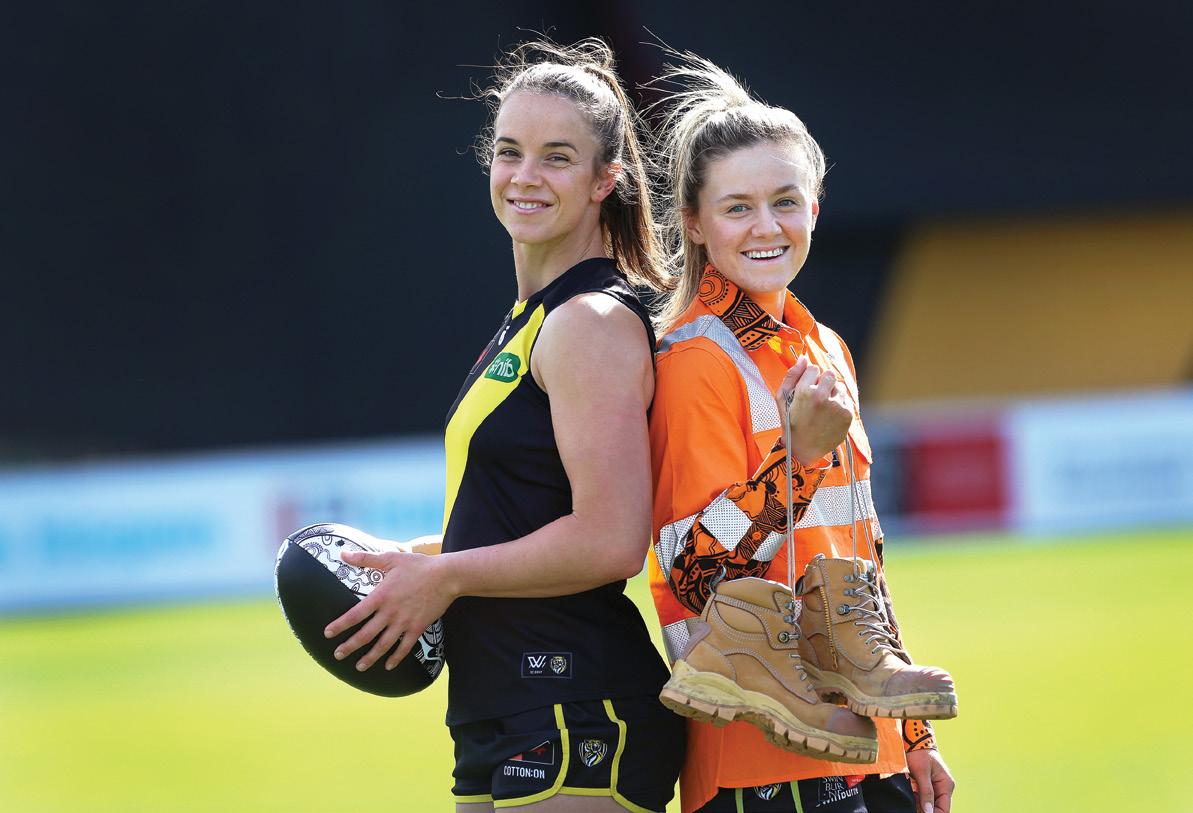
30 THE NAWIC JOURNAL 2022
Richmond AFLW players Gabby Seymour and Maddy Brancatisano.
EBONY ANTONIO SHINES A LIGHT ON FEMALES IN CONSTRUCTION
For Fremantle Docker and Electrician Ebony Antonio a career as a tradie made perfect sense and she’s hoping other women will be inspired enough by her story to also join the ranks.
Like a lot of teenagers Ebony Antonio had no idea of what she wanted to do and was “living in the moment” when she finished school.
Then she started working for her Uncle’s company concreting and pressure cleaning and fell in love with the idea of being a tradie.
And it’s an idea she says she’s very glad she followed through with, now that she’s finished her four-year electrical apprenticeship and is happily on the tools.
“When I finished school I was playing a lot of basketball, having fun, but my parents were keen for me to choose a career pathway, so I got a casual job at Target and then started work for my Uncle’s company and I absolutely loved it,” she said.
“I knew I always wanted a job where I was outside instead of behind a desk at an office, so a trade made perfect sense.
“Now that I’ve finished my apprenticeship, being an electrician also works really well with football, I’m usually finished by 3pm, so it leaves me enough time to train and also be a part of the club.”
Ebony finished her apprenticeship two years ago and said she has learnt so much since she finished it. But she still remembers her first day on the job like it was yesterday.
“To be honest I was really nervous, its daunting starting something new, and I didn’t know what to expect and how the guys on the job would treat me,” she said.
“But I was really lucky, because I was a mature-age apprentice, the guys weren’t too much older than me and they were totally comfortable with having a woman on the job and really generous with their time.
“As soon as that first week ended, I knew I was in the right place.”
Ebony said she lives by her Dad’s mantra of “if you have a good worth ethic and you show initiative you’ll fit in anywhere” and it has served her well in both her trade and sporting careers.
“In both instances I knew I had a lot to learn and I just got in,
showed initiative and worked hard. I think if you do that you can really learn anything you put your mind too,” Ebony said.
“Just like anything you have to get to know people’s personalities and read their body language. There will be people you really click with and some you don’t, but if you can all respect each other, then you’ll work together to become a strong team.”
She said her advice to women considering a trade was to “dive right in” and help inspire young women of the next generation.
“Don’t be afraid to stand tall and prove to yourself and your friends and family that you can make it in a male dominated industry,” she said.
“In the future I’d love to see more female CEOs in the construction industry, I think women have natural leadership skills, we show a lot of initiative and have common sense in spades, so I’d love to see that shift for the next generation, to have those female role models in the industry to look up to.
“So many more women are taking up trades, but we’re still outnumbered, there’s only 3% of female trade apprentices in WA and I’d love to see that rise to at least 15%. I’m really passionate, about it and I think if you have a trade behind you, the world really is your oyster.
“I’m really proud of breaking down the barriers of a male dominated industry and I’m a real advocate for getting more girls to take up a trade and break down that old-fashioned stigma around it. We need more girls in the construction industry.
“If you believe in yourself, anything is possible.”
Beverly Ligman
If you’d like more information on pathways to becoming an electrician, or any other construction trade, head to ctf.wa.gov.au/find-your-ideal-job
Construction Training Fund is committed to creating a safe, skilled and sustainable construction industry, that is a career of choice for all.
31 THE NAWIC JOURNAL 2022
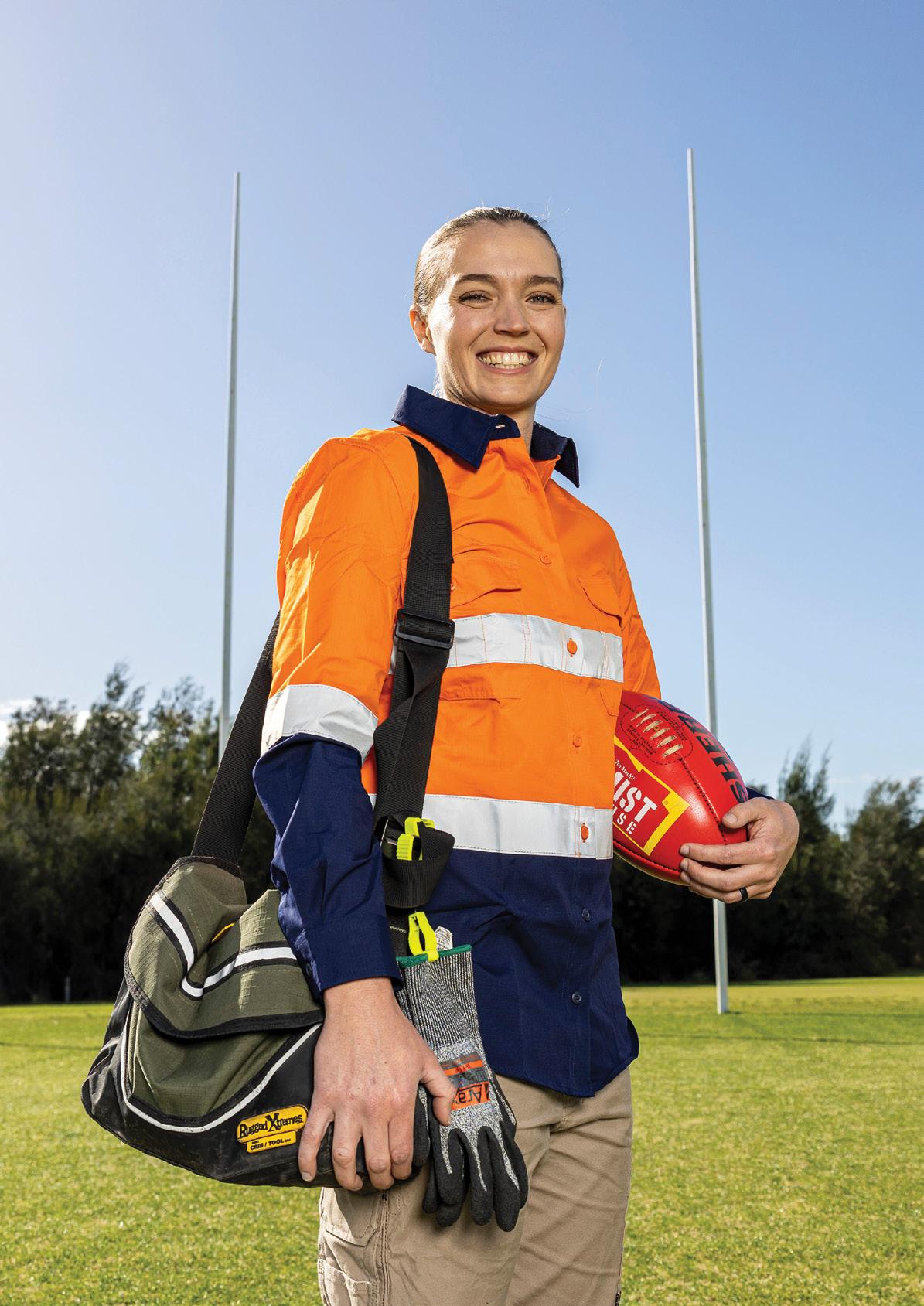 Fremantle Docker and Electrician Ebony Antonio
Fremantle Docker and Electrician Ebony Antonio
BE THE CO-PILOT FOR THE NEXT GENERATION
My name is Jo Matai-Taylor, a South African born Construction Management professional currently employed as a Commercial Manager for Lendlease Construction Pty Ltd. I have worked my way through the fundamental positions of Construction Management over the last nine years and am qualified in Business Management, Construction Management and currently study a Bachelor of Law (Honours) part-time whilst working full-time. Outside of this, I volunteer as a Co-Chair on the NAWIC ACT Education Committee to work collaboratively with NAWIC to achieve the ‘Strategy Goals’ that align with my personal interests in advocating for women’s empowerment, development, and advancement in the industry.
A large focal point for me at this time in my career is the investment into students throughout primary school, high school, TAFE (apprenticeships) and higher education. Why is this a focal point of mine? Because we as experienced professionals are the ‘co-pilots’ for the next generation. Whilst they fly their own MiG-25 Foxbats in life; we have a duty to connect them to the industry, provide realistic insights and fine-tune their skills to develop as powerful leaders. The excuse of ‘I didn’t have this back in my day’ is weak, outdated and demonstrates a s*** attitude in my opinion.
In partnership with NAWIC ACT (Education Committee), I have been privileged to be a part of this movement over the past two years. I would also like to recognise and applaud Emma Sckrabei and Nolita Ryan for their leadership and involvement in our advancement. I have elaborated on two programs below (to just name a few) to bring awareness on the current opportunities we have created for the next generation.
The Australian Training Company (‘ATC’) is a leading provider of business solutions through the creation of education, employment, and training opportunities. Our Education Committee have worked closely with ATC and specifically with their female trainees to facilitate work-experience, provide a support structure via the ‘Buddy Program’ and to actively engage with these students by exposing them to possible pathways that suit their interest. We have additionally hosted online seminars and quarterly events to maintain the relationship with the goal to retain these young women in the industry. This subsequently will assist in increasing female participation rates
within construction industry. To achieve this, we have built strong relationships with Builders, Consultants, Subcontractors, ACT Government, Education providers, and Master Builders Australia (ACT) plus many more. The value taken from these interactions have been priceless, and we have seen many of these women retain contacts, have a support structure, and be placed in permanent roles as a result.
Secondly, in partnership with the ACT Government Office for Women and the Education Directorate, our committee have launched the Understanding Building and Construction Pilot Program (‘UBCPP’), seeking to enhance opportunities and remove barriers preventing young women from choosing a career pathway in the construction industry. The UBCPP also aims to improve the understanding of the industry throughout secondary school education. Through this program, we have placed circa 120 female students to undertake work experience in the second half of 2022 within the construction industry and this is something we should applaud.
Put simply, we as construction professionals have a duty to give back to the community. We have a duty to pay it forward and open the doors for opportunity and professional development. We should be actively playing a part in building our students confidence and provide a support network that may not have previously existed. I strongly recommend all readers of this article to look into similar programs within your State(s) and get involved. As leaders in the industry, we need to be better, do better and as a result, it is inevitable that our industry will only improve. Be the ‘Maverick’ and co-pilot for our future generations. For me, one definition of success is developing others to reach their goals and ensuring this influence lasts in your absence.
Mrs Jo Matai-Taylor
33 THE NAWIC JOURNAL 2022
Commercial Manager, Lendlease Construction Pty Ltd
 Jo Matai-Taylor, Commercial Manager for Lendlease Construction
Jo Matai-Taylor, Commercial Manager for Lendlease Construction
PROCURING CULTURE CHANGE IN CONSTRUCTION
Our industry accomplishes inspiring feats of engineering, creating communities, building critical infrastructure and defining the skylines of our global cities. The projects with which we are trusted, are delivering cutting edge sustainability, technology and security to take us into the decades to come.
While we achieve a lot that should be celebrated, we have also been facing unprecedented times. The last few years have seen greatly increased demand, pandemic -triggered uncertainty, significant cost escalation and supply shortages that have placed pressure on an industry already experiencing challenges that hamper our ability to attract, retain and provide healthy and inclusive workplaces for our people. Our industry is under extraordinary stress at a time when the pressure to deliver the pipeline of national projects has never been as intense. The challenges to the sustainability of the construction industry are evident in our high attrition rates, poor mental health statistics, lack of diversity and in the insolvencies of multiple construction sector companies across Australia.
Australia’s construction industry is not regarded as a career of choice, particularly for women. Working hours are excessive and inflexible, the workforce lacks diversity and stress levels and suicide rates are comparatively very high. The workplace culture comprising about 88% males often fails to provide an environment where women can see a career pathway for themselves. It manifests itself in ways as basic as, in many cases, a lack of amenities for women on sites.

The construction industry depends in large part on the health, diversity and wellbeing of the people delivering our projects, as well as a strong pipeline of people seeking to join the industry or upskill within it. This is particularly critical over the next few years with estimates that an additional 118,000 jobs within the industry will need to be filled by May 20231 and that 105,000 of these will be unable to be filled within this timeframe. Given Australia’s current low unemployment levels, the urgency surrounding these numbers is acute.
It stands to reason that all of us – construction firms, clients and all the industry stakeholders need to squarely address our cultural challenges, making construction more attractive to new entrants and better able to retain the existing workforce. And we must do it together.
Our research shows that addressing the industry’s entrenched long working hours, will improve productivity and catalyse the cultural change we need.
The figures behind this need for change are compelling. The building and construction industry generates more than $360 billion in revenue and produces approximately nine per cent of Australia’s Gross Domestic Product, presently employing about 1.3m Australians, nearly 90% of whom are men and of whom about 182,000 work in infrastructure construction.
35 THE NAWIC JOURNAL 2022
1 2018,
to
Employment Outlook
May 2023,
Australian Government, Department of Jobs and Small Business, p3.
Figure 1: Construction Industry Statistics
It is clear that these pressures are having serious impacts on the productivity and sustainability of our industry.
BIS Oxford Economics recently calculated the cost of the negative aspects of the culture of construction industry. Without taking into account lost economic opportunity of women, the cost of attraction and attrition, and wage escalation through acute labour shortages, the Cost of Doing Nothing Report shows that the total costs nationally were about $8bn per annum.
In addition to the costs identified in this report, and when considering the significant skills shortage, our industry’s diversity statistics are a cause of increasing consternation:
⋅ Construction currently has the lowest female representation of any employment sector at 12%, with less than 2% of site-based roles currently occupied by women.
⋅ Construction currently has the widest gender pay gap of any industry at 30.6%.
⋅ Women are exiting our industry 39% faster than men.
⋅ According to the 2021-22 NSW Intergenerational Report findings, if women’s participation in the workforce increased to be the same as men’s in the next 20 years, the economy in 2060-61 would be eight per cent larger.
⋅ A desktop survey of sixteen of the leading infrastructure companies operating in Australia found there were no women in non-traditional executive level roles (for example, with P&L responsibilities)2 and a third had no women on their boards. It seems to underscore the muchquoted truism that “you can’t be what you can’t see.”
A culture standard for the construction industry
The Construction Industry Culture Taskforce (CICT) - a partnership founded in late 2018 between the NSW and Victorian governments, the construction industry, including the Australian Constructors’ Association, and a team of leading academics and independent contributors and working closely
with industry bodies and unions - has been working on a way to achieve systemic, step change by leveraging the government infrastructure procurement process as a powerful agent to drive culture reform.
Since August 2018, the CICT has been working to develop a Culture Standard, proposed to be included as part of the procurement process of governments across Australia, which will lift productivity and performance and address the major issues holding back our industry – excessive work hours and fatigue, poor mental health, and failure to attract a diverse workforce.
The Culture Standard provides a framework for clients and contractors to work together on infrastructure projects to support a construction industry where:

⋅ everyone has a place and feels valued,
⋅ wellbeing is prioritised across all job roles, and
⋅ everyone has access to flexible work options and caps on working hours, so they have time for life.
The three focus areas of the Culture Standard, Time for Life, Diversity and Wellbeing, aim to improve the experience of construction workers to enhance productivity, attraction, retention and the sustainability of the industry.
Based on our research, the CICT believes it is impossible to disassociate the gender imbalance in the industry from its long and inflexible working hours and the consequential psychosocial pressures on construction workers.
Addressing the excessive hours worked in the construction industry (including routinely, Saturdays) would play a significant part in unlocking the industry to many women and improving wellbeing, particularly the high incidences of poor mental health in construction.
Emerging evidence both within Australia and internationally strongly suggests that flexibility and capped hours increases productivity (or at least creates no material negative impacts on program or budget), and that working hours are inextricably linked to diversity and mental health outcomes and increase the attractiveness of our industry to women.
Addressing working hours is one significant part of the solution that the Culture Standard puts forward, however in isolation this will only take us so far. Tackling working hours, diversity and mental health and wellbeing in an integrated,
2 This has changed for the better in the past 12 months with two women holding P&L responsibilities in leading infrastructure firms.
36 THE NAWIC JOURNAL 2022
Figure 2: Cost of Doing Nothing Report Headline.
Time for Life:
Ensuring our workforce is provided adequate time to rest and pursue life activities outside of work.
• Better working hours
• Flexible working arrangements
Wellbeing: Ensuring the occupational health and mental wellbeing of our workforce is prioritised.
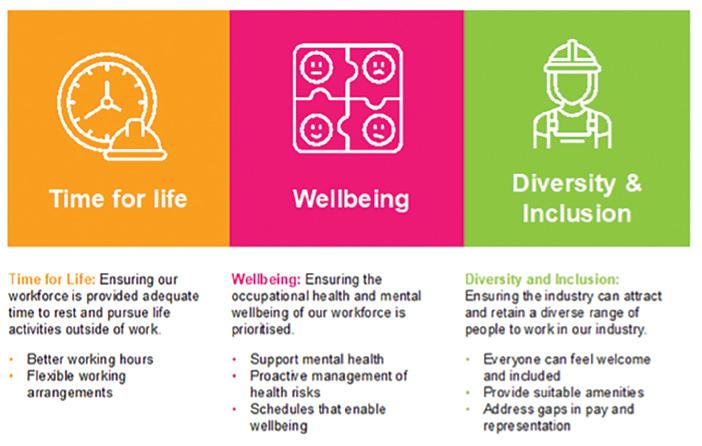
• Support mental health
• Proactive managment of health risks
• Schedules that enable wellbeing
systematic way through the procurement process, will harness much good work that has been done over decades by organisations like NAWIC and Mates in Construction, by unions and by industry associations.
Focussing on these three interrelated cultural issues in a holistic way and in partnership between industry, clients and our unions, will give us the best chance of securing enduring change. And leveraging the government procurement process is the best vehicle to make this happen.
The policy landscape is changing
Our work on the Culture Standard is taking place in an environment of great policy change. The Building Equality Policy in Victoria, the Women’s Economic Opportunity Review in NSW, the recent federally-led Jobs and Skills Summit and the establishment of the National Construction Industry Forum, two construction specific gender trials in the ACT and WA as well as the emergence of psychosocial health regulations across several states, demonstrate the level of focus our industry is receiving from policy makers and the desire for change.
These initiatives are strongly commended and supported by the CICT. The basis for our work is that our government clients must become part of the solution by requiring a methodical focus on culture as part of the evaluation of bids during procurement, included alongside cost, experience and capability, design, timeline and social procurement outcomes.
To strengthen the evidence base for the effectiveness of the Standard, the CICT has partnered with Australia’s leading workplace academics and has commissioned five pilot projects, supplemented by case studies and a cost/benefit analysis to test the impacts of flexible and capped working
Diversity & Inclusion: Ensuring the industry can attract and retain a diverse range of people to work in our industry.
• Everyone can feel welcome and included
• Provide suitable amenities
• Address gaps in pay and representation
hours, mental health programs and implementation of plans aimed at increasing female participation.
The collaboration and vision from industry, government, unions and other critical stakeholders to affect real and lasting culture change has been key to securing these pilot projects. We are grateful for the work to date and recognise that the projects represent a big step towards driving change across all Australian jurisdictions.
To ensure a construction industry that attracts, develops and retains the best talent, we need a tangible shift to a culture that balances commercial outcomes with the needs of our workforce, supporting gender equity, mental and physical health and flexible work practices that maximise productivity.
Many industry players and government clients are becoming early adopters of the Culture Standard and are already implementing the requirements. While the Culture Standard is not a silver bullet, its adoption into procurement policy will level the playing field among construction firms and transform a great industry into an even better one for all who work in it, and for all of us who benefit from its contribution to our quality of life.
Gabrielle Trainor
As a non-executive director and advisor, Gabrielle Trainor has had a 25 year career on the boards of public and private sector entities. Her current positions include the Victorian Government’s Major Transport Infrastructure Authority, ACT City Renewal Authority, WAM Global, the Western Parkland City Authority, and Built Group Pty Ltd. She is a Commissioner of the AFL.
37 THE NAWIC JOURNAL 2022
AO, Chair of the Construction Industry Culture Taskforce
Figure 3: Culture Standard Overview
Bring your passion. Define your future. Make an impact.
Thrive among a supportive culture at Hansen Yuncken, where challenge and inspiration meet to create extraordinary. Our experience and skill, fuelled by curiosity, allows us to build iconic projects founded in design excellence and technical innovation.
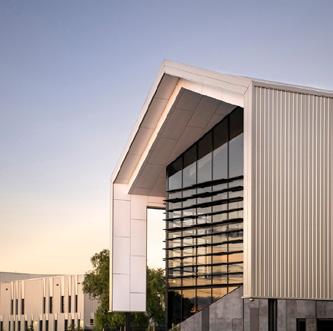

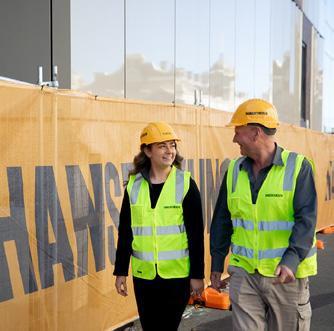
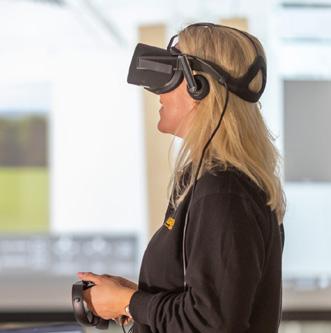
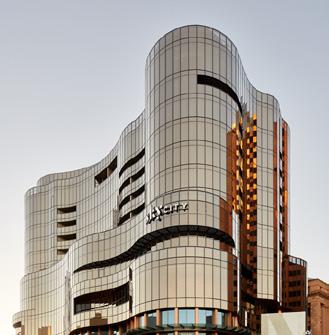
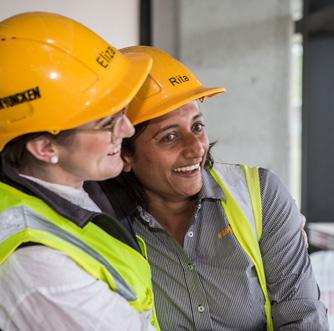
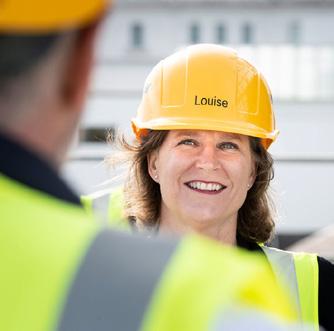
 DRIVEN BY CHALLENGE, BUILT WITH PRIDE
DRIVEN BY CHALLENGE, BUILT WITH PRIDE
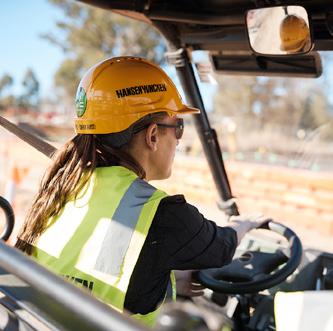
HANSENYUNCKEN.COM.AU
ELEVATING MARKETING FOR SMALL & MIDSIZE CONSTRUCTION BUSINESSES
If there’s one thing that Sue from Elevate Construction Marketing understands, it’s that small and midsize construction businesses are the backbone of the global economy. With so many marketing channels and strategies available to small business owners, it can be overwhelming to figure out which ones are right for your company.
This article covers the most essential marketing tactics for SMBs (small and midsized businesses) that will help you build brand awareness, drive website traffic, acquire new customers, and increase sales. Don’t let the word ‘small’ fool you – marketing is important no matter how big or small your company is. Even if you have limited time, money, and resources as an SMB owner, there are many cost-effective ways to market your business effectively and efficiently.
Plan your marketing strategy from the get-go
If you want to make sure that your business has a successful future, you need to start planning your marketing strategy from the get-go and be ready to invest a little money on marketing. Many businesses fail because their owners never planned for marketing. Now, I’m not suggesting you go and max out the company credit card - because there are many different cost-effective ways you can spend money on marketing, but you’ll need to decide which ones are right for your business, including many nil-cost tools that you may be able to incorporate. Once you understand which marketing strategies to use, you can start putting your plan into action. It’s best to start as soon as possible, so you have plenty of time to adjust as needed. A marketing strategy doesn’t happen overnight – you’ll need to put some serious thought into it if you want it to be successful.
Establish a social media presence
Social media is a key part of any marketing strategy, but where should you start? What are the best social media channels for construction companies? Social media may be the best way to reach your customers, but if your customers aren’t on social
media, it won’t help you grow your business. Do your research and ascertain where your customers are engaging and which social media platforms they prefer. What you post on social media will depend on which channels your customers are on; for example, LinkedIn is great for blog posts, written content, articles, and guides. Whereas TikTok is great for videos based on trending hashtags, dance videos, song imitations and dialogue re-enactments and light-hearted content.
Have a solid website
There are a few different elements that will help improve your construction website. First, you’ll want to make sure your site has a secure SSL certificate. Your website should also be unique and contain original content. You don’t want to be found out for plagiarism or copyright violation. You can check with ‘Copyscape’ or another similar website to make sure that your website doesn’t have any issues. Another important feature to include in your website is a Call-to-Action (CTA). A CTA is basically a prompt for your audience to take a certain action, like clicking a link or making a purchase.
Blog marketing
Blog marketing is one of the best ways to establish yourself as an expert in your industry. A blog allows you to regularly publish articles related to your product or service, your company, or industry news. Doing so gives your potential customers insight into your business and allows you to showcase your expertise in your field. When readers come across your blog posts online, they will become familiar with your brand. As your blog posts attract more visitors and build authority for your company, your website traffic is likely to increase. Blog marketing is a great way to connect with your customers. By regularly publishing articles on your site and via social media channels, you can create a dialogue with your audience. When readers leave comments on your blog posts, it will enable you to respond to them directly and build relationships with new and existing clientele.
39 THE NAWIC JOURNAL 2022
Video marketing
With the rise of online video, marketing with videos has become a lucrative and effective way for many businesses to attract new customers. In fact, statistics show that brands that create video content have an 89% higher chance of attracting new customers. Video for SMBs is effective as it creates a unique brand identity and creating video content allows you to visually showcase your brand, business, products, and service offerings. This can help you develop a unique identity compared to your competitors who don’t use video marketing. It’s additionally important to show your personality. Video marketing is a great way to show your company’s personality and humanize your brand. A video gives you the opportunity to connect with your audience on a more personal level and can help you develop stronger relationships. Video marketing is also a great way to establish yourself as an authority in your industry; by creating educational and informative videos, you can show potential customers that you know what you’re talking about and build credibility for your brand.
When used effectively, you can harness marketing to grow your construction brand and deliver qualified leads

In summary
A construction marketing strategy may seem overwhelming, but it doesn’t need to be. With these tips, you’ll be able to succeed as an SMB by staying nimble, keeping your overheads low and being able to partner with other businesses which will create a consistent brand and help in becoming a trusted and recognised organisation. Marketing is an important part of any business strategy, whether you’re a small business or a large corporation.
Small businesses also have unique challenges when it comes to marketing. Fortunately, there are several different marketing strategies, like those listed, that you can use to reach your target audience and make sure your brand is heard.
From blogs, video marketing, social media and more, these tactics can help you make the most of your marketing efforts and reach more potential customers. If you would to discuss your own marketing initiatives, goals or objectives; please reach out to Sue at Elevate Construction Marketing.

40 THE NAWIC JOURNAL 2022
#EmbraceEquity
Prioritising gender balance and achieving gender equality is imperative for workplaces not only because it is ‘fair and ‘the right thing to do,’ but because it is also linked to overall company and industry performance


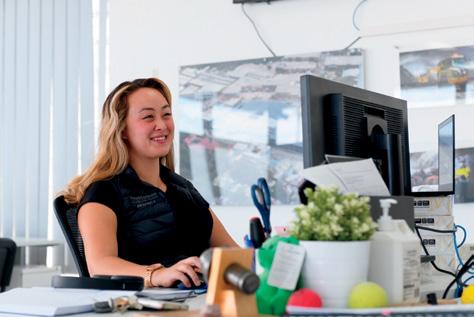
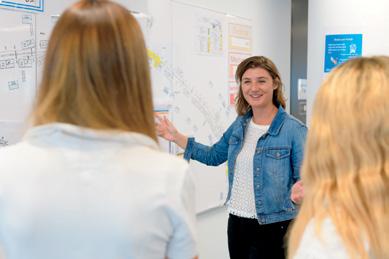
Our industry must change if we are to reduce skills shortages and have a thriving and sustainable future Many organisations in our sector are working to promote more women into leadership positions, and women working in the industry are also inspiring younger generations to follow in their footsteps.
As a company that is committed to gender balance, Bouygues Construction Australia recognises that the sector must remove barriers to allow for the equal participation of women in the workforce Our aim is for Bouygues Construction Australia to be an employer of choice for women in our industry We have to demonstrate that we have firm gender balance principles in place as well as modern practices in terms of career pathways, leadership training, mentoring, flexible work organisation and a competitive parenting strategy.

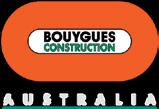
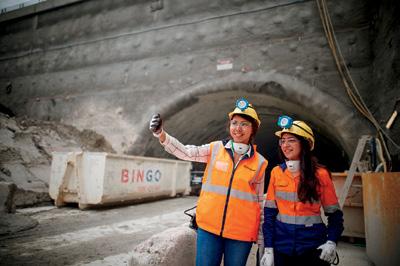
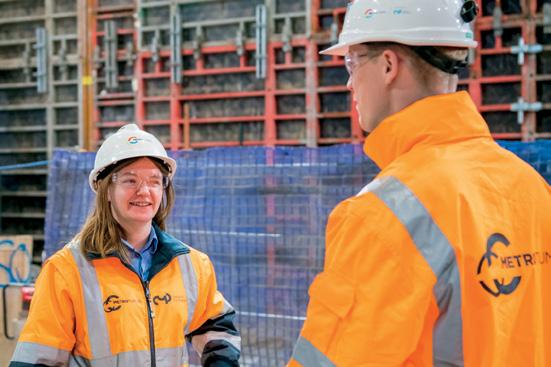
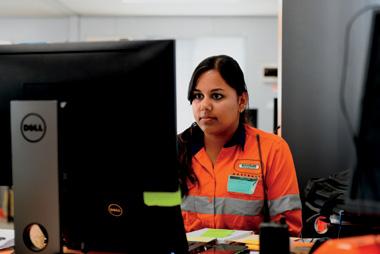
This is one of the most important challenges we face as an industry, and we are working hard to ensure that our company is doing its part to be a place where women succeed and thrive
na tionalWomen ' sD a y20
I n t e r
2 3
41
Seved Robin, CEO Bouygues Construction Australia
UPGRADING THE WORLD’S LARGEST TRAM NETWORK
The Victoria Department of Transport, together with the Victorian network operators and service providers are striving towards a more accessible and inclusive public transport network for all.
Home to the world’s largest tram network, Melbourne is upgrading 75 per cent of its stops to meet the future Disability Standards for Accessible Public Transport legislation. The government required tram user input to form a strategy on how to design and implement tram stop upgrades in alignment with the legislation.
The Department of Transport engaged Aurecon to assist them to build on, and refine, insights generated from earlier user research, and develop more specific user requirements for tram stops, to ensure they improve accessibility and customer experience.
Key features of an accessible, modern, secure, and integrated tram network:
⋅ Stops that are accessible to people with a disability, limited mobility and parents with prams
⋅ Modern facilities that meet the needs of a growing population
⋅ Integration with the urban realm to allow seamless transfers between all transport modes for all customers
User-centred design creates an integrated process Aurecon’s user-centred design approach was employed to determine how people interact with the tram stops and the pain points they face.
Our research sought to uncover the whole user travel experience, taking a passenger’s view. We collaborated with social enterprise Ability Works to develop an understanding of the experiences of different users and non-users, their needs, and pain points, experienced at key tram stop types. Ability Works’ employees and community provided insights into the public transport journey faced by people with accessibility challenges.
One in five people within the Australian population live with a disability said Ability Works Chief Executive Officer, Sue Boyce.
“Our employees and community were so excited to be able to contribute to a major infrastructure project. It was mindblowing for them – they couldn’t believe that they were being asked for their opinion.” Sue
Boyce, Ability Works Chief Executive Officer
LOCATION: Wurundjeri Country, Melbourne, Victoria, Australia
CLIENT: Department of Transport
PARTNERS: Ability Works
AURECON’S ROLE: Digital engineering tools to develop a series of digital twin tram stop designs using visualisation and Unsigned Studio
EXPERTISE: Digital engineering & advisory, Integrated design Melbourne is upgrading the world’s largest tram network stops to meet the future Disability Standards for Accessible Public Transport legislation.
Aurecon was able to understand the articulated, as well as the unarticulated, customer needs and pain points. The data was distilled into six central themes: connectivity, confidence, comfort, choice, convenience, and safety.
Engaging in challenging times
The ability to conduct in-field observational research was curtailed due to COVID-19. Aurecon used digital engineering tools to develop a series of digital twin tram stop designs using visualisation.
This was developed through our inhouse agency – Unsigned Studio and Aurecon Digital Tool siteLab® to bring the designs to life.
The visualisations simulated the tram stop experience, coupled with immersion techniques, to help users to better replicate their typical user mindset. Seven types of virtual tram stops were modelled, based on a shortlist of stops developed by the Department of Transport.
The team engaged with some of Melbourne’s most vulnerable tram users, all living with a disability. This was in addition to tram users without accessibility impediments, cyclists, pedestrians, and car drivers.
Participants were immersed in their transport user mindset and the digital models using hypothetical scenarios and
42 THE NAWIC JOURNAL 2022
strong storytelling to ground the research participant in the scenario and place them as the lead character in their story.
The visualisations allowed research participants to ‘walk’ around the virtual world as if they were at the tram stop. The digital twin also allowed for the line of sight of a wheelchair user. The process brought empathy and understanding to see things from another perspective.
Community research was undertaken remotely with people accessing the visualisation from the safety and comfort of their home and providing feedback via interviews using webbased collaboration tools.
A range of testing scenarios such as weather (sun, rain, cloudy days), time of day (off-peak and peak – including greater numbers of pedestrians and vehicles) were tested with participants in a way that would have been unlikely during in-field observations.
“Aurecon’s willingness and the adaptability of the team, especially with the visualisations, has been standout.”
Jacquelyn Viti, Senior Transport Planner and Project Lead with The Department of Transport
A digital twin for design
The other benefit of the visualisation is that the Department of Transport now has a digital twin of each of the seven standard tram stop designs.
These digital twins replicate real life physical infrastructure at scale and present it in a digital environment. This is beneficial to the Department of Transport in undertaking real-time scenario assessments for transport planning.
The additional benefit of the digital twins is that they can be quickly and easily changed to prototype new tram stop designs with in-situ features, to test new tram stop concepts with future research participants.
Assessing seven unique tram stop types, with a broad range of users and non-users, provided a deeper understanding of which aspects of the tram stop design, location and broader context were successful or not, and which elements will service them better in future.
The benefits of inclusive design
By taking an integrated approach and translating user insights into the movement and place framework, the power of the user’s voice will be maintained during the next phases of the project – development of the user requirement guidelines and then the design for future tram stops throughout the network.
Trams and tram stops are an intrinsic part of the inner and middle suburbs of Melbourne. The way that the user’s voice has been integrated with digital visualisation on this project will help make the tram network more resilient, accessible, and usable.

43 THE NAWIC JOURNAL 2022
As Group Head of Civic Infrastructure at Development Victoria, Hannah Clement is acutely aware of how much she can influence and inspire young woman in the construction and infrastructure industry, including the female workforce at Development Victoria.
Hannah herself started at Development Victoria as a Senior Project Manager and has transitioned into the senior leadership team, working on a range of state-shaping projects.
She has an experienced and talented team around her, responsible for delivering some of Victoria’s most iconic infrastructure projects and as part of this team, a group of women who are taking on what was once a male-dominated industry.

Hannah believes Development Victoria’s portfolio of projects represent extraordinary opportunities for women interested in a career in the construction and property development industries, both at an entry and leadership level.
“We’ve been able to attract, retain and grow some extraordinary talent and support their career progression,” she said.
“Development Victoria provides unique, challenging but rewarding career opportunities. These opportunities are enhanced by our diverse range of projects that deliver outcomes that really matter to our communities – making every workday worthwhile.”
The $140 million Geelong Arts Centre’s Little Malop Street Redevelopment is a perfect example of a Development Victoria project providing the opportunity for female staff to progress their careers.
These include Senior Project Manager Beth Hackett, Project Manager Sandra Dias and Assistant Project Managers Tiana Thorn and Anita DiCarlo, who have all being able to progress their career during their time at Development Victoria.
CELEBRATING WOMEN
in the Construction Industry at Development Victoria
The project is overseen by Senior Project Director Kate Houlden, who joined Development Victoria at the start of 2022 from a similar role in the Victorian water industry.
“The reality of a predominately female delivery team with responsibility for such a high-profile project such as the Geelong Arts Centre redevelopment is something I could not have contemplated in my lifetime when I first graduated,” Kate said.
“I am proud of this team, the supportive culture and the way they’ve worked through some complex challenges to produce an amazing project that will deliver great outcomes for Geelong and Victoria.”
“It is fantastic to work with an organisation committed to fostering capability, supporting people to grow and develop, and move into more senior roles.”
Development Victoria is proud of its track record of supporting women in their careers and building gender equity right across the sector, as evidenced in our own team with CEO Angela Skandarajah and Board Chair, Megan Haas providing leadership of the organisation and Board.
The strong gender equity in the leadership team is further evidenced with women holding five of the organisation’s eight executive positions, and greater than gender parity within the Development Victoria Board.
Many talented women hold broader leadership roles across the organisation. The key to this outcome has been a collective awareness - and commitment - by the senior leadership teams to build understanding of the benefits of diversity, seeking to uncover ‘unconscious bias’ in recruitment decisions, rather than by imposing mandatory targets.
Find out more at Development Victoria by visiting the website
44 THE NAWIC JOURNAL 2022
Woolworths freezing out stereotypes
Woolworths freezing out stereotypes
Woolworths freezing out stereotypes
Woolworths freezing out stereotypes
Woolworths freezing out stereotypes
Our people are our superpower and we are always looking at ways to sustainably lead the industry to support future generations and truly make a difference.
Our people are our superpower and we are always looking at ways to sustainably lead the industry to support future generations and truly make a difference.
Our people are our superpower and we are always looking at ways to sustainably lead the industry to support future generations and truly make a difference.
Our people are our superpower and we are always looking at ways to sustainably lead the industry to support future generations and truly make a difference.
Our people are our superpower and we are always looking at ways to sustainably lead the industry to support future generations and truly make a difference.
The retail landscape is changing constantly due to technology and innovation. Over the next 10 to 15 years, the demand for skilled refrigeration technicians is anticipated to grow substantially. Our Installation and Facilities Management teams work toward developing industry leading technological solutions to deliver more sustainable refrigeration systems to reach our energy and environmental sustainability goals. As a result, Woolworths launched the Refrigeration Apprenticeship Program in 2020.
The retail landscape is changing constantly due to technology and innovation. Over the next 10 to 15 years, the demand for skilled refrigeration technicians is anticipated to grow substantially. Our Installation and Facilities Management teams work toward developing industry leading technological solutions to deliver more sustainable refrigeration systems to reach our energy and environmental sustainability goals. As a result, Woolworths launched the Refrigeration Apprenticeship Program in 2020.
The retail landscape is changing constantly due to technology and innovation. Over the next 10 to 15 years, the demand for skilled refrigeration technicians is anticipated to grow substantially. Our Installation and Facilities Management teams work toward developing industry leading technological solutions to deliver more sustainable refrigeration systems to reach our energy and environmental sustainability goals. As a result, Woolworths launched the Refrigeration Apprenticeship Program in 2020.
The retail landscape is changing constantly due to technology and innovation. Over the next 10 to 15 years, the demand for skilled refrigeration technicians is anticipated to grow substantially.
Our Installation and Facilities Management teams work toward developing industry leading technological solutions to deliver more sustainable refrigeration systems to reach our energy and environmental sustainability goals. As a result, Woolworths launched the Refrigeration Apprenticeship Program in 2020.
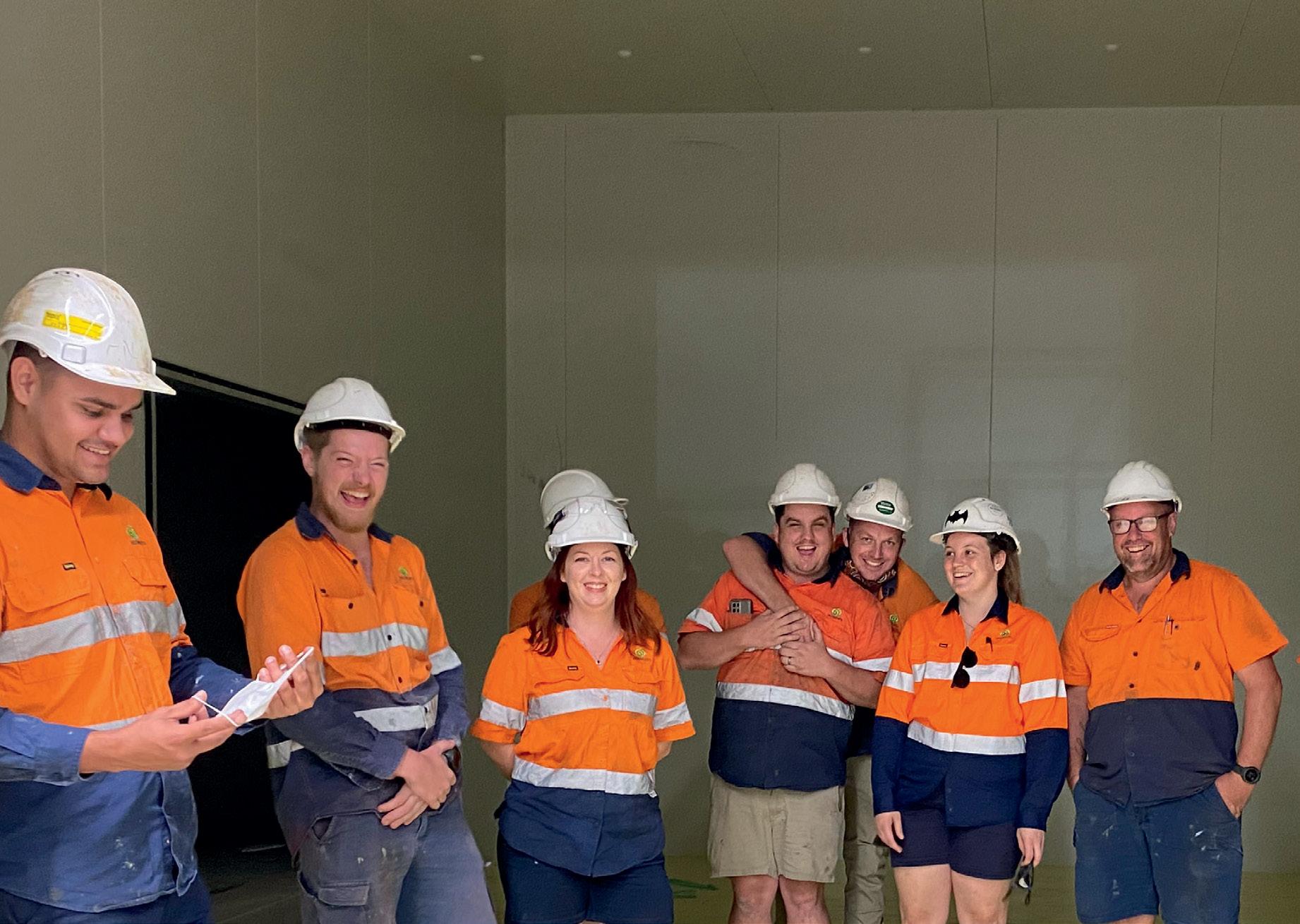


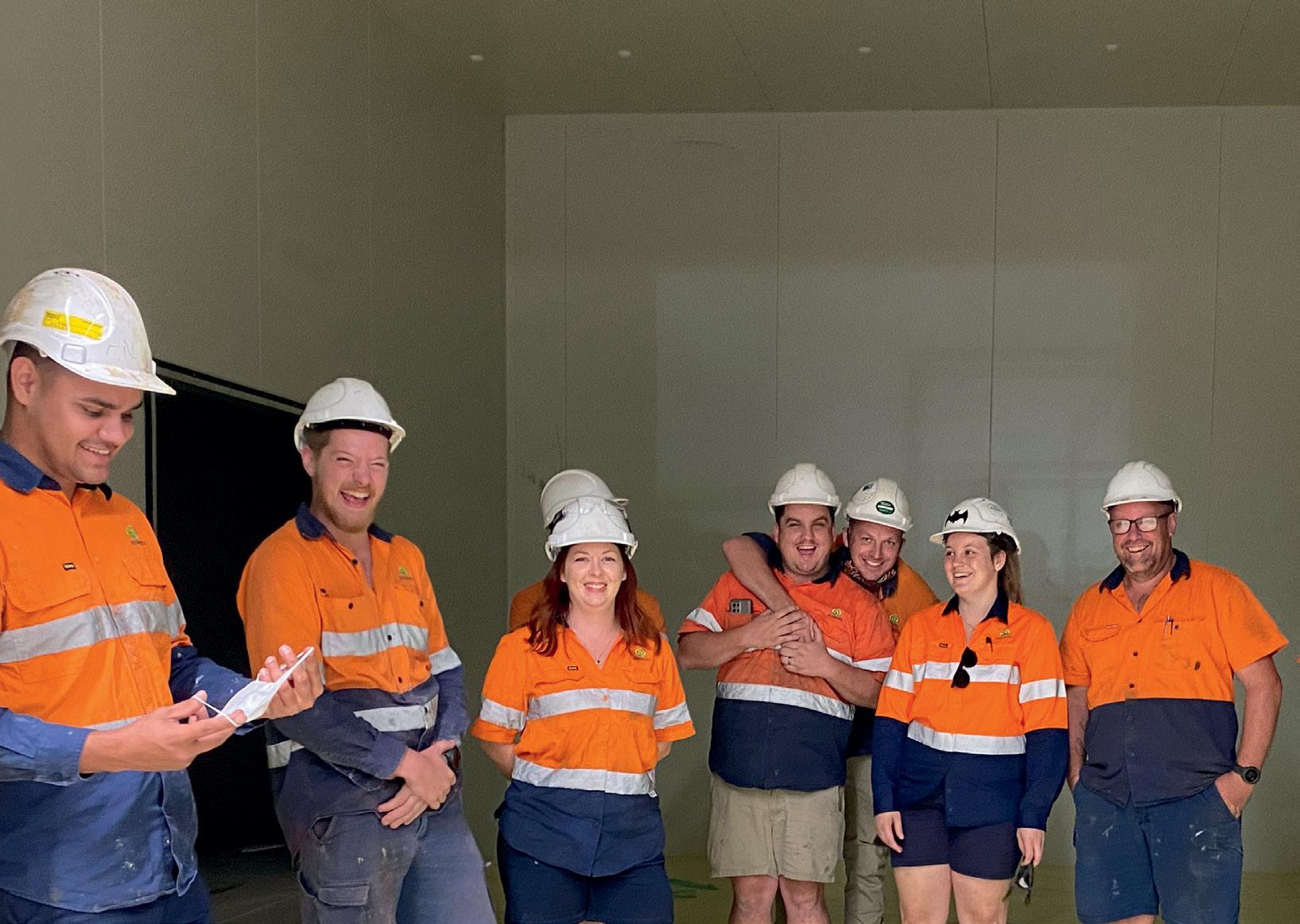
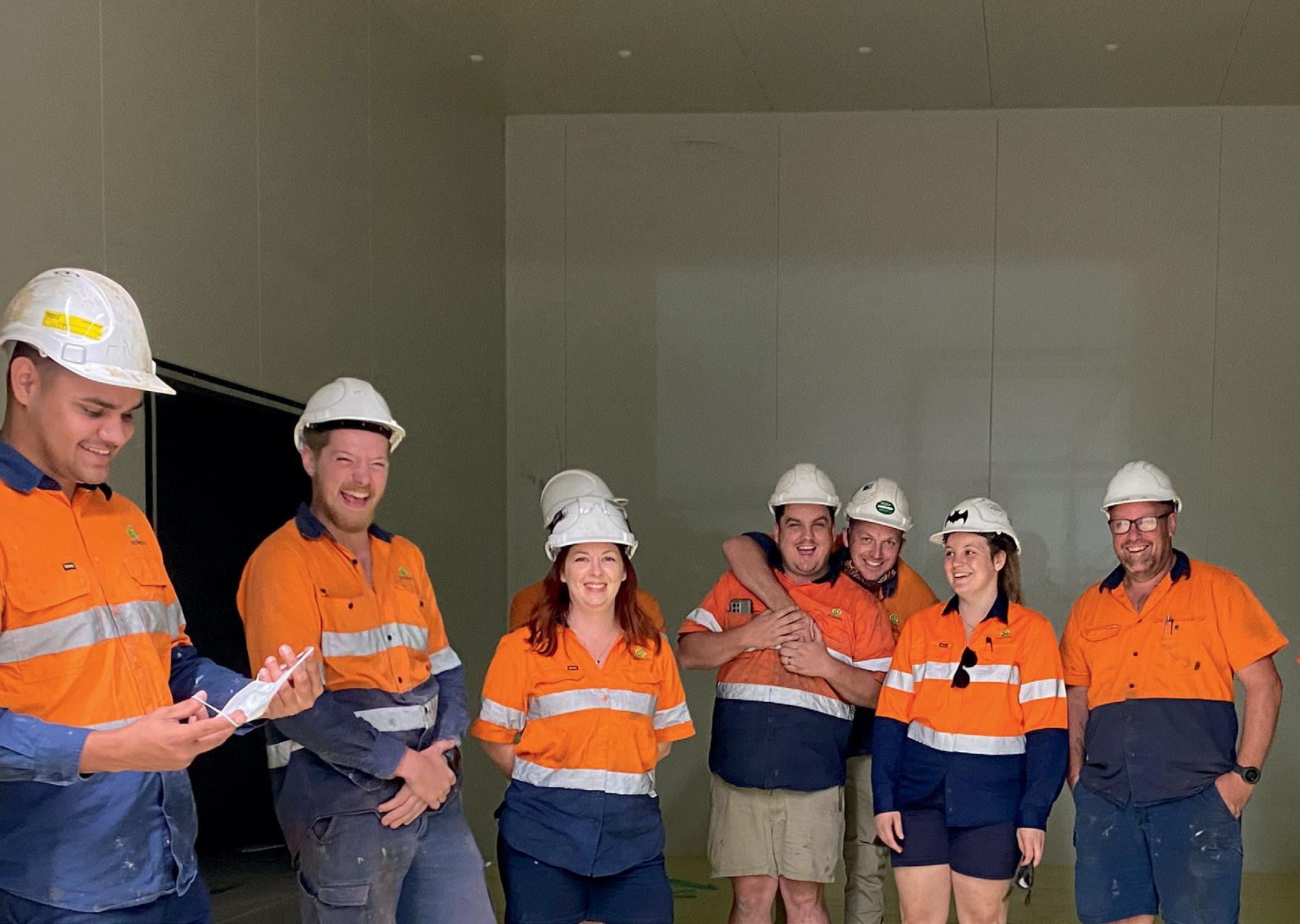
The retail landscape is changing constantly due to technology and innovation. Over the next 10 to 15 years, the demand for skilled refrigeration technicians is anticipated to grow substantially. Our Installation and Facilities Management teams work toward developing industry leading technological solutions to deliver more sustainable refrigeration systems to reach our energy and environmental sustainability goals. As a result, Woolworths launched the Refrigeration Apprenticeship Program in 2020.
This program has since become a successful initiative with a strong commitment to diversity, encouraging women to choose a non-traditional trade and embark on a future as highly-skilled refrigeration technicians.
This program has since become a successful initiative with a strong commitment to diversity, encouraging women to choose a non-traditional trade and embark on a future as highly-skilled refrigeration technicians.
This program has since become a successful initiative with a strong commitment to diversity, encouraging women to choose a non-traditional trade and embark on a future as highly-skilled refrigeration technicians.
This program has since become a successful initiative with a strong commitment to diversity, encouraging women to choose a non-traditional trade and embark on a future as highly-skilled refrigeration technicians.
This program has since become a successful initiative with a strong commitment to diversity, encouraging women to choose a non-traditional trade and embark on a future as highly-skilled refrigeration technicians.
We are proud that:
We are proud that:
We are proud that:
We are proud that:
30% 10.78%
30% 10.78%
We are proud that:
30% 10.78
30% 10.78%
of Woolworths apprentices identify as female compared to an industry average of 1%.
of Woolworths apprentices identify as female compared to an industry average of 1%.
of Woolworths apprentices identify as female compared to an industry average of 1%.
of Woolworths apprentices identify as female compared to an industry average of 1%.
of Woolworths apprentices identify as female compared to an industry average of 1%.
of applicants for the apprenticeship program identified as female, a 3.59% increase from 2021.
of applicants for the apprenticeship program identified as female, a 3.59% increase from 2021.
of applicants for the apprenticeship program identified as female, a 3.59% increase from 2021.
of applicants for the apprenticeship program identified as female, a 3.59% increase from 2021.
30% 10.78% of applicants for the apprenticeship program identified as female, a 3.59% increase from 2021.
45 THE NAWIC JOURNAL 2022
At Woolworths, we not only have a focus on sustainability, inclusion and reducing our environmental impact, we have a genuine and unwavering commitment and drive to better ourselves – and our people – to create a better tomorrow.
Meet: Refrigeration Apprentice
At Woolworths, we not only have a focus on sustainability, inclusion and reducing our environmental impact, we have a genuine and unwavering commitment and drive to better ourselves – and our people – to create a better tomorrow.
Meet: Amy Refrigeration Apprentice
At Woolworths, we not only have a focus on sustainability, inclusion and reducing our environmental impact, we have a genuine and unwavering commitment and drive to better ourselves – and our people – to create a better tomorrow.
At Woolworths, we not only have a focus on sustainability, inclusion and reducing our environmental impact, we have a genuine and unwavering commitment and drive to better ourselves – and our people – to create a better tomorrow.
At Woolworths, we not only have a focus on sustainability, inclusion and reducing our environmental impact, we have a genuine and unwavering commitment and drive to better ourselves – and our people – to create a better tomorrow.
Meet: Amy Murray
Refrigeration Service
Apprentice
Meet: Amy Murray
Refrigeration Service
Meet: Sarah Werth Refrigeration Installation
Apprentice
Meet: Sarah Werth
Refrigeration Installation
Amy is a third-year refrigeration service apprentice and worked in Woolworths Supermarkets as a supervisor for several years. Determined to challenge



Apprentice
Meet: Amy Murray Refrigeration Service
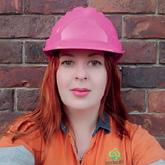


Interested in a career conversation?
Check out our Refrigeration Apprenticeship Program to register for the 2023 apprenticeship intake or visit wowcareers.com.au
Apprentice
Meet: Sarah Werth Refrigeration Installation

Former beauty therapist Sarah is determined to build a bright future for her family. After completing pre-apprentice study at TAFE and building electrical

THE NAWIC JOURNAL 2022
BRADFIELD CITY CENTRE’S FIRST BUILDING
Restoring Women’s Country
Designed by Hassell in collaboration with Western Parkland City Authority and Dr Danièle Hromek of Djinjama, a First Nations cultural research and design practice, the Advanced Manufacturing Research Facility (AMRF), Bradfield City Centre’s First Building in Western Sydney places sustainability at its heart and restores Aboriginal women’s culture as the lifeblood of the land.
Hassell Principal, Board Director and Head of Design Liz Westgarth reveals the inspiration for this female-led design, home to the longest freshwater stream in Greater Sydney known as Wianamatta or ‘Mother Place’ in Dharug.
Honouring the past and continuing connection to the present and into the future, the First Building is a collaborative space for government, industry and research to incubate innovative manufacturing projects. As the name implies, it’s also the first building to be designed for Bradfield City Centre, the new urban region that’s set to transform Western Sydney.
This unique workplace will feature a visitor centre and public viewing spaces designed to showcase the real-time building progress of Australia’s newest, most sustainable, and most connected city.

In the local Dharug language, the area hosting Aerotropolis, where Bradfield City Centre lies, is known as Wianamatta, which means ‘Mother Place’. It’s a site of significance for local Aboriginal women, reflected in the First Building’s open and welcoming architectural expression, a design language centred on ideas of water and fluidity, and the use of warm, soft, natural materials that touch the ground lightly.
A celebration of the meandering and ephemeral water of the Cumberland Plain, the First Building reinstates the site’s permeability, collecting and filtering the building and the site’s runoff across and through a richly planted landscape of Cumberland Plain plant species and water features.
Importantly, in looking at Western Sydney generally and Aerotropolis specifically, Djinjama’s Danièle Hromek, Hassell’s First Nations partner on the First Building, has highlighted water’s particular significance to women:
47 THE NAWIC JOURNAL 2022
“Women have strong enduring relationships with water, from creating watery spaces within their bodies to grow life to having reciprocal care relationships with landscapes of water. Women and their roles in the cycle of life should be honoured in this place.”
An urban pavilion unique to place
Designed around the existing context of Cumberland Plain grasslands and woodlands but also as an urban pavilion in the future context of the city, the First Building is a human scale structure, which acts as a public space providing relief from the density of the surrounding urban context.
As the first building for Aerotropolis, it sets a benchmark for the city to follow based on an ethos of being ‘connected, green and advanced’. It promotes design that is of its place and connected to Country.
Strengthening ecological identity and function
The landscape response to the First Building will demonstrate how contemporary urban landscapes can successfully represent, be informed by, and champion existing ecology and natural landscape. The project will celebrate the Cumberland Plain of Western Sydney by immersing people and their activities within a richly planted, permeable ground plane and rooftop planting of locally, underused plant species. This will play a critical role in re-establishing an ecological identity for the site and set an important precedent for the future development of the Aerotropolis region.
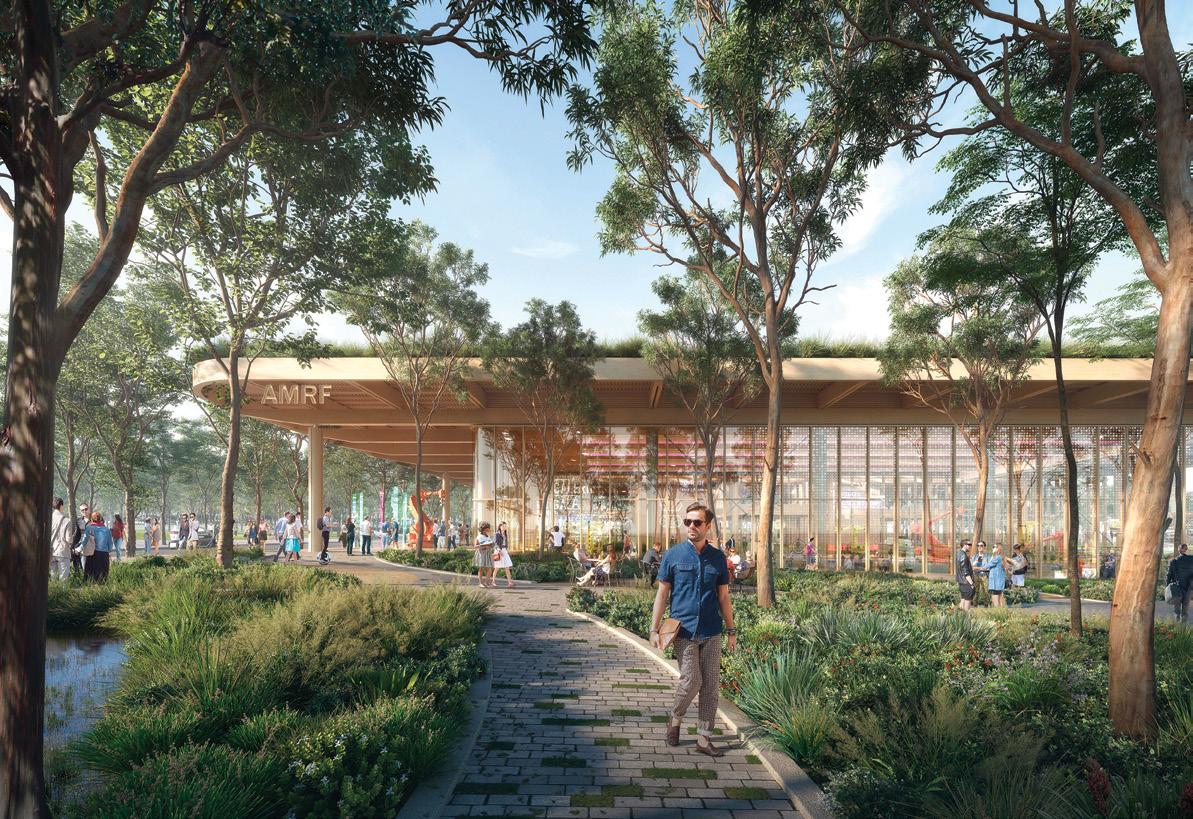
Water and water management is of great significance to this site and its wider context. The First Building adopts a holistic approach to water by capturing and storing rainwater for grey water use and landscape irrigation. Existing water bodies including the longest freshwater stream in Greater Sydney, will be regenerated to promote biodiversity, slow down run off, and allowing for natural filtration into the ground, which benefits the creek’s health.
Circular economy at the core
According to Dr Hromek, designing the First Building represents “a massive opportunity across time and space”. Appropriately, it answers the burning question: what happens when the building outlives its use? Here, we’ve embedded the idea of circular economy.
The building has been conceived as a ‘kit of parts’, its timber structure comprising prefabricated modular components that are mechanically fixed together. These can be disassembled, expanded, or even relocated.
Principal, Board Director and Head of Design, Hassell
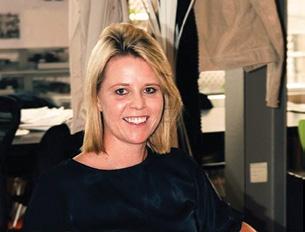
48
Liz Westgarth
MANAGING FLEX TO GROW A CAREER ALONGSIDE A FAMILY
Returning to work as Multiplex’s first part-time Project Manager at first seemed a challenging prospect for Michaela Jones – but four years down the track, the positive outcome has set the precedent for managing flexibility in a senior construction role.
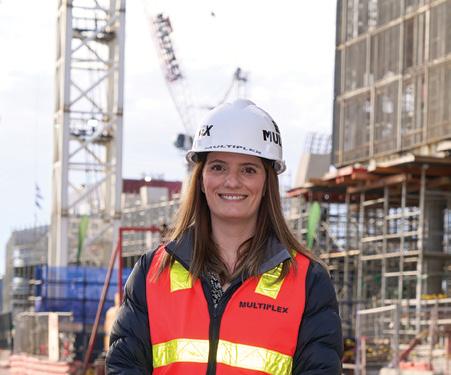
Following a period of parental leave, Michaela worked with her manager to design a part time role that enabled her to retain her chosen career path as a Project Manager, while accommodating her new responsibilities at home.
“At the time it was fairly uncharted territory for us, but I was really supported by the business to explore different options and come up with a solution that worked for me and my team,” she said.
“Having that support and flexibility was extremely empowering, and it’s great to see that thinking continue to manifest in all sorts of ways across our projects.”
Four years on, Michaela has taken a second period of parental leave to welcome twin girls Cleo and Paloma to the family, and is fulfilling the role of Deputy Project Director at the New Footscray Hospital project.
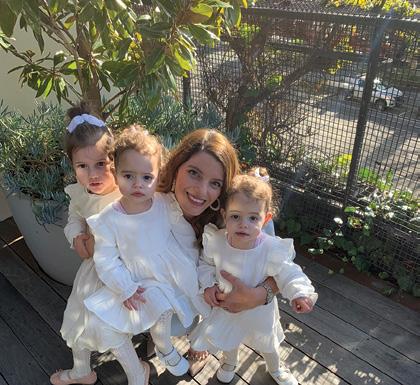
With her lived experience of managing a growing career and family, Michaela has a valuable perspective for mums and dads in the industry.
“Getting the balance right is definitely a challenge but it comes down to giving things a go, communicating and being as transparent as possible with your team, clients and stakeholders. It’s also important to be aware and upfront with your non-negotiables.”
Michaela structures her working week to meet both personal and business needs and is currently working seven days in a fortnight. She explains that creating clear boundaries has been vital to making that structure work.
“My husband helps in the mornings so I’m able to be at work by 7am. But then it’s a non-negotiable that at 4pm I need to leave work to pick up the girls and the team understands that.”
“I’ll often clock on again at night once the kids are asleep, but it’s about managing that expectation with the team that just because I’m online and sending emails because it suits me, doesn’t mean it’s the expectation that it will suit them.”
Michaela admits it was a challenge resetting her own personal expectations.
“I’m the kind of person who wants it all - I want to be a great mum and also want great things out of my career by doing the best I possibly can at work. This can be conflicting at times, especially when you are time poor, you often feel compromised. It comes back to knowing your values and priorities and accepting that not everything can be perfect all the time.”
Multiplex has been rolling out its flexibility program for more than a decade, with the onus on empowering teams to develop
flexible working solutions that work for them and their project. Its parental leave and support offerings are also geared towards continued career progression, with transition coaching and guaranteed superannuation paid during periods of parental leave.
“Multiplex are incredibly supportivenothing is off limits in terms of what I need for my own wellbeing and career development,” says Michaela.
“I’ve never felt that being a mum has hindered me at all. All my challenges are from a personal perspective of making sure I get the balance right and then being able to communicate and pivot if something’s not working.
“I think for these working arrangements to be successful both the employee and the business need to be aligned and invested in making it work - which I am thankful has always been the case for me at Multiplex.”
Michaela’s experience has paved the way for more part time Project Managers at Multiplex and sets a precedent for women industry-wide.
“One of the challenges of achieving gender equity in our industry in that women can feel like they need to sacrifice career development or move into more administrative roles once they start a family. It’s just not the case if you have the right support.
“I would say to anyone in my position, don’t put unnecessary limits on yourself in terms of career pathway or feeling like you can’t take parental leave until you’re at a certain point in your career.
“It’s about trialling different strategies and finding what the right balance looks like for you, your team and your family so you can make the most out of the time you have at work and at home.”
49 THE NAWIC JOURNAL 2022
Michaela Jones
A flexible approach to flexibility
Everyone needs flexibility but the reasons aren’t always the same.
That’s why flex at Multiplex is tailored. We enable our teams to come up with flexibility solutions that work for them – be it working part time to meet family commitments, taking an afternoon off to pursue a passion, or working 5 days in a week.
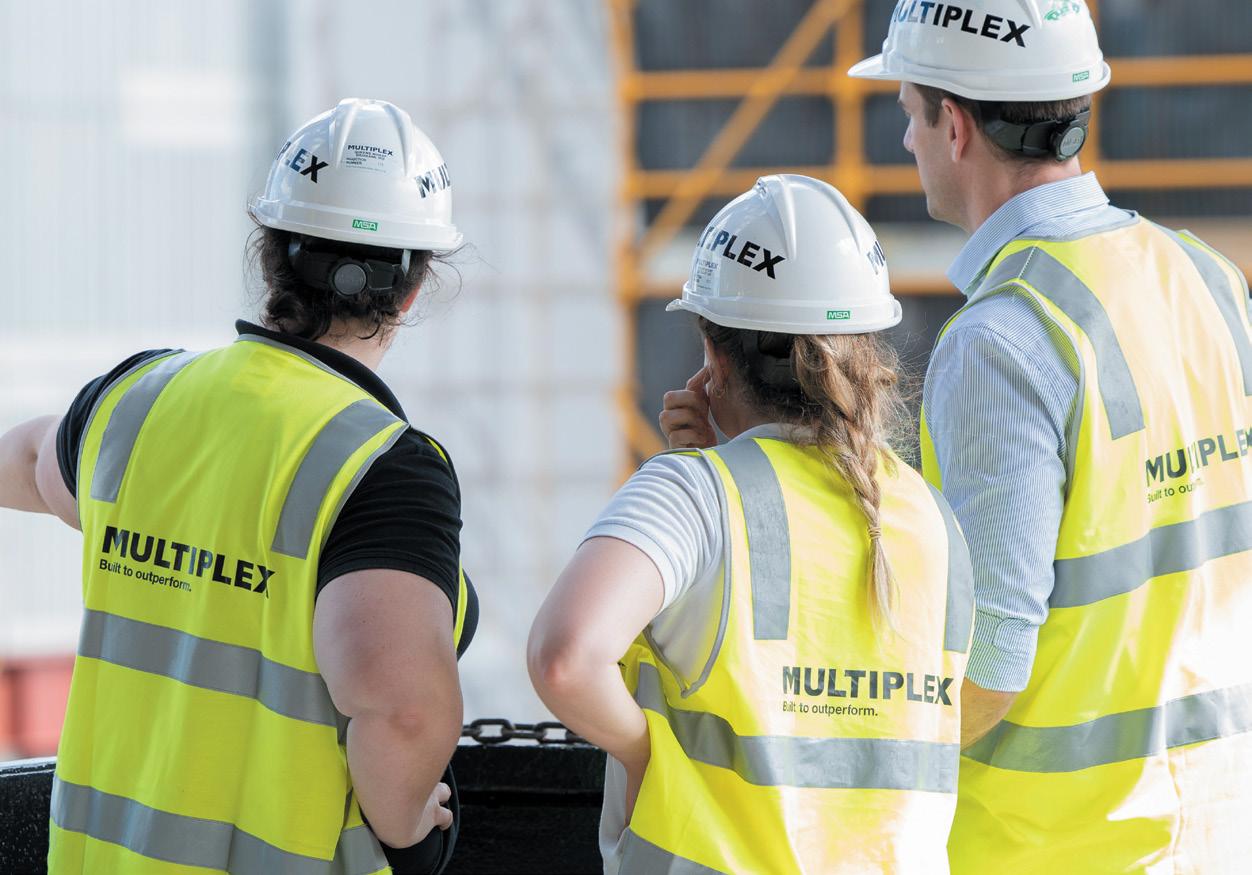
It’s an approach we’ve been researching and evolving for more than a decade. And along with our genderneutral parental support offerings, it has earned us recognition from the Diversity Council of Australia and certification from Family Friendly Workplaces which reflects our commitment to further action.
To date we’ve rolled out tailored flexibility programs on more than 70 of our sites. And we’ll keep tracking our progress and evolving our approach, so our people can outperform at work and at home.
There’s more than one way forward to shape your career

As one of Australia’s largest and most diversified construction groups, Built offers endless opportunities to grow your career.
Our people get real autonomy and the opportunity to lead by example, solve complex challenges and make a real difference.
And our agile, authentic and inclusive culture enables our people to advance our industry forward, create foundations for the future and forge new pathways.
If you’re looking to make your mark join us on our mission to improve the way the world is built. built.com.au
CHANGEMAKERS
Meet the Women Shaping the Future of Our Industry

In every role, within every industry, women bring diversity of thought, new perspectives, and a fierceness to embrace new challenges in their roles.
Research by the Diversity Council of Australia tells us that if you work in a diverse and inclusive team, you’re 11 times more likely to be highly effective and 10 times more likely to innovate1

Three women at Built embody this thinking and are leading the way in transforming construction by laying the foundations for the future of the industry.
Sally Archer, Filomena Beshara and Whitney Forse are leading the way in making our industry more innovative, sustainable and technologically driven than ever before. From very diverse backgrounds and experiences, these women are at the forefront of a rapidly evolving industry and flipping the narrative on a woman’s place in construction beyond just equality, to industry changemakers.
At 26-years-old, for Sally it’s more her age than her gender that often makes industry veterans underestimate her. As a Digital Engineering Manager at Built, her confidence and extensive knowledge of this cutting-edge space almost knocks you over when she delves into specifics.
“I’ve spent a lot of time trying to defend my value to previous organisations because of my age,” says Sally, “but I’ve had experience doing what I do, for almost as many years as Digital Engineering has been around.”
Sally initially studied Construction Management picking up a few digital engineering subjects while working as a cadet quantity surveyor. She never intended to find a passion for Digital Engineering, rather it found her. She graduated and landed a role as a Digital Design Engineer before moving over to Built.
It didn’t take Built long to see Sally’s potential and give her a platform to lead and train others on Digital Engineering.
“Digital Engineering enables teams to access more complete, better information for them to make more informed decisions quicker and help solve issues earlier in the programme.”
Sally’s role didn’t exist at Built five years ago, and it will look vastly different in five more years.
“I see Digital Engineering continuing to evolve and become a part of every team’s day-to-day, business as usual activities. I anticipate that
1 https://www.dca.org.au/research/project/inclusionwork-index-2021-2022
in the future, my own role will focus on exploring new technology and using it to grow our capabilities and further upskill the business.”
This thirst for driving the industry forward, doesn’t just begin and end with Sally.
A student of architecture, Filomena was born and raised in Italy and studied in both Milan and Sydney. After graduating, she took the plunge and moved to New York, where she interned for a boutique architecture firm before being thrown into construction. She quickly grew to love the dynamic
52 THE NAWIC JOURNAL 2022
Sally Archer, Digital Engineering Manager at Built
Filomena Beshara, Sustainability Manager at Built
joining and taking an active role in the Green Building Council in the US. Now at Built, Filomena is leading the way in helping Built pivot towards a Circular Economy.
The Circular Economy aims to retain the value of the circulating resources, products, parts and materials through innovative business models that promote long life, maximise reuse, encourage refurbishment, and boost the use of renewable materials. With 50 per cent of global products produced used in property and construction, it’s a critical step to ensure we curb the overconsumption of our resources.
“We [Built] started to put together a paper on the Circular Economy and in it, we listed some practical steps to make a company more circular.”
“There are things that I would like to see in the next five years on every project of Built’s, things we haven’t done yet. I would like clients, designers and project managers to think of their projects with the end in mind, to retain value out of buildings and their components at the end of their first life cycle.”
Creating a Circular Economy is something that can only be done industry wide, Filomena points out. She hopes that through her work at Built, the industry will also evolve in a way that will embrace this mindset.
While Filomena pushes ahead with evolving sustainable construction, Whitney Forse is etching her name into Sydney’s future skyline.
After studying Quality Surveying, she began working as a Contracts Administrator (CA), and progressed her career in London, before joining Built in 2017. She worked up to a Contracts Manager role through experience across some of Built’s largest Sydney projects, including the luxury residential tower One30 Hyde, the major Star Casino expansion and the innovative commercial building, 3 Parramatta Square. While working on the latter, Whitney was also engaged in the Early Contract Involvement (ECI) for Atlassian’s Sydney HQ.
Whitney’s career then took a turn not often seen by someone with her commercial background, stepping into the role of Project Manager (PM) for what is arguably the world’s most innovative and sustainable building.
“With project management it’s more of a challenge because you have to have an understanding of the commercial contractual side, but you’re also dealing with all of the daily site challenges, design and other elements,” Whitney explains.
It’s a career path Whitney admits she’s never really seen anyone else take quite like this. While engineers tend to be more production and
program driven, those coming from a CA background tend to have a greater understanding that “every dollar counts”.
“That’s a great asset and skill to bring to a PM role, because you’ll always be able to challenge those around you to find a more cost-effective means.”
The high-profile Atlassian project has been a mammoth task to take on, but Whitney’s background and work on the ECI has meant she’s been able to step into her role on the project with the confidence and background knowledge rarely held by other PMs.
The world’s tallest hybrid timber building has ambitious sustainability targets including aiming to produce 50 per cent less embodied carbon in construction than a conventional commercial building, which has never been done before, by anyone, anywhere. For Whitney, creating procedures to track and establish the baseline for the building’s embodied carbon target has been second nature.

Individually, Whitney, Filomena and Sally are each paving a way for the future of construction. Unknowingly together, they are inspiring other women to forge their own path and chase more challenging, change-making career paths.
Their advice to other women in the industry looking to follow suit is to stay confident, ask questions, be open to new and less obvious opportunities and challenge appearances.
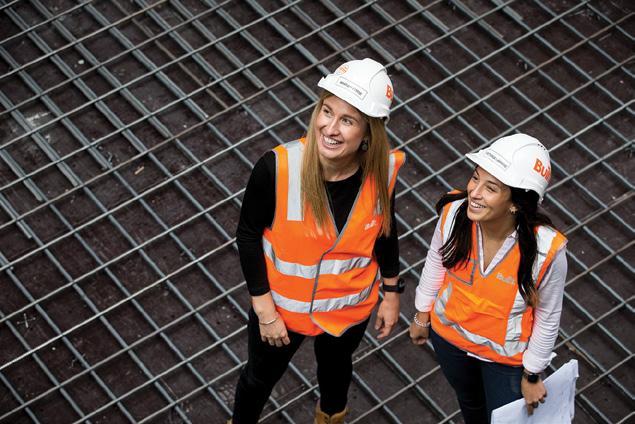
Melissa Kehagias
53 THE NAWIC JOURNAL 2022
Whitney Forse, Project Manager at Built
Atlassian’s Sydney HQ

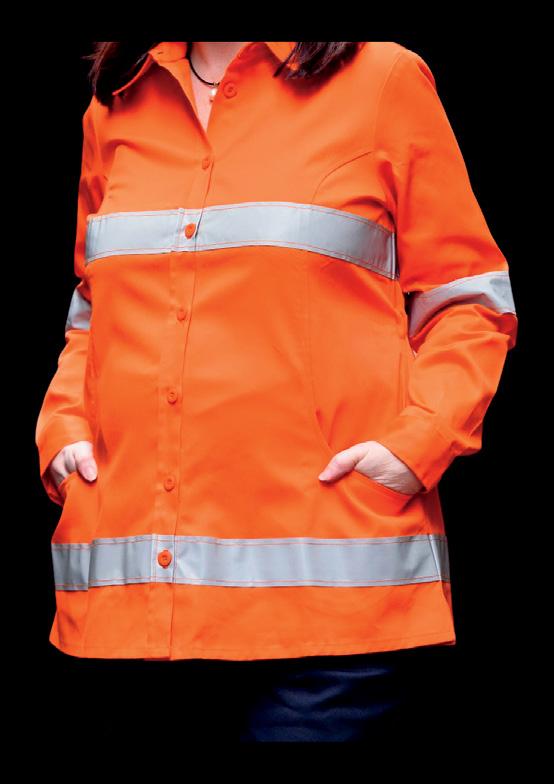



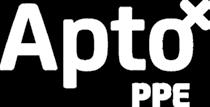


54 THE NAWIC JOURNAL 100% Australian made & designed AS 4602 hi vis safety garments www aptoppe com au Tel 1300 337 999 WOMEN'S & MATERNITY HI VIS WORKWEAR Engineered for safety & comfort. Parental Leave Pause LET US KNOW Contact NAWIC administration to update your details.
JUGGLING MOTHERHOOD
Iwon’t lie to you, being a working mum is tough. On any given day I wear several hats; mum, wife, employee, friend, daughter, sister etc. I constantly feel like I am failing at each one. Even sitting here writing this article I am thinking about the ten other things that I should be doing instead. I am sure many other parents feel the same but then again other people might not. That is the beauty of motherhood. It is a unique experience for each person and here is a bit of insight about mine.
I have a 2 year old daughter who has brought immense joy to my life but has turned it upside down in the process. She is a little firecracker. Sure, some days I wish I could lie in bed and just read a good book, but I am so grateful for the life I have.
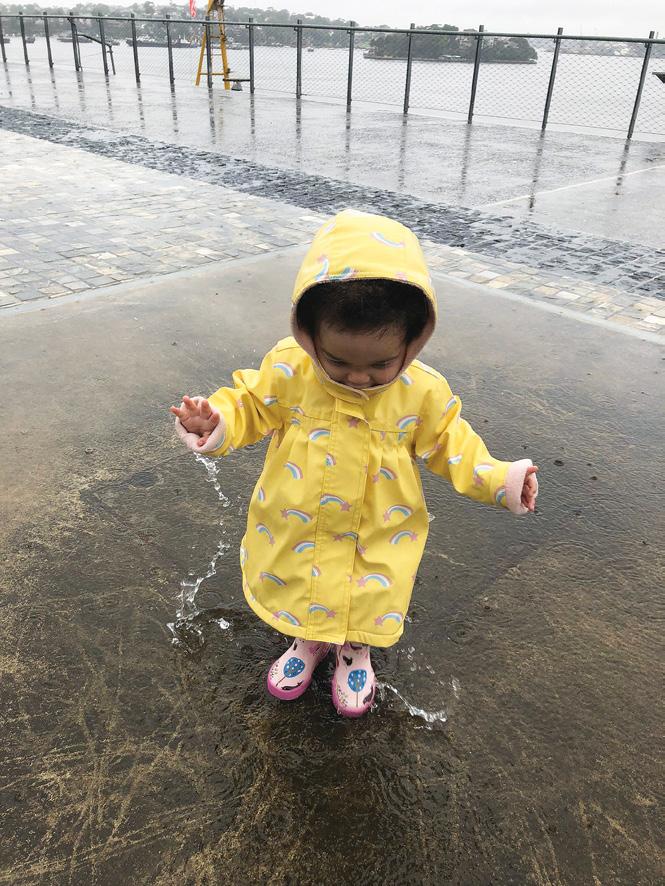
Introduction of maternity leave policies in the construction industry needs to increase
When I found out I was pregnant I wondered how I would cope; both financially, and emotionally. How it would affect my career, how long I should take maternity leave and about what pay I would (not) receive during that time. I was on a temporary VISA so had no entitlements. I knew the company I was working for thankfully had a paid maternity leave policy (12 weeks full pay). The Workplace Gender Equality Agency’s 2020-21 employer census1 found that just 43% of construction companies offer paid parental leave. Those statistics explain why women fail to enter and remain in the construction industry and needs to change.
A different way of working
I found it tough returning to work at first, my daughter crying at daycare drop off, managing sleep deprivation, dealing with a new routine, leaving work in time for pick up and the many illnesses that crop up with having a child at daycare. On the plus side returning to work meant I could have adult conversations, use my mind in a different way and finally go to the loo in peace!
Part time working offered me benefits in terms of increased amount of family time, however there are the pitfalls of reduced pay, managing my workload over less days and wondering how being part time would affect any future chances of promotion.
Grab that opportunity!
I returned to work with a different perspective and outlook on my career. My desire and passion to succeed was ignited, my confidence and belief in myself has grown. I feel more determined to succeed as a Woman of Colour in the construction industry. According to The WGEA 2020-21 employer census the industry gender pay gap is 30.6%, WGEA states that women from “diverse groups can face multiple and compounding disadvantages when participating and progressing in the labour force.” 1 It makes me grateful for organisations such as NAWIC and Women of Colour Australia who are working on improving diversity and inclusion in Australia.
Women often play it safe, are afraid to take up new challenges or may feel that they are not good enough. As women we need to have more belief in ourselves and grab every opportunity. This is the reason I took up a new role as Associate Director at RPS, where I will be part of helping to grow the newly established Cost Advisory Team. I am excited and looking forward to this new challenge.
1 WGEA’s dataset is based on reports submitted in accordance with the Workplace Gender Equality Act 2012 for the reporting period 1 April to 31 March. Under the Act, non-public sector employers with 100 or more employees must submit their gender equality metrics to WGEA annually. https://www.wgea.gov.au/publications/australias-gender-equality-scorecard
55
Motherhood is a superpower
I believe being a mother is a superpower. Companies should embrace mothers in their organisations as they have many heightened skills that would benefit workplaces.
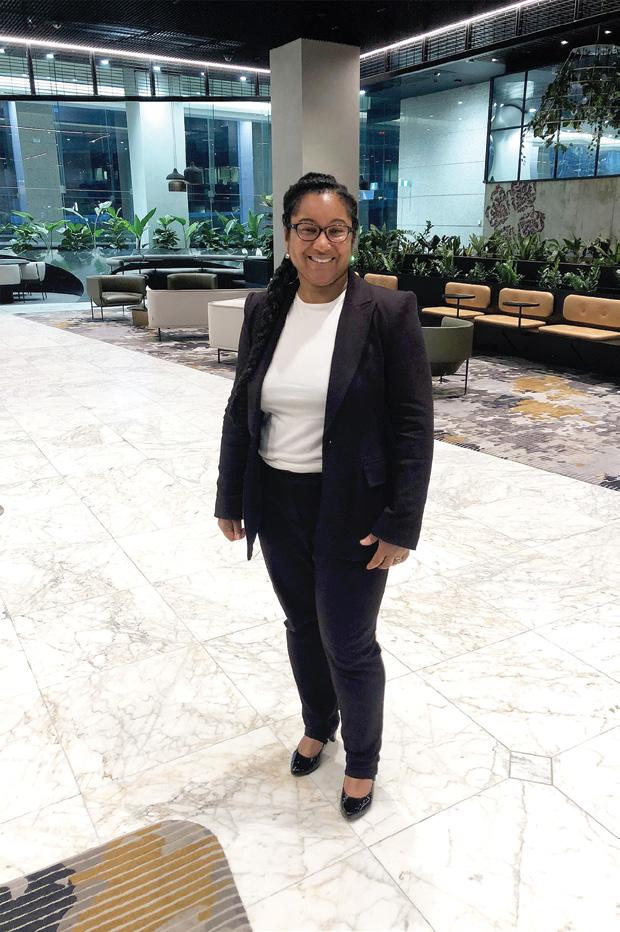
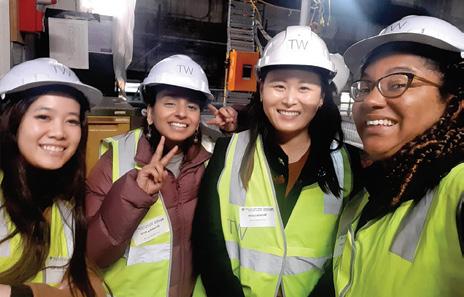
⋅ Organisation and prioritisation skills – As a parent being organised is vital. There is a lot of juggling involved. I project manage the day as best I can so that I can be as efficient as possible. Sometimes things may be missed e.g. when I arrived at daycare and all the children except my daughter were dressed up for book week … It felt like an epic fail!!
⋅ Time management – My time management has improved greatly as due to working part time I have a reduced amount of time to meet due dates and ensure my clients are happy. However, the unexpected can happen e.g. an unplanned daycare closure. It was stressful thinking of what we would do, how we could cope managing work and childcare. We were fortunate to find temporary childcare a few days later, that turned permanent as our daughter thrived there. A blessing in disguise.
Dream big
As women we must not be afraid to dream big. The possibilities are endless in the construction industry. Companies need to ensure they are doing enough to attract and retain women. This could be by offering paid parental leave (for both parents) or by providing a flexible working environment. I was once asked what is my priority, my family life or my career? I responded by saying both. I do not believe that because I am a mum that I can no longer focus on my career. Both family and a career are important to me and focusing on both makes me a better parent and employee. I want to set a good example
⋅ Negotiation skills – I have become very adept at negotiating with a 2 year old so having to deal with full grown adults is a piece of cake!
⋅ Empathy – I have always enjoyed socialising and meeting new people. I believe that I now have even more empathy for others and I am more acutely aware of how people are feeling. This can only be a benefit in a company where you have a diverse mix of people.
THE NAWIC JOURNAL 2022
Leonie Quinn, Shraddha Birla, Nichole Louie & Vanessa Hetherington.
WILSON ENVIRONMENTAL COMPLIANCE SUPPORTING WOMEN SUPPORTING CONSTRUCTION SUPPORTING THE ENVIRONMENT








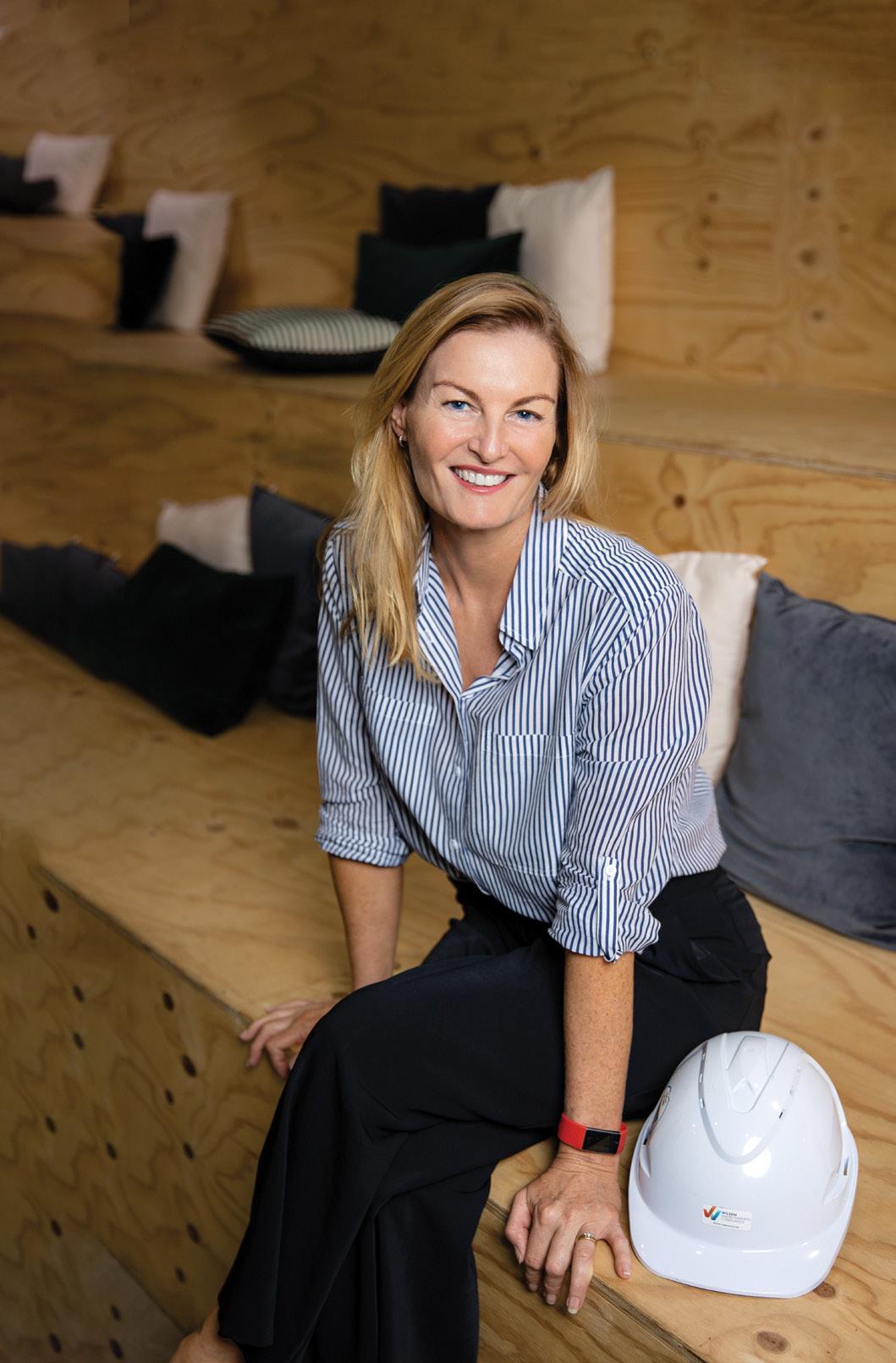
Protection for your project, your client, and your community.
Wilson Environmental Compliance works with builders and developers to manage environmental risks, evaluate environmental performance, and identify cost savings.
 Brisbane | Gold Coast | Sydney
Founded in 2018 by Rosalyn Wilson
Brisbane | Gold Coast | Sydney
Founded in 2018 by Rosalyn Wilson
TRANSFORMING LIVES
Why Sustainability Must Strike at the Heart of Our Projects
employee strives for every day. Our people delivering infrastructure have immense power to improve the lives and the liveability of the communities in which they work.
This has been illustrated in many of NWPA’s projects including the Bell to Moreland Level Crossing Removal Project, which has transformed a divisive rail corridor in Melbourne’s inner-north into acres of active recreation spaces that connect the community.

Bell to Moreland also set new industry benchmarks by receiving the highest ‘As Built’ rating ever in the history of the Infrastructure Sustainability Council (ISC) and being awarded the first 6-star Green Star train station built in Australia.
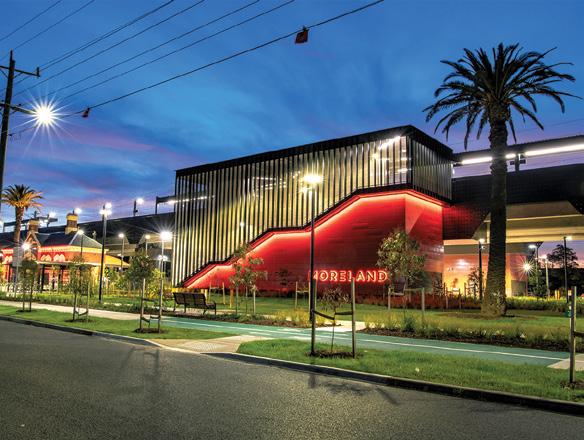
So, what’s the biggest opportunity for sustainability to continue delivering excellent outcomes?
Embedding sustainable principles and practices within infrastructure projects is crucial given the major global environmental and social challenges we are currently facing.
The projects we build today must be restorative, drive positive change and serve generations to come.
It’s for this reason that sustainability is no longer just an ‘option’ or after thought, but at the forefront of project design and delivery. As a sector, its scale and impact continue to grow year on year.
I have been an active contributor to this growth having spent almost 15 years working in the industry with John Holland.
I am currently the Sustainability Manager on the North Western Program Alliance (NWPA), working on Melbourne’s Level Crossing Removal Project program. It was only seven years ago that I delivered the first Infrastructure Sustainability (IS) rating as a team of one – and now proudly lead a team of 10 sustainability professionals to deliver significant carbon reduction savings.
While this is the decade of climate action, sustainability is not just about carbon – it’s about delivering positive legacies that transform people’s lives.
This is John Holland’s purpose, and in that way, sustainability is at the heart of what every John Holland
We need to collaborate, not compete. We don’t have time to squander on competing against each other. Instead, we need to actively seek opportunities to partner, collaborate and share knowledge, at speed, in order for the industry to move from sustainability to regeneration as quickly as possible.
Sustainability Manager, North Western Program Alliance
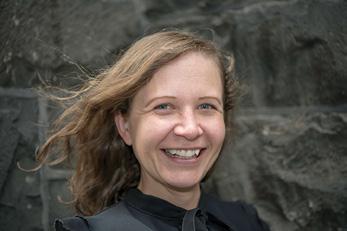
58 THE NAWIC JOURNAL 2022
Fiona
Bowie
Transforming Lives
Transforming Lives
Transforming Lives




From the epic, to the intimate, everything we do improves life for someone, somewhere.
While our competitors talk about what they do, we focus on why we do it.
From the epic, to the intimate, everything we do improves life for someone, somewhere. While our competitors talk about what they do, we focus on why we do it.
We believe in delivering positive change for individuals and communities.
From the epic, to the intimate, everything we do improves life for someone, somewhere. While our competitors talk about what they do, we focus on why we do it.
We believe in delivering positive change for individuals and communities.
We believe in transforming lives.
We believe in delivering positive change for individuals and communities.
We believe in transforming lives.
We believe in transforming lives.
Our commitment to transforming lives extends to those who work for us and the community in which we operate. We know the future is important for all of us.
Our commitment to transforming lives extends to those who work for us and the community in which we operate. We know the future is important for all of us.
Our commitment to transforming lives extends to those who work for us and the community in which we operate. We know the future is important for all of us.
At John Holland we proudly support and celebrate women through initiatives like ensuring gender pay equity flexible working arrangements, generous paid parental leave, our mentoring program for women on projects, and leadership programs.
At John Holland we proudly support and celebrate women through initiatives like ensuring gender pay equity flexible working arrangements, generous paid parental leave, our mentoring program for women on projects, and leadership programs.
At John Holland we proudly support and celebrate women through initiatives like ensuring gender pay equity flexible working arrangements, generous paid parental leave, our mentoring program for women on projects, and leadership programs.
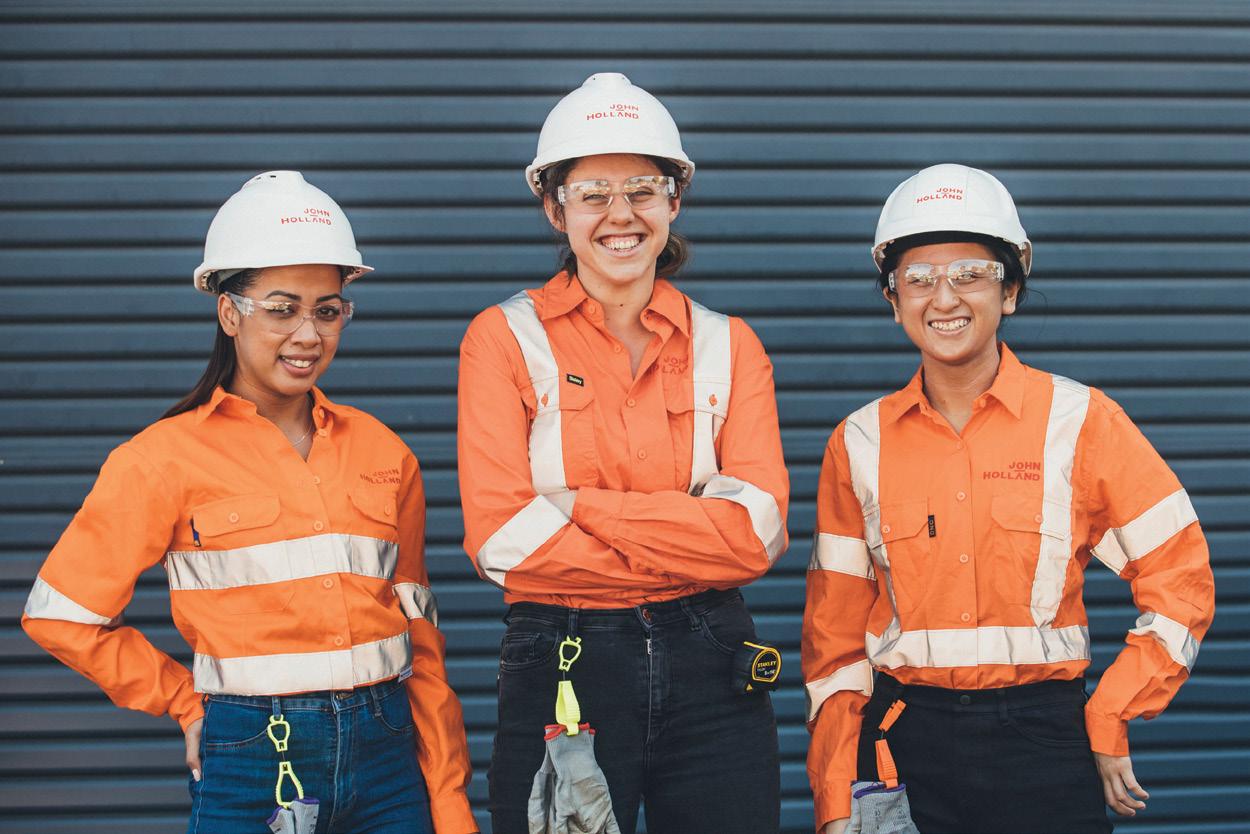
johnholland.com.au
SWITCHING ON CUSTOMERS & YOUNG WOMEN TO ACHIEVE #25BY2025
– with 3 Pillars & a Bulldozer
NAWIC and industry supporters are relentless in their quest to attract more women into the construction industry. The #20by2025 plan with its three pillars of action is testament to the strategic and determined advocacy that NAWIC is renowned for.
NAWIC and advocates are making headway under the three key pillars:
⋅ Advocacy and lobbying for change.
⋅ Education for individuals, companies and industry as a whole.
⋅ Connection, Celebration and Support for all women in construction through our membership Community. Despite determined efforts the composition of trade-qualified women in construction remains entrenched at around 2%.
To shift the 2% into double digits will require three pillars and a bulldozer. That ‘bulldozer’ is a metaphor for digging up deeply embedded gender stereotypes and barriers blocking the pathway for women and girls into male-dominated trades, and laying new foundations.
Shifting the intractable 2% with young women and the public on board.
We know that every year more industry and government leaders step up to drive the bulldozer.
What we don’t know a lot about is what customers who call on a ‘tradie’ think. Do they, and in particular, female customers think twice that 98% of the time a man arrives with his van and toolbag?
We also don’t know a lot about whether young women are aware that construction trades are 98% male-dominated and that they pay much more than female-dominated trades, like hairdressing. Do they thinks it’s a problem that needs to be fixed?
The public — the customers— are quiet. Young women are quiet on this issue. It’s hard to find robust research that provides women’s responses to the questions:
Dr Karen Struthers completed her PhD research into Pathways into Male-Dominated Trades for Women to maintain the momentum for change. As a former Minister for Communities, Housing and Women in Queensland Karen led the groundbreaking Girls in Hard Hats and Women in Hard Hats programs with the support of NAWIC and other industry groups. Email: k.struthers@griffith.edu.au
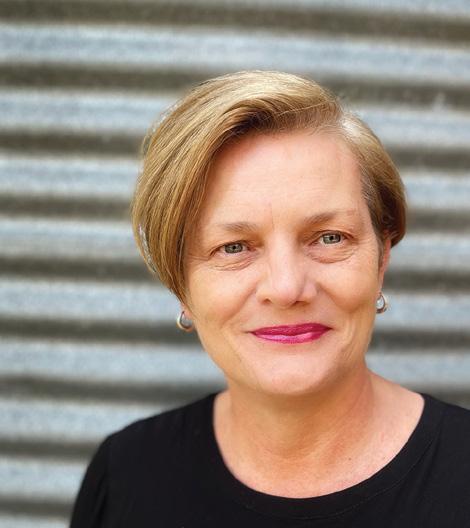
a. Would you like the choice of having a female or male tradesperson?
b. Do you consider it a problem that women make up 2% of trade-qualified workers in construction trades?
c. Would you feel safer with a female tradie in your home?
A survey reported that almost one in three women in the UK say they would feel safer hiring a tradeswoman to do a home improvement or maintenance job in their home.
As an activist, a researcher and former Member of Parliament and Minister leading the Women in Hard Hats and Girls in Hard Hats government programs I became acutely aware that reform gets a good nudge along when a groundswell of public and media support swing in behind it.
Agenda-building theory and experience shows us that government or industry will rarely invest substantially in major reforms unless there is a sustained call from the public that a troublesome issue needs a fix.
Advocates of gender equality in construction view the intractable 2% as a big problem, but young women or the general public do not seem have this issue on their minds.
Advocates know that attracting and retaining women in male dominated trades is one of the ‘tools’ needed to fix skills shortage — it will be good for industry, good for the economy and good for women.
As advocates, we also assume it will be good for customers.
60 THE NAWIC JOURNAL 2022
Until the public as the consumers of trade services switch-on to the intractable 2% —and consider the invisibility of women in male-dominated trades as a problem — change will remain painfully slow.
Until young women themselves, and parents, educators, see and experience the ‘concrete barriers’ that block the pathway for girls and women into male-dominated trades, they will remain switched-off to the issue.
Unless they see that entrenched gender stereotypes, fear and intimidation are blocking young women from pursuing male-dominated trade careers, and that these barriers are also blocking their access to higher paying, secure trade careers, little will change.
How do we get the public and young women to step up on to the ‘bulldozer’.
The NAWIC #25by25 features a range of essential actions for change. Initiatives like “Put gender on the tender”, Male Allies Program, try-a-trade, industry lunch box sessions, mentoring, industry plans, events and awards and the increasing media profile are all pushing change along in the right direction.
My PhD research at Griffith University featured the views of young people in schools on the question: why do so few girls and women choose male-dominated trade careers. Overall, most young women had not thought about whether it is a problem that construction and related trades are 98% male dominated.
Young women did say that they would like more hands-on experience of the trades, and more women tradies to come to their schools. Many said comments like girls would consider a career in a male-dominated trade if it was “more open to us.”

The comments of the young women are consistent with other research and experience showing that myths and stereotypes about trades are common:
⋅ “Those trades are for the guys who aren’t academic.”
⋅ “In these trades the guys get around with their bum-cracks hanging out.”
⋅ “Only one or two girls do it, so you feel intimidated to try it.”
⋅ “Our teachers didn’t even tell us about the try-a-trade session, only the boys went.”
While this mind-set and gender stereotypes prevail, very few young women think about pursuing a male-dominated trade nor are they joining in a call for change. Great young tradeswomen are mentors, but with only a handful of them in any given region, their capacity to reach out widely to young women is limited. There’s no high profile social media action by young women.
Dr Karen Struthers at an industry ‘try-a- trade’ event to promote women into trades
The data showing the chronic shortage of apprentices and trade-qualified construction workers is helping to build the case for #25by2025 in industry and government.
The data showing the lower wages in female dominated trades and negative impact of the gender pay gap on women is also compelling and winning over advocates to join the call for change.
The most compelling case for change will come when young women themselves switch-on, get the facts, and join experienced adult advocates as agents of change.
This will require large scale, intensive and creative communications strategies. Defence Australia recruitment have been making the male-dominated jobs cool for women with their investment in advertising.
It’s unlikely that Kylie Minogue will dust off her overalls again as Charlene the mechanic in Neighbours and make it cool to be a tradie in a male dominated industry — but wouldn’t that help to move things along.
For those of us who are on a mission to advance the economic security and personal safety of girls and women, that bulldozer is moving way too slowly.
Dr Karen Struthers
Adjunct Research Fellow
Department of Health Sciences and Social Work
Board Member, Menzies Health Institute Queensland Griffith University, Logan
61
Transforming the future of global real estate


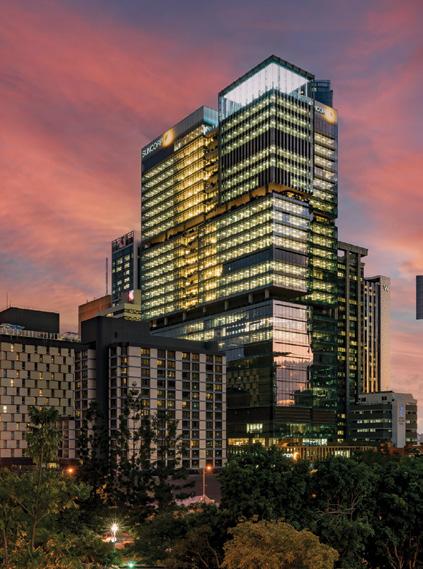
Take the next step with Altus


We’re investing in new technologies and techniques that are transforming the world of real estate. It’s the next step for the industry and for Altus. Why not make it the next step for you?
Benefits include:
• Employee recognition program
• Parental and maternity leave benefits
• Return to work transition support
• Flexible work
Find out more at altusgroup.com/careers
Altus Group joins an elite list of 47 organisations across the country that have been awarded the title of ‘Inclusive Employer’ by Diversity Council Australia for 2021-2022.

62 www.ancr.com.au FREE SUBSCRIPTION FOR NAWIC MEMBERS best integrated AUSTRALIAN NATIONAL CONSTRUCTION MAJOR PROJECT REVIEW HERITAGE LANES MIRVAC’S ALSO INSIDE LENDLEASE CREATING CARBON FREE CONSTRUCTION SITES CBUS PROPERTY AND MULTIPLEX 83 PIRIE STREET HERITAGE LANES DYNAMIC MASTERPIECE IMPRESSES QUEENSLAND THIS ISSUE ECHUCA-MOAMA BRIDGE PROJECT McConnell Dowell MELBOURNE BMW DEALERSHIP & SHOWROOM Hansen Yuncken IGLU FLAGSTAFF GARDENS STUDENT ACCOMMODATION Kane Constructions HERITAGE LANES Mirvac THOMAS DIXON CENTRE Hansen Yuncken GEMLIFE MAROOCHY QUAYS GemLife 83 PIRIE STREET Cbus Property AMARA CITY GARDENS Iris Residential and BGC THE GRIFFIN Amalgamated Property Group BB6 – 6 BRINDABELLA CIRCUIT Construction Control ACE HOTEL Hickory CASTLE RESIDENCES Hutchinson Builders SKY RESIDENCES GWH CRICKET CENTRAL Cricket NSW and MotsynCopper ST MATTHEWS CATHOLIC SCHOOL North Construction & Building THE SIDING PETERSHAM Deicorp MELROSE PARK – PULSE & PAVILION Parkview AUSTRALIAN NATIONAL MAJOR PROJECT REVIEW CONSTRUC TION MCCONNELL DOWELL ECHUCA-MOAMA BRIDGE PROJECT Scan the QR Code below or email ancr@ancr.com.au and claim your free subscription to our quarterly publication and to be added to our e-newsletter. The Australian National Construction Review is Australia’s leading publication for major construction projects and showcases the most impressive major developments. Do you have a project, media release or a property you would like to feature in the Australian National Construction Review, e-newsletter or on our social media? Let us know via the QR code above.
2021 NAWIC awards for excellence

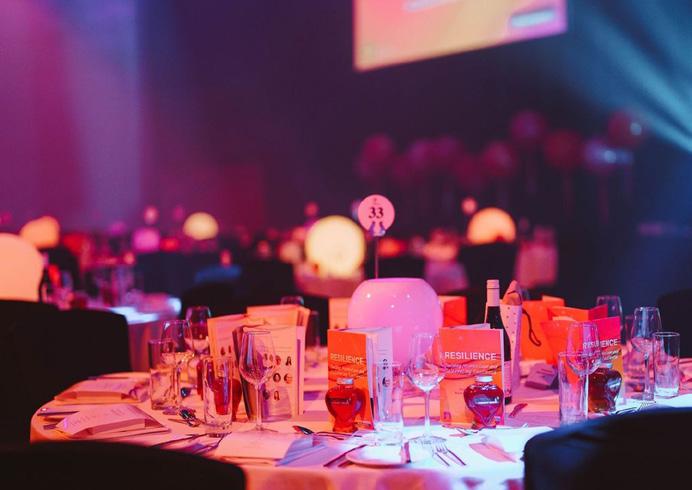

2021 NAWIC WA awards for excellence
Optus Stadium, Perth WA
12th November 2021
CURTIN UNIVERSITY
EXCELLENCE IN SUSTAINABILITY AWARD
Winner: Kristina Masanovic, Instant Waste Management
Kristina is the brand and digital marketing manager at Instant Waste Management (WM), the only privately-owned waste and recycling provider in WA. Within her time at IWM she has not only achieved business objectives but implemented new sustainability initiatives within the company and externally, including engagement events, advocacy and working with the management team to embed the UN Sustainability goals within their business.
STANTEC DIVERSITY & INCLUSION AWARD
Commendation: Amanda Pearce, Aurecon
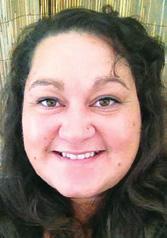
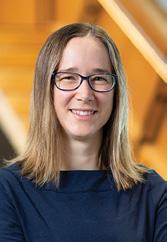
Amanda is a structural engineer at Aurecon. Along with her day job, she remains passionate about diversity and inclusion, and inspiring the next generation of engineers. She contributes to this vision by being an active member of ‘Aurecon Women’, including initiating a ‘blind CV’ review, as well as her role as the Diversity and Inclusion Chair of Engineers Australia, and as a long-serving volunteer of EngTalk – where she visits high schools across WA to inspire girls to pursue a career in engineering.
STANTEC DIVERSITY & INCLUSION AWARD
Winner: Jaime Rayson, Fulton Hogan
Jaime is the Aboriginal Participation Coordinator for Fulton Hogan Western Region. She is a Noongar woman from Kaneang people and the Wagyl Keip language group. Jaime has supported and driven Fulton Hogan’s commitment to truly affect social change by striving for and exceeding the intent of government policy and
contractual obligations. Jaime has worked with Fulton Hogan team members and subcontractors to truly understand Aboriginal culture, and build connections with the community. Under Jaime’s leadership, Aboriginal employment has grown to 7.5% of their workforce, and the number of Aboriginal businesses in their supply chain has increased from 1 to 22.
HASSELL EMERGING TALENT AWARD
Commendation: Claire Woodward, Lendlease
Claire is a Site Engineer at Lendlease, working on the Curtin University T.L. Robertson Library Upgrade. She graduated in 2020 from The University of Melbourne with a Bachelor of Design double major in Architecture and Construction Management. Since joining the project, she has gained the respect of not only team members but subcontractors and construction teams. Her capacity to provide clear direction and lead teams to complete tasks in all aspects of safety, programme, quality, and sustainability has been exemplary.
HASSELL EMERGING TALENT AWARD
Winner: Anna Htun, Broad Construction

Anna obtained a Bachelor of Civil and Construction Engineering at Curtin university.
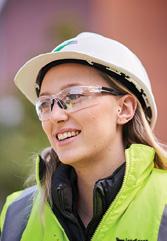
During her studies, she joined Broad as an undergraduate then joined the CIMIC group graduate program upon completion of her degree. She has worked on numerous projects including $150M Casuarina Prison Expansion (Stage 1 & Stage 2), $60M Karingal Green Aged Care facility, $40M Highgate and Inglewood retail facilities. Anna is currently working as a Graduate Engineer on $1Bn NEWest Alliance Metronet project as part of the Yanchep Rail Extension team. Her team acknowledges her innovation and dedication, and describes her as an “inspiration for all Broad employees and females in the construction industry”.

64 THE NAWIC JOURNAL 2022
ARUP SOCIAL RESPONSIBILITY IN CONSTRUCTION
AWARD
Winner: Kim Michelle Raysmith, Turner & Townsend
Kim is an associate director and senior project manager at Turner and Townsend, mother of two young boys, and in her spare time launched ‘Reconstruct Drinking’ –providing free educational talks to organisations in the construction industry to raise alcohol awareness and help people understand their relationship with alcohol. Reconstruct Drinking encourages companies to create a better drinking culture and unravels the science and social influences of habit and addiction. Kim values every opportunity to give back to the construction industry and community particularly in health and wellbeing, including mentoring, mindfulness and teaching free yoga classes.
BUILT TRADESWOMAN OF THE YEAR AWARD
Commendation: CJ Deveraux, Civilspec Resources
CJ has been an excavator operator for the past four years, after becoming fascinated by the machinery during her labouring work as a drainers offsider. Now, she loves the comradery in her work environment and is widely acknowledged for her skills and competence. She wants to forge a path for other women to embark on their trades or operator careers with acceptance, equality and support.
BUILT TRADESWOMAN OF THE YEAR AWARD

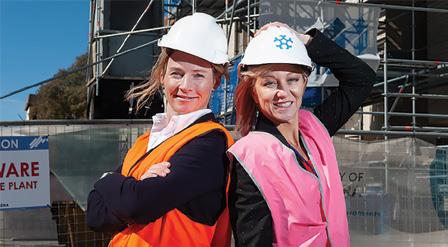
Winner: Alysia Anne Harper, Cubic WA

Aly is a qualified carpenter, currently working on Chevron at 1 The Esplanade in Elizabeth Quay. Aly was the first female to win MBA’s coveted ‘Apprentice of the Year Award’, amongst numerous other awards, and has been featured in various media segments promoting women in construction. Aly’s interest in construction started with DIY projects alongside her regular, comfortable 9-5 job – at which point she decided to retrain in carpentry as a mature aged student. She describes it as the best decision she has ever made – settling into a thriving industry where she could learn and build things people would enjoy for many years to come. Her vision is to normalise women on site, and women on the tools, and promote balanced and diverse environments for everyone.

ADCO TRAINEE APPRENTICE OR STUDENT OF THE YEAR AWARD
Second Commendation: Olivia Hurley, Laing O’Rourke


Olivia Hurley entered the world of construction as an intern with Laing O’Rourke on Main Roads’ Armadale Road to North Lake Road Bridge Project, Cockburn. Now part of a small planning and project controls team, she tackles challenges head on and works with a diverse team to deliver great outcomes. Following her first placement, Olivia was presented with an opportunity to join the engineering team on Main Roads’ Thomas Road Over Rail (TROR) Project, which forms part of the greater METRONET Byford Rail Extension Project.
ADCO TRAINEE APPRENTICE OR STUDENT OF THE YEAR AWARD
First Commendation: Isabella Carter, Turner & Townsend
Isabella Carter is a Cadet Cost Manager for Turner and Townsend, working in the infrastructure, community development and education sectors in. She has quickly demonstrated a “can do” attitude and efficiency and, most recently, proved this by simultaneously running two local government projects which will contribute greatly to Perth’s socio-economic development. Isabella is also in her second year of studying a full-time degree of Applied Science (Construction Management) at Curtin University.
ADCO TRAINEE APPRENTICE OR STUDENT OF THE YEAR AWARD
Winner: Sativa Vinka O’Connor, Arup
Sativa is the first Indigenous female trainee draftsperson to be taken on at Arup Australia-wide. She was born in Derby and was 18 years old when she began her role at Arup. Her role at Arup has grown to include lead drafting roles on significant projects in the Highways drafting team, supporting the delivery of high profile infrastructure projects. Sativa’s commitment to learning, her loyalty to the team, and constant drive to produce the best possible work she can, enabled Arup to on-board additional Indigenous trainees in May 2021, who followed the same career pathway as Sativa. She is a forward-thinker with an open mind and has already had an impact on the community of Arup.
THE NAWIC JOURNAL 2022
DISCUS PRINT & SIGNAGE
‘CREATING THE BEST PROJECT AWARD’
Winner: Carmen Tasker-Watson, Broad Construction
Carmen is a Safety, Health and Environment and Quality Advisor, and currently the SHEQ lead on the Casuarina Prison Stage 2 Project, and Bethesda Clinic Cockburn. Security, safety and wellbeing is paramount in creating an outstanding project –and Casuarina Prison represents a particularly complex environment as a maximum-security prison. Carmen successfully managed the site security logistics of moving equipment, material and personnel on site, and keeping the prisoners safe during high-risk activities. She is also a dedicated mentor and advocate for mental health, and has run several initiatives with Mates in Construction. Under Carmen’s leadership, the Casuarina Prison expansion project has achieved a successful built outcome and outstanding safety results - including 557, 731-man hours LTI free – with no security breaches or personnel incidents that would hinder the operation of an occupied maximum-security prison.
ST HILLIERS BUSINESS & LEADERSHIP AWARD
Commendation: Amanda Inman, Laing O’Rourke
Amanda’s role as Senior Indigenous Affairs and Social inclusion Advisor has extended to active participation in work winning and bid phase activities through to project completion. Her leadership in this area includes a complete step change in their approach to Aboriginal Participation & Engagement, including the development of an innovative Aboriginal Participation strategy that not only achieved but exceeded original targets.
ST HILLIERS BUSINESS & LEADERSHIP AWARD
Winner: Kasey Venter, Elite Compliance
In 2015, two weeks before the birth of her son, Kasey founded a new construction consulting business, Elite Compliance - offering Architectural Design, Engineering, Building Surveying and Compliance Management. Kasey commenced the business in her lounge room with a newborn baby and five staff and quickly relocated to a commercial premise where she continues to work with her growing team. Elite promotes employment opportunities in the construction industry by offering professionals roles where they are able to work in a vast array of disciplines and projects.
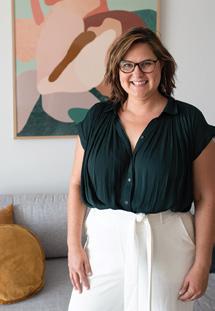
TBH OUSTANDING ACHIEVEMENT IN CONSTRUCTION AWARD
Winner: Laura Barnes, CPB Contractors Pty Ltd

Senior Project Engineer Laura is responsible for managing the complex works associated with Metronet’s Thornlie Cockburn Link. Her work scope includes the construction of a new 50-metre bridge over a live railway line, on an uneven and unique worksite, and within metres of major fuel, gas and power assets. She has been nominated for her tenacity, foresight and technical excellence in delivering the longest TeeRoff bridge beams in Australiaunder extraordinarily geographically and technically complex conditions. Laura also managed significant stakeholder coordination with a genuine and considered approach to engagement.

THE
SWAN GROUP CRYSTAL VISION AWARD
Winner: Jolene Narelle Griffiths, Red Lily Renovationsv

Jo is the Founder and Director of Red Lily Renovations, a boutique design and renovation company in Perth. Jo has worked hard to achieve accreditation as one of only 33 female building supervisors (out of 5,000!) in WA, and joined the 1% of female building contractors within the state. Jo is particularly proud of the work culture at Red Lily Renovations, and creating an integrated approach to the design and build process which is led by women and for women. Through Red Lily, Jo has been intentional in structuring the business to train and develop women in roles typically held by men. She is driven to empower other women to become registered builders, and creating an industry that is one step closer to seeing more women at the leadership table and involved in building decisions. She has proactively negotiated with her trades to establish a flexible work culture, where site meetings are held at times other than 7am to not clash with the school run – which has been wholeheartedly embraced by both the tradespeople and her staff. She champions for her female employees as they navigate the transition from stay-athome mum to working mum, advocating on their behalf and providing flexibility to re-enter the workforce with ease. More importantly, Red Lily do beautiful work, creating affordable, sustainable homes from long-lasting materials that stand the test of time.

66 THE NAWIC JOURNAL 2022
2021 NAWIC NT awards for excellence
Rydges Palmerston Ballroom, Palmerston NT 6th August 2021
JAYTEX
CRYSTAL VISION AWARD
Winner: Mary Linnell, Easy Glass Services
Adversity, being underestimated and working in a ‘man’s world’ is nothing new to this year’s Crystal Vision Winner. Our winner has achieved respect by her peers, staff, clients and community through grit, determination and tenacity. She has been actively involved not only in her business but also in the construction industry to promote opportunities to women and profile the capabilities and diversity that women bring to the sector.
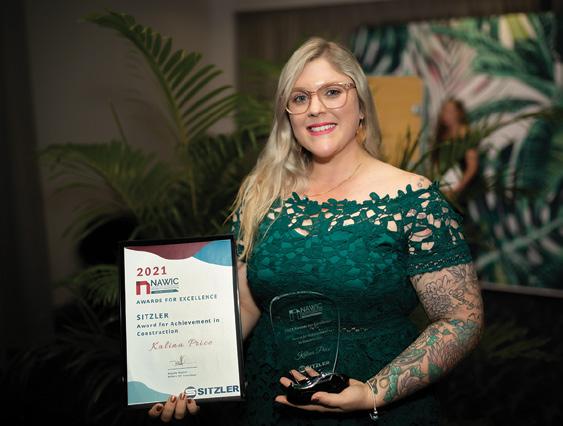

Judges comment: Shifting attitudes is a slow and tedious process. The great news is that your young apprentices are learning their trade with a woman at the helm.
milestone and accolades from her peers is cementing herself as a leader in the workplace from a young age.
SITZLER AWARD FOR ACHIEVEMENT IN CONSTRUCTION
Winner: Kalina Price, GTNT
When you get selected out of 300 applicants, you know you have something special to offer. Despite that our winner had to work hard to prove her worth through an eagerness to learn and grow. Building trust and respect have been her key to success. Her goal is to be the face of women in trades and to educate women of all ages of the career opportunities available.
Judges comment: Sharing your trade experiences and learnings with others gives you the opportunity to grow and demonstrate your goals of ‘it never been too late to start again’.

67 THE NAWIC JOURNAL 2022
TURNER TOWNSEND AWARD FOR ACHIEVEMENT IN PROJECT DEVELOPMENT OR DELIVERY
Winner: Jessica Campbell, KCOM Constructions NT
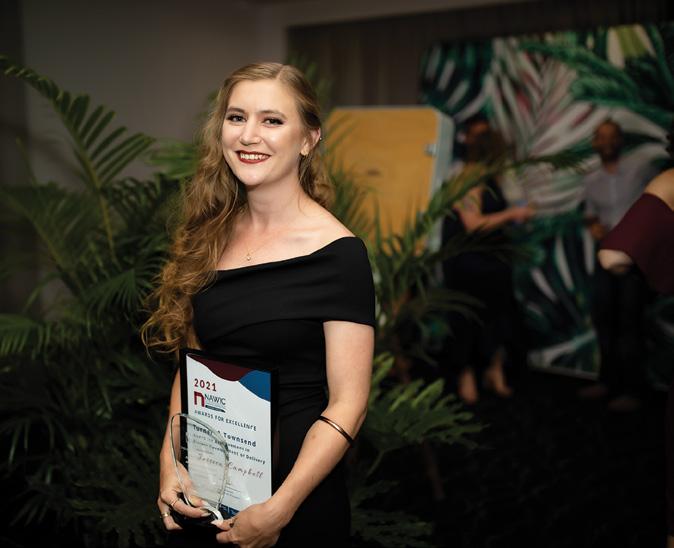

Successfully managing construction projects has been achieved by a mindset to ‘strive for excellence and an eagerness to learn’ for this year’s winner. She has demonstrated that being young and a woman is challenging, but is not barrier to being capable, respected and achieving results on construction projects. As an enthusiastic, proactive and valued team member, our winner is constantly working to improve the business she is a part of, encourage others and increase her skill set.
Judges comments: Excellent application from an up-and-coming woman in the project delivery world while smashing pre-conceived stereotypes in the construction industry.
ECOOZ AWARD FOR ACHIEVEMENT IN HEALTH SAFETY AND/OR ENVIRONMENT
Winner: Carrie Heaven, Glencore
Empowering teams to develop new skills and mentoring women are just two of things that our next category winner has in her ‘toolbox’. In the workplace she has implemented key safety monitoring systems to provide a safer workplace to the team preventing potentially catastrophic events. Training her teams effectively and engaging with technology have been a successful model to create open relationships between the engineering and production teams to deliver workplace safety.
Judges comments: She is being the role model she wasn’t fortunate enough to have. No doubt a positive influence in the workplace, the broader community and a strong leader.
68 THE NAWIC JOURNAL 2022
AWARD FOR A COMPANY SUPPORTING FIRST NATIONS WOMEN
Commendation: Laing O’Rourke
This is the first year that the NT Chapter has introduced this award and the judging panel was not able to select a winner but wanted to award a special commendation to a company that is making a sincere effort to engage with First Nations Women in the Construction Industry.


Employment and Training is a key strategy and initiative that is being implemented to support the growth of First Nations Women in the workplace. Past experience with Aboriginal people and communities has informed the company’s Indigenous Participation Plan. We look forward to hearing the positive stories from this initiative.
IBE CONTRACTING AWARD FOR FIRST NATIONS WOMAN
Winner: Zoe Breed, Aldebaran Contracting Pty Ltd
A new job role led our winner to realise that she is a great leader and has the ability to mentor others. As the WHS manager for a construction company, our winner also had the lead to engage with Indigenous trainees from communities where works are undertaken.
A desire to cook was an unconventional way of getting into the civil construction industry, but our winner soon found out that her passion was training and work health and safety.
Judges comments: Well done on achieving your qualifications. Keep up the professional development and support of others.
69 THE NAWIC JOURNAL 2022
RCC IS COMMITTED TO CREATING GREAT EXPERIENCES
Our Diversity & Inclusion strategy is centred around people and culture, ensuring there is authentic support and opportunity for women in the industry from school age through to senior leadership.
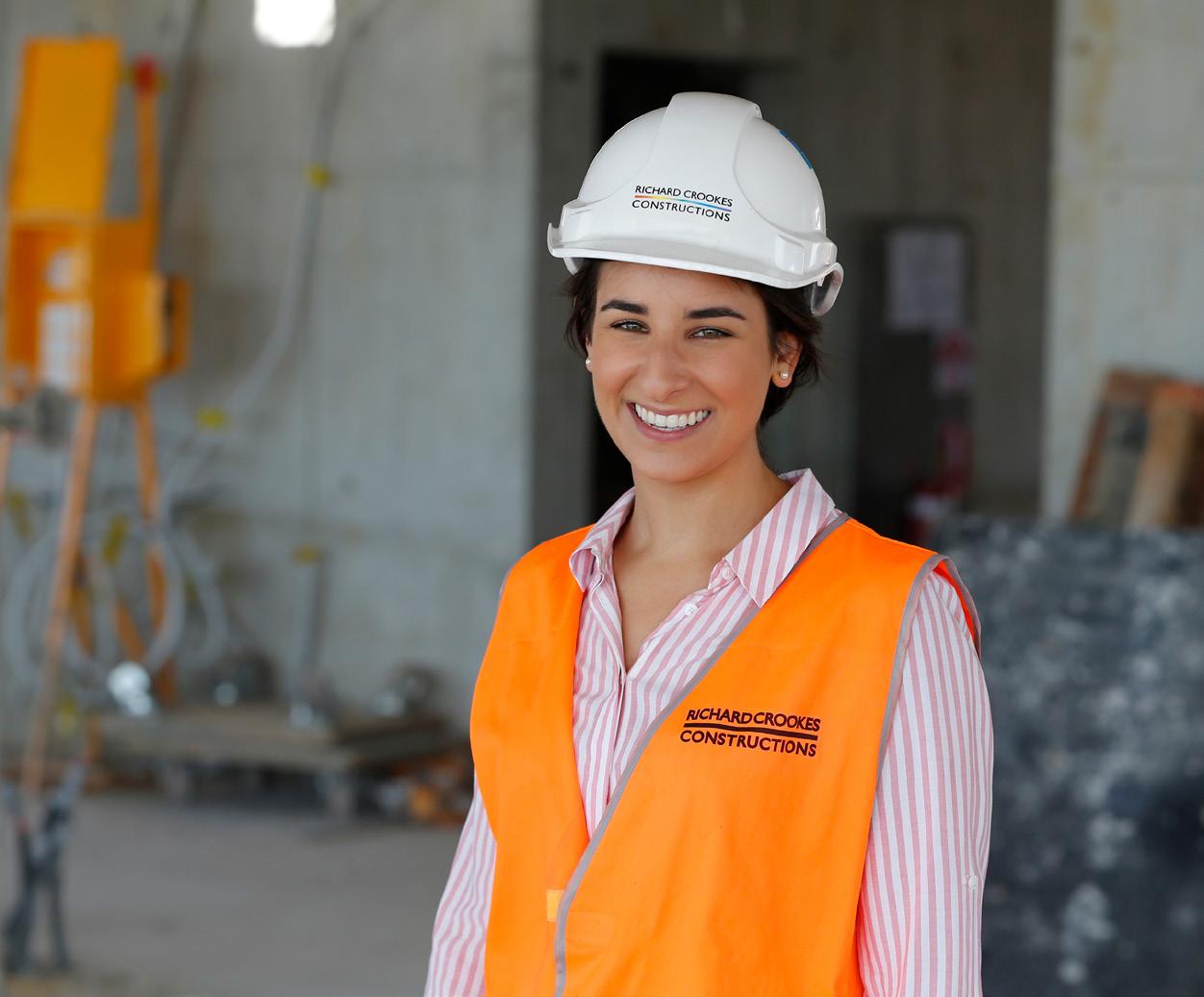
We take a holistic approach to diversity by creating a platform for change by challenging stereotypes and the status quo, allowing people to bring their whole selves to work and be boldly original.
Your

“RCC is proud to celebrate leading women in construction and support the emerging leaders of our industry.”
Jamie Crookes Managing Director
DELIVERING
next career is here!
2021 NAWIC TAS awards for excellence
Wrest Point Casino & Hotel, Hobart TAS
12th November 2021
HUTCHINSON BUILDERS
The Tasmanian 2021 NAWIC Awards for Excellence were held in nipaluna/Hobart on November 12th, at the iconic Roy Grounds designed Wrest Point Casino & Hotel’s waterfront Boardwalk Gallery. 160 guests and nominees celebrated the achievements of the Tasmanian construction industry in our first post-pandemic awards program, with the beautiful Derwent River serving as stage backdrop. NAWIC Tas congratulates our nominees and award winners, and thanks our generous sponsors for making the program and the night possible.
ALL BRICK & ALL CARPENTRY ACHIEVEMENT BY A TRADESPERSON AWARD
Winner: Sophie Russell, Downer Group – VEC Civil Engineering
Sophie is a qualified carpenter who started her career with VEC as an apprentice in 2016. She is a highly valued member of the team and is trusted to deliver tasks that are critical to the success of a project. Sophie has been involved in a number of complex projects including the South Esk Bridge Strengthening project and the Murchison Highway upgrade. She possesses strong technical skills and has a positive approach to her work, and is always looking for better ways to do things.
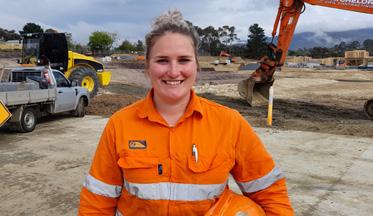
BUSINESS WOMAN OF THE YEAR AWARD
Winner: Mary Massina, CEO & Executive Director, Macquarie Point Development Corporation
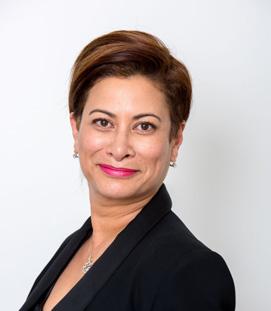
Mary Massina is an experienced business lobbyist, carving out a unique career across the political, public, private and community sectors. With a deep understanding of state and federal politics, and a rare ability to develop and deliver practical policy, Mary has driven reforms which have helped lead the nation, driving reform in planning, taxation, health, disability care and infrastructure funding. Mary has developed and implemented ground-breaking policies, has successfully managed change within large and small teams and has provided strategic advice to governments and politicians – gaining her the respect of her colleagues at both the local and national levels. A powerful public speaker and widely respected media commentator, Mary sits on many boards and taskgroups. A committed relationship builder, Mary has a rare ability to combine policy and politics to deliver measurable results. Mary was appointed CEO of the Macquarie Point Development Corporation in July 2017.
KEYSTONE X NAWIC NEXT STEP AWARD
Winner: Heidi Hofler, Work Health & Safety Manager, Wilson Homes

Heidi has over 15 years’ experience in health and safety across a broad range of industries, having served in various management positions. She joined Wilson Homes in 2019 as the Manager Health and Safety, the first one to be appointed within the organisation.
Heidi holds a number certifications but the most relevant being the Certification in Safety, which was complete at VIOSH – Ballarat University. She volunteers as a member of the Australian Institute of Health and Safety – Tasmanian Branch to support and champion health and safety in Tasmania.
71 THE NAWIC JOURNAL 2022
BORAL ACHIEVEMENT IN CONSTRUCTION AWARD
Winner: Nikki Fischer, Plumber, Cooke & Dowsett Rosetta Plumbing
Since her time with CDR Nikki has been involved with the plumbing aspects on Crown Plaza Hotel, Parliament Squares Marriott Hotel and is currently situated on the new build of the Risdon Prisons Southern Remand Centre. Nikki has been working on water services, sewer drainage, stormwater drainage, fixture fit off and commissioning, installation of fire hose reels and installation of TMV’s.
On both of these project’s Nikki displayed excellent workmanship and organisational skills. Nikki’s technical knowledge of commercial hydraulic plumbing practices should be commended, and we are very fortunate to have her in our team.
Nikki has been able to successfully manage her career while completing her Cert 4 and raising a child, this has been very difficult for Nikki and we have been able to assist with this by offering flexible work hours and by assisting her with time when required for completing her Cert 4 courses.
Nikki often completes her tasks with regular ease and is often called on to assist with difficult technically related problems and is racking up an impressive skill set including being a part of the installation crew for the water management system at the new Southern Remand Centre which involves automated tapware and toilet flushing systems which you could say has a lot of components you wouldn’t necessarily relate to hydraulic works.
Cooke & Dowsett Rosetta Plumbing hold Nikki in the highest regard and have highest expectations for her to develop into
BRICKWORKS CONTRIBUTION TO DESIGN AWARD
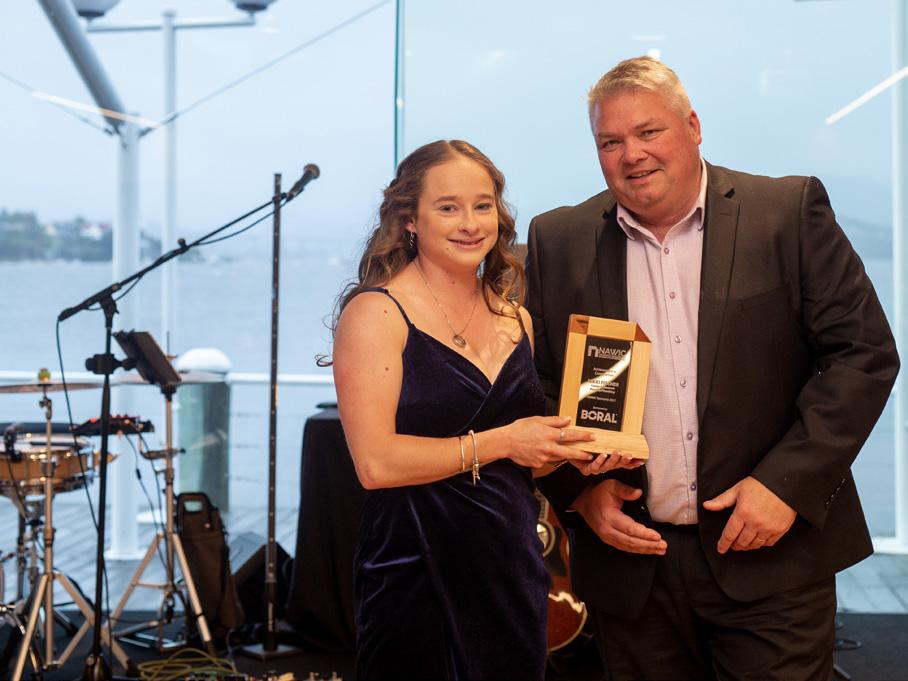
Erin Rockcliffe, Architect, Xsquared Architects
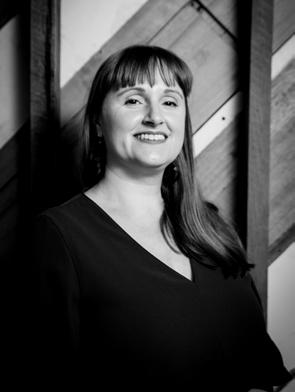
a strong leader within the company and the industry. Her skill set is varied and is highly valued among all construction plumbing companies, so we welcome the challenge and the honour of helping Nikki achieve everything we know she is capable of.
Xsquared Architects work is focused in the commercial sector and has exposed me to a wide range of new experiences. As an Associate one of my tasks is office resourcing, allocation of staff and project needs. Keeping nine professional staff busy and on the right projects to meet deadlines required big picture thinking as well as knowing each individual’s skill set and efficiency at the tasks required. I provide both support and guidance to the Graduate Architects at Xsquared Architects, assisting with training and career progression. I have a Graduate shadowing me on my under-construction projects to provide them with observation experience of contract administration Since I graduated, I have, been fortunate to have employers who have encouraged me to dream big. I have been exposed to a wide range of projects; across the three firms I have worked for. My position at Xsquared Architects has rapidly changed from a Graduate Architect into a leadership role as an Associate. I am provided opportunities to put my skills to tests, in real and challenging situations. This has giving me the confidences to back my gut instincts and step up the challenges put in front of me. I enjoy holding a senior position where I can mentor our Graduates. The scale of projects Xsquared architects currently has is diverse and engaging while allowing for plenty of personal and professional growth.
72 THE NAWIC JOURNAL 2022
CLENNETT’S MITRE 10 CONTRIBUTION TO A PROJECT/ORGANISATION AWARD
Winner: Jacqueline Griffiths, Project Delivery Manager, Wilson Homes
Jackie oversees the Project Delivery Team and a pipeline of over 575 customers across the state. In her role, Jackie’s performance has been outstanding in her support of both staff and the customers she interacts with. The new home journey can present many challenges for customers, both practical and emotional, and Jackie is always there to assist where required. Jackie’s ability to guide the customer through difficult situations is a credit to her, and customers feel comfortable knowing they are in good hands and receiving the best advice possible. Jackie’s knowledge around the construction process and her extensive experience in customer relations comes to the
fore on a daily basis, making her a valuable member of the Wilson Homes team.
Jackie’s skills are critical in allowing the builder-customer relationship to be built on trust which is demonstrated through the positive feedback received from all customers she works with. Jackie’s honesty and integrity are keys in building these relationships.
Jackie’s support of the team she manages also demonstrates how she values teamwork and the general wellbeing of her staff. Providing training, sharing knowledge and assisting team members deal with challenges which arise is a daily task for Jackie, one which she relishes and excels in.
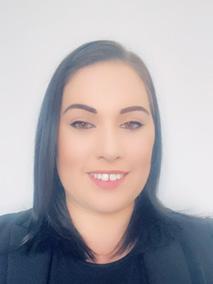
WILSON HOMES CRYSTAL VISION AWARD
Winner: Valentine Interiors & Design
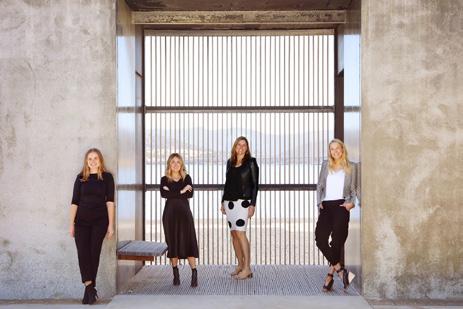
Jane Valentine is Director of Valentine Interiors and Design Pty Ltd, a Tasmanian design firm founded in 2015 that undertakes residential and commercial projects. Jane has 26 years of experience in the design industry. She has received multiple awards, including two recent short-listings in the Australian Designers Award 2021 and IDEA 2021. Jane was also a judge in the GOTYA (Graduate of the Year Awards) 2021. In 2019 she was the NAWIC Business Woman of the Year. Jane is an accredited Interior Designer with the DIA and graduated from the University of Tasmania with first class Honours in design and was then awarded the prestigious University medal. As a commercial and residential Interior Design teacher at Foundry (Diploma of Interior Design, Swinburne University of Technology), Jane specialises in teaching concept development, human-centered design, spatial layouts, and activity-based work environment design.
Claire Bramich is an Interior Designer with a wealth of experience in commercial and hospitality projects, having worked for Crone Architects and Plus Architecture in Melbourne. Claire is a member of NAWIC and a practice member (Valentine Interiors and Design) with the DIA. Claire graduated with a Bachelor of Environmental Design (Interior) from the University of Tasmania. She was presented with the UTAS Interior Design Highest Achiever award. Claire has worked on multiple large scale commercial workplace design projects, including a number of activity based work environments. Her technical ability and attention to detail is outstanding with an exceptional ability to see a project through from schematic design through to completion. Claire is an Interior Design teacher at Foundry, specialising in teaching design documentation, CAD software and detailing designs.
Naomi Doedens is a commercially focused Interior Designer and is a member of NAWIC and a practice member (Valentine Interiors and Design) with the DIA. She graduated with First Class Honours in Interior Design from RMIT and was nominated for the DIA Graduate of the Year Awards (GOTYA) in 2018. Most recently Naomi designed temporary hospitality installations and spaces for the Melbourne Cup Carnival at the VRC. Prior to this, Naomi worked at Carr Studio as a student Interior Designer in 2017. Sarah Mirowski is an Interior Designer and a member of the DIA. Sarah is a part of the team that has been shortlisted for the Australia Design Awards 2021.
Sarah has a degree in Human Resource Management and Marketing from UTAS, and has studied Interior and Graphic Design. Sarah has an incredible ability to understand human behaviour and has successfully applied this to a wide range of residential, commercial and hospitality projects. She is an expert in social media, digital marketing and store layout.
73 THE NAWIC JOURNAL 2022
2021 NAWIC NSW awards for excellence
The ICC Ballroom, Sydney NSW 23rd February 2022
LENDLEASE CRYSTAL VISION AWARD

NSW & National Award Winner: Dominique Gill, Urban Core
A qualified architect and former NAWIC Project Manager of the Year, Dominique Gill decided it wasn’t enough to inspire other women to take the leap into the construction industry. In 2016, Dominique founded Urban Core with a clear vision: 40 per cent of staff would be femaleidentifying by 2022. Dominique not only hit that target in June 2021. She has also grown her business into one that boasts $20 million in annual revenue, healthy profits and a model tuned to expansion. Today, Dominique employs 17 staff across two offices in Sydney and Melbourne, has delivered exceptional outcomes on projects and empowered other women to stride ahead in their construction careers.
RICHARD CROOKES CONSTRUCTIONS BUSINESS WOMEN OF THE YEAR

Winner: Belinda Bentley, 9Springs
As a founding director of independent property investment and advisory group 9Springs, Belinda started her business in 2016 before expanding to provide advisory services to the social infrastructure sector in 2018. With year-on-year growth, 9Springs has been responsible for circa. $910 million of greenfield and infill development projects across New South Wales. Belinda is now overseeing the 7.3-hectare Fresh Hope project – one of the largest intergenerational campus in the southern hemisphere. Belinda is the youngest director appointed to Link Wentworth, a Tier 1 community housing provider, and contributes to the management of 6,400 affordable, social and specialist disability homes. Belinda is also a casual academic with the UTS Built Environment School.
MPA ACHIEVEMENT IN CONSTRUCTION, REFURBISHMENT AND FITOUT
Winner: Aleksandra Gorgieva, Generate Property Group
As the lead project manager on the integrated fitout at NAB Place, Aleksandra Gorgieva represented NAB from the briefing phase in 2017 through to practical completion in April 2021. The nextgeneration workplace across 32,000 sqm features collaboration and workshop spaces, a large atrium and auditorium, and a fullfloor wellness centre with terrace and café. The project integrated the heritage-listed Shell House and 10 levels in the adjoining Premium-grade, Green Star-rated office tower at Brookfield Place. With extensive site experience, Aleks undertook technical reviews, identified scope gaps and built strong relationships with developer Brookfield, builder Multiplex and the client. The result? A spectacular fitout that supports 2,000-plus NAB employees.
CPB CONTRACTORS CONTRIBUTION TO SUSTAINABILITY
Winner: Elham Monavari, Green Building Council to Sustainability
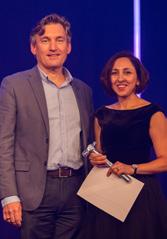
A sustainability leader committed to transformational change, Elham Monavari led the creation of the new Green Star Homes rating tool for the Green Building Council of Australia. This revolutionary rating tool promises to drive down emissions by 70,000 tonnes over the next decade. Elham’s 20-year commitment to sustainability in the built environment has delivered many other dividends: a liveability survey for Mirvac, ambitious waste targets for local government and higher sustainability standards for high-profile projects in the United Arab Emirates, for example. A collaborator, dedicated professional and powerful role model, Elham is now focused on ensuring the Green Star rating system is ready for a digital future.
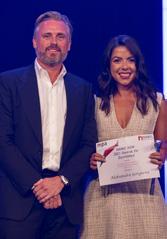
74 THE NAWIC JOURNAL 2022
JOHN HOLLAND TEAM INNOVATION AWARD
Winner: Elena Beleska & Myra Basic, IRT Group
With a determination to think differently about affordable homes, Elena Beleska and Myra Basic invited women to co-design a new model for housing. The result is Jasmine Grove, a unique community for senior single women in Wollongong. Nestled inside a larger retirement community, Jasmine Grove’s eight self-contained villas are set around a shared house and garden. Elena, IRT’s Project Manager, and Innovation and Insights Manager Myra developed a strong concept, designed the collaborative model and secured a government grant to bring their idea to life. The result is a new benchmark for codesigned communities and a bespoke, age-friendly housing solution for women that balances privacy and connection.
HASSELL INNOVATION IN DESIGN AWARD
Winner: Hope Dryden,
Architectus
A talented and inspiring architect, Hope Dryden developed a passion for sustainability and an affinity for engineered timber during her studies. Hope started work on Macquarie University’s transformative Incubator and Ainsworth buildings as a graduate in 2016. By applying elements of her university studies to the project, Hope created a testing ground for prefabricated mass timber in Australia. The result, a departure from traditional Australian university architecture, delivered fast construction and a smaller environmental footprint. What’s more, the Incubator building, originally conceived as a temporary structure, is so well loved as a place to work and study that it is likely to stay in its current location.
FERROVIAL CONSTRUCTION PROJECT MANAGER OF THE YEAR AWARD
Winner: Caroline Denes, Willow
With more than a decade’s experience working on complex construction projects, Caroline Dénès was the Senior Delivery Manager for the City of Sydney’s $100 million Gunyama Park Aquatic and Recreation Centre. Delivering Sydney’s largest aquatic complex since the 2000 Olympics demanded skilled stakeholder management and a commitment to collaboration and inclusion.
Caroline’s visible leadership impressed the judges, as did her approach to managing issues under pressure. Caroline applied her proactive approach and adept problem-solving to navigate the challenges of the Covid-19 pandemic. She successfully handed over the project in February 2021 and is now applying her talents to champion construction technology with Willow.
ROBERTS CO CONTRIBUTION TO A PROJECTS DEVELOPMENT AWARD
Winner: Melanie Elms, Australian Rail Track CorporationInland Rail
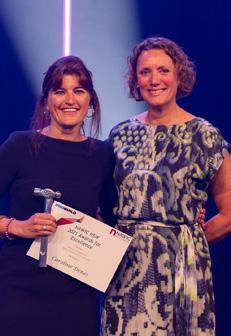
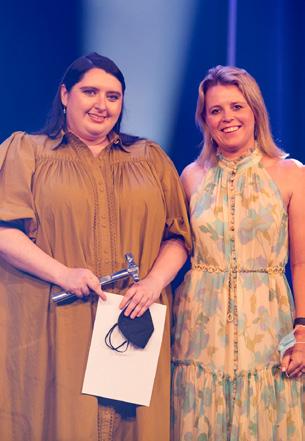

As Australia’s 1,700-kilometre Inland Rail project takes shape, Melanie Elms has navigated the challenges of delivering major infrastructure while championing the interests of local communities. As Stakeholder Engagement Lead for the project’s Narrabri to North Star section, Melanie managed 100-plus stakeholders – from landowners to local councils, members of parliament to the general public. Her determination to leave a legacy in local communities delivered $18.4 million in funds with 107 local businesses. Her skills and understanding of complex infrastructure projects, such as flooding, hydrology, noise modelling and telecommunications, ensured community members could contribute their feedback to the development of Australia’s new freight backbone.
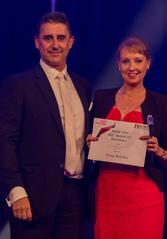
75 THE NAWIC JOURNAL 2022
ADCO CHAMPION OF CHANGE AWARD
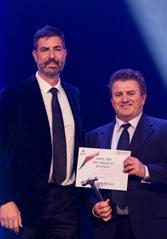
Winner: Stephen Surjan, Roberts Co
As Head of Operations at Roberts Co, Stephen Surjan has been unrelenting in his hunt for talented women. With responsibility for meeting Roberts’ 50:50 gender diversity target, Stephen has championed flexible working across all roles, removed recruitment entry barriers and set new standards for safe sites. Stephen interviews every potential employee and has hired women across roles from project managers to apprentices. In just 12 months female participation at Roberts has risen from 30% to 37% and women make up 60% of the executive team. Throughout 2020, Stephen negotiated a landmark enterprise bargaining agreement with the CFMEU which includes a five-day per week calendar – a new benchmark which has been followed by other Tier 1 contractors.
ACOUSTIC LOGIC REGIONAL WOMAN OF THE YEAR AWARD
Winner: Emma Muller, Maliyan Horizon
A strong voice and advocate for our regions, Emma Muller co-founded Maliyan Horizon to deliver two core business objectives: employment opportunities for regional Aboriginal communities and high-quality service to clients. With a passion for handson work, Emma has delivered contract values of up to $25 million across diverse construction projects, including transmission lines, haul roads and tailing dams. Emma has contributed to thriving regional towns by creating jobs and supporting local business from the Pilbara to the Riverina regions. With an abiding commitment to creating opportunities for Indigenous people, Emma established a companywide mentoring program.
LAING O’ROURKE FUTURE LEADER AWARD
Winner: Kelly Pham, Star PMCA

A skilled quantity surveyor and contract administrator, Kelly Pham has worked on iconic projects in Singapore and Australia. Currently project manager on the $110 million Ryde Central project, Kelly combines technical expertise, excellent interpersonal skills and a commitment to self-leadership. With a voracious appetite for knowledge, Kelly has skills in data analytics, building information modelling, property valuation and sustainability strategy. Kelly’s impressive voluntary contribution to the industry includes mentor roles for both NAWIC and the Master Builders Association in 2021. She is also helping the property industry to support homeless youth through the Property Industry Foundation.
TRANSPORT FOR NSW TRADEPERSON SCHOLARSHIP
Winner: Sarah McArthur, Rab’s Plumbing Service

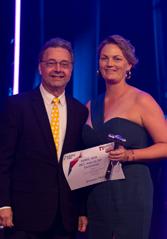
With a passion for physical work, experience in residential maintenance and some VET training under her belt, Sarah McArthur was determined to pursue a career as a plumber. But after facing dozens of knockbacks in her hometown of Perth, Sarah travelled across the country to take up an apprenticeship with Rab’s Plumbing Service in Sydney. Now working with a Tier 1 construction firm, Sarah continues to grow her skills and network, and aspires to pursue further qualifications in hydraulic design. The judges applaud Sarah’s enduring interest in her trade, her deep attention to detail, demonstrated focus, hard work and consistent ethics.
GENERATE PROPERTY GROUP UNIVERSITY SCHOLARSHIP
Winner: Petra Quartullo, University of NSW
Drawn to problem-solving, Petra Quartullo is currently studying a double degree in civil engineering and commerce at the University of New South Wales. Her honors thesis, for which she received a high distinction, applied cutting-edge climate change assessment to analyse the sustainability of urban water infrastructure. This work led Petra to an engineering internship with Boral. From her first day in the fast-paced and high-stakes environment of a granite quarry, Petra has challenged herself to think outside the box. Hard working and focused on the big picture, Petra is helping Boral’s innovation team to test new recycling methods for thousands of tonnes of glass bottles each year.
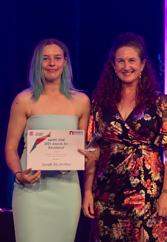
76 THE NAWIC JOURNAL 2022
2021 NAWIC ACT awards for excellence
National Arboretum, Canberra ACT
18th February 2022
ACHIEVEMENT IN DESIGN AWARD
Runner-up: Christie Hartfiel, SQC Group
Winner: Agnieszka Liso, JUDD.Studio
Agi (pictured here, right) is a Registered Architect with 17 years’ experience in design and delivery of major residential, mixed-use commercial and community building projects in the ACT and NSW. She has managed complex works through all project stages: from master planning and functional brief development to concept design, documentation, and construction. Her experience is extensive, including working with government and private stakeholders, engagement and management of specialist teams, and community consultation on sensitive projects.
Agi’s skill and unique approach to both the design and buildability of projects has made a considerable impact on a number of sophisticated, award-winning buildings including the recent Winnunga Nimmityjah Aboriginal Health and Community Centre, and highly sensitive projects of national significance and diplomatic missions.
ACHIEVEMENT IN ENGINEERING AWARD
Commendation: Amy Dowie, Warringtonfire
Runner-up: Nikki Naidu, Hindmarsh
Winner: Nicky Foote, Major Projects Canberra

Nicky (pictured here, right) started her engineering career with a Mechanical Engineering degree from UNSW. Later she added an MBA (Technology Management) to develop her management and leadership skills. In her early career she worked as a mechanical services designer in positions in Sydney, Darwin and Tasmania, working both as a consultant and a contractor. After working overseas for a period she settled in Canberra, working for the Federal and ACT Government in facilities management and project management. She has worked on a large variety of projects in very state and territory of Australia.
DIVERSITY AND INCLUSION AWARD
Commendation: TSA Management
Runner-up: Lendlease, ACT
Winner: Rork Projects
Rork Projects believe that an inclusive and diverse work environment contributes to the quality of their decision-making and successful business outcomes. In their experience, they know there is a real and tangible benefit to creating equal employment opportunities and employing more female staff. Rork Projects proactively work to remove the barriers to success for women at all levels of their organisation.
INNOVATION IN THE CONSTRUCTION INDUSTRY AWARD

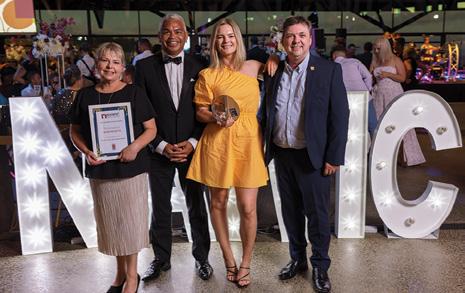
Runner-up: Skye Haffner, OzHelp Foundation
Winner: Christie Hartfiel, SQC Group

Christie is one of SQC Group’s Senior Architects and Associate with over 20 years’ experience in architecture and interior design and has a strong focus on sustainable, functional, highquality design. Having worked for several architectural firms in Canberra and overseas, she brings experience in Passivhaus design, residential, education, and government projects.
Known for her personable and practical approach to achieve tangible, positive impacts, she enjoys managing projects and collaborating with clients and team members. Christie is sought out for her expertise and regularly shares her knowledge with the industry as a teacher of design.
77 THE NAWIC JOURNAL 2022
MENTOR OF THE YEAR AWARD
Commendation: Tim Wise, TSA Management
Runner-up: Melissa Christie, AMA Projects
Winner: Jo Matai, Lendlease
Jo is a South African born Construction Management Professional with Indian heritage, currently employed as a Commercial Manager for Lendlease ACT. She has worked her way through the fundamental positions of Construction Management over the last nine years and is qualified in Business Management, Construction Management and currently studies a Bachelor of Law (Honours) part-time whilst working her current role. Outside of this Jo volunteers her time as a NAWIC ACT Committee Member (Education), to work collaboratively with NAWIC to achieve the ‘Strategy Goals’ that align with her personal interests in advocating for women’s empowerment and advancement in the industry.
TRADESWOMAN OF THE YEAR AWARD
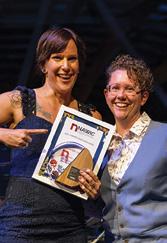
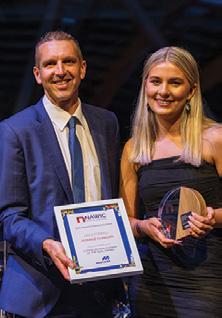
Winner: Sophia Sako, Manteena Group
Sophia (pictured here, left) started in construction 15 years ago in the civil sector. Having always wanted to jump on the tools, she began an apprenticeship in 2018, supported by family, while still a young mother to a three and 21-month-old. Sophia balanced this challenging apprenticeship with her family duties and a long commute. She likes to work closely with young apprentices, supporting them to develop capability. She has demonstrated valuable leadership skills under pressure on her projects, since finishing her apprenticeship. Now working with Manteena Group as a Project Contracts Administrator, Sophia sees her career growth naturally progressing to becoming a Site Supervisor.
CAPITAL REGION STUDENT OF THE YEAR AWARD
Commendation: Laura Worden, Construction Control
Runner-up: Trish Noja, TSA Management
Winner: Jasmine Clingan, Icon
Jasmine is concurrently studying a Bachelor of Construction Management at the University of Canberra full-time, whilst also undertaking a full-time Cadetship with Icon. She is currently working on the $120 million East Gateway project at the Canberra Airport. Jasmine’s dedication to her studies has seen her qualify for both the Dean’s Excellence Award and a membership of the Golden Key International Honour Society. Through her Cadetship she continues to gain valuable insights and knowledge of the construction industry and practices setting her up for a successful career in construction.
CONSTRUCTION BUSINESSWOMAN OF THE YEAR AWARD
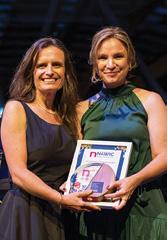
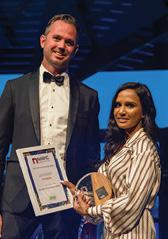
Runner-up: Nolita Ryan, Icon
Winner: Claire Denning, AMA Projects
Claire (pictured here, right) is a dedicated Construction Industry professional with 20 years’ experience, spanning across both the residential and commercial sectors. Her passion for the industry is driven by the continual evolution of new trends, materials, construction methods and opportunities for growth. Claire’s natural ethos is to build relationships. She enjoys working with a diverse range of clients and strives to clearly understand their operations and location to find the best solution to provide quality, value for money and to meet programme requirements. She works closely with Project Teams and Trades to ensure all proposed methodologies and timeframes are deliverable.
78 THE NAWIC JOURNAL 2022
EMERGING LEADER AWARD
Commendation: Casey Rae-Ann Sullivan, Hindmarsh
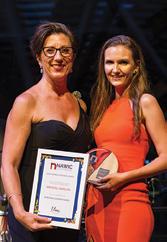
Runner-up: Kellsey Litchfield, ABS Façade
Winner: Krystal Hamlyn, RPS Group
Krystal (pictured here, right) was studying her master’s degree in Architecture when she felt the need to experience the realities of the construction process to strengthen her designs and took on a shadowing experience at a construction company. Once she stepped into steel capped boots on site, she never looked back. Working her way up from Cadet Site Engineer to her current role of Project Manager with RPS Group. Krystal is also a young parent and committed executive on the NAWIC ACT Chapter committee and is passionate about providing guidance for women emerging in the construction industry by helping them foster positive lasting relationships that promote growth and resilience.
CRYSTAL VISION AWARD
Runner-up: Tracy Wilcox, RPS Group
Winner: Dr Therese Flapper, TSA Management
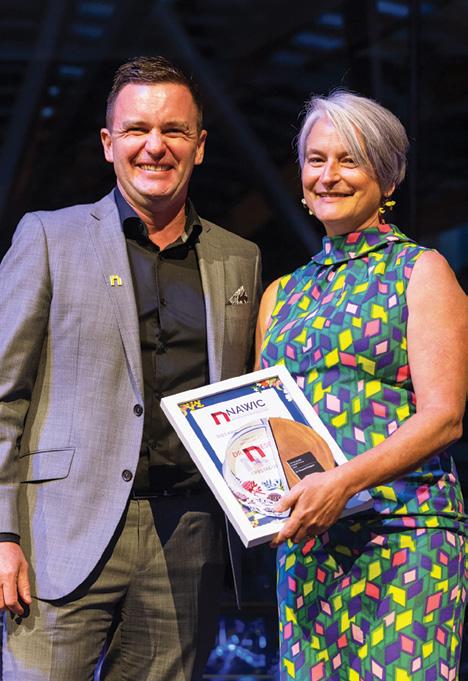

Dr Therese Flapper guides people on win-win paths to deliver best for community outcomes with the application of science and engineering practices. Dr Flapper deploys personal leadership attributes that provide paths forward in complex relationships. This is founded on substantial and practical experience from policy and planning, through to procurement and delivery across the full asset value chain. She has a depth and breadth of engineering experience including its interconnectedness, the broadest objectives (such as sustainability and community health) and the details (regulatory to design). She has a passionate drive to learn more and embrace all, mentor and empower all.
LEADERSHIP IN CONSTRUCTION AWARD
Commendation: Susu El-Husseini, ACT Govt – Housing ACT
Runner-up: Alana Morris, D Group
Winner: Louise Medlin, Hindmarsh
Louise Medlin is a true inspiration. Louise has been instrumental in driving workplace health and safety best practice across her wide and varied career in construction, education, and health care settings. With a partner holding a senior rank in the Australian Defence Force, Louise is a superstar, juggling childcare, work aspirations and project managing last-minute relocations to new areas depending on deployment requirements. Louise takes this all in her stride–developing safety culture programs, mentoring young safety professionals, and increasing the awareness of the unemployment rate of defence spouses.
79 THE NAWIC JOURNAL 2022
Event photography: Ben Appleton, Photox.
2021 NAWIC SA awards for excellence
Riot Wine, Brompton SA
12th November 2021
The 2021 SA Awards for Excellence awards were held on November 12th at Riot Wine. Following a year where it was held online due to COVID-19 restrictions, the event was a welcomed back addition to our calendar.
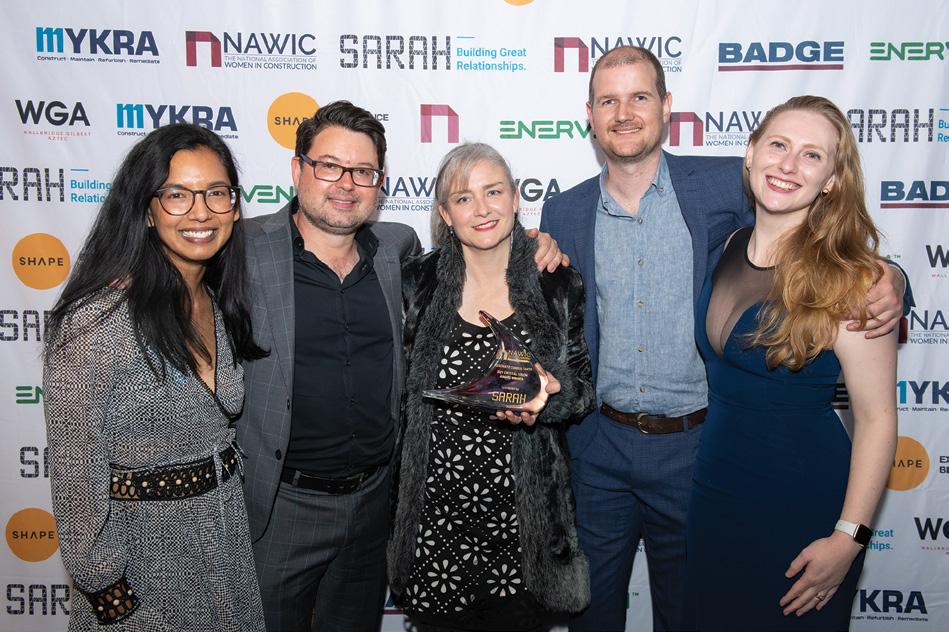
The event celebrated the ideas, the projects, the organisations and the people who are contributing to the future of the construction industry in South Australia and importantly, the visibility and opportunity for women within it.
As firm believers of ‘You cannot be, what you cannot see’, by celebrating and awarding the work women and organisations are doing in this industry, we hear more stories. We showcase our industry and the career options within it. We break down stereotypes and challenge norms. With a record number of nominations received, we thank everyone for their submissions – and offer congratulations again to our winners.
SARAH CONSTRUCTIONS CRYSTAL VISION AWARD
Winner: Resonate Consultants
Founded in South Australia, Resonate Consultants is a specialist consulting business with offices in three states, servicing projects across Australia. As a business, they strive to be different and a disruptor to the industry. They are a largely female lead organisation, supported by a female workforce of over 30%. Their female CEO and female Managing Director, accompanied by their female National Finance Manager influence the culture and policies within the organisation and extend this to the wider community through discussions with their relationship-based clients and industry associations. They have said in their submission that “Greater diversity makes our workplaces stronger” and look forward to what the future holds in their organisation.
80 THE NAWIC JOURNAL 2022
WGA BUSINESS PROFESSIONAL AWARD
Winner: Rebecca Lawson-Cooke, Turner Townsend

In less than two years, Rebecca Lawson-Cooke has had a remarkable impact on the Turner & Townsend business, both at a state and national level. Rebecca has been instrumental to the growth and expansion of Turner & Townsend’s business through building the brand profile in the Adelaide market through a strategic business development approach with local industry, whilst attracting new talent at various levels to the business. Rebecca is also incredibly passionate about ensuring equal opportunities for everyone and is spearheading diversity within Turner & Townsend and the wider construction industry.
ACHIEVEMENT AWARD
Winner: Lucy Nicolson,
Lucy was integral to the successful delivery of the Oval Hotel — Australia’s first hotel integrated into a stadium and SA’s largest cross laminated timber (CLT) structure. Delivered in just over 12 months under challenging operational circumstances, the 138-room hotel was completed on time, on budget, with zero lost time injuries. Lucy was responsible for leading the building envelope and fit-out coordination teams in managing project delivery works including design management, project administration, procurement, quality assurance, and programming. Her ability to align consultants and contractors in realising our client’s vision was vital to this complex project’s overall delivery success.
SHAPE AUSTRALIA CONTRIBUTION TO DESIGN AWARD
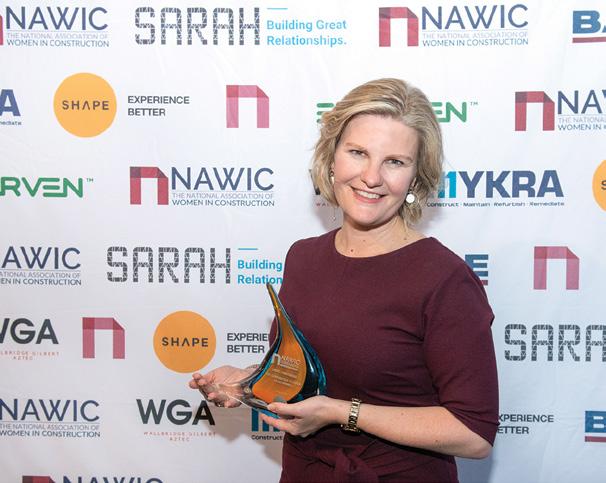
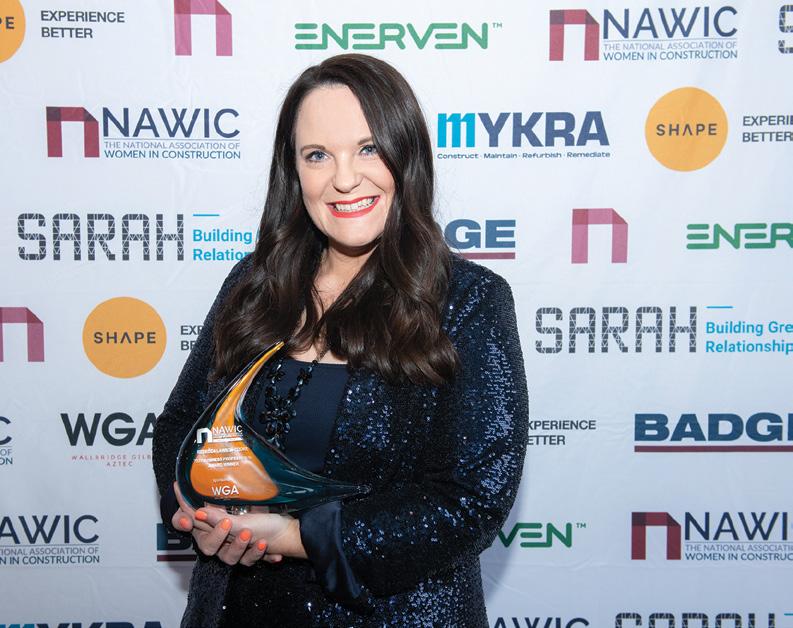
Winner: Cheryl Vandenberg, BUILT
Nominated for her incredibly meticulous approach to the Adelaide Festival Square Car Park project, her achievements will remain underground but the advantages for the precinct will be there for all of us to experience. Saying ‘carpark’, doesn’t sound exciting, there are no visually striking design features, but what happens below determines what happens above. Both complex and high stakes, a project like this is the iceberg that sits below the landscaped tip. Cheryl safely steered the design for the underground Adelaide Festival Car Park that intersects with major heritage and entertainment sites in Adelaide’s CBD. With the safety of end users, the needs of diverse stakeholders and the considerations of what will sit above Cheryl undertook major design revisions and resolutions to avert risks that, fortunately, no one will ever know existed.
81 THE NAWIC JOURNAL 2022
BADGE EMERGING LEADER AWARD
Winner: Evonne Penrose, BMD
Evonne was introduced to BMD in 2019 as part of a pre-release program run by the Adelaide Women’s Prison. Having worked in the construction industry for two years, her commitment to her development, and the effort she puts into mastering new skills, means she has the technical knowledge of someone who has had far more experience. Her exceptional leadership skills are evident through the mentoring role she has taken on in relation to numerous Indigenous and non-Indigenous trainees on BMD’s projects. She leads by example and motivates the crews she works with by upholding BMD’s values.

ENERVEN GRADUATE OF THE YEAR
Winner: Georgia Falzon, Laing O’Rourke

Georgia found herself in the construction industry after having the privilege of never being told she couldn’t. Following her studies in Civil Engineering and Finance she pursued a graduate role at Laing O’Rourke, with the opportunity to work in sectors and projects across the country. Georgia’s ability to collaborate and operate with her team at the forefront of all actions allows her to actively build relationships and solve problems - acting as the catalyst for her nomination. Through her continued development as a site engineer Georgia looks forward to expanding her experience across a diverse range of sectors and teams.
Event photography: Daniel Trimboli, Trim Photography.
82 THE NAWIC JOURNAL 2022
TAYLOR’S TRAILBLAZER
Katherine Barrionuevo, Senior Design Manager
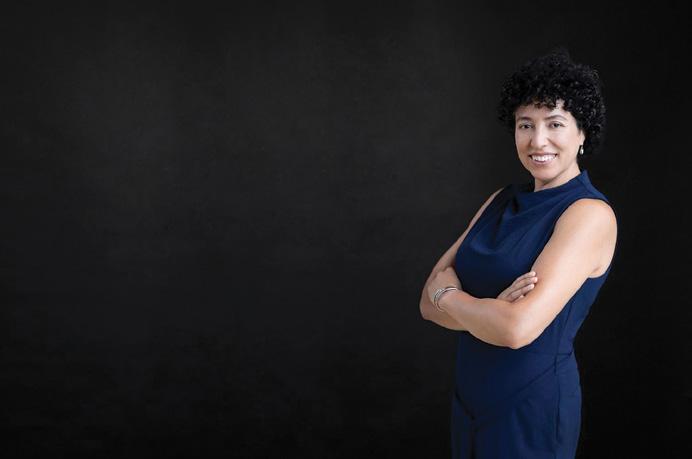
Recognised for her vibrant and empathetic approach, Katherine Barrionuevo’s illustrious career in design began in Peru. Now, Katherine delivers exceptional and effective design solutions for clients across Australia as Senior Design Manager at Taylor. The key to her success? Bold decisions, hard work and an unbreakable family bond.
With more than 15 years’ experience in the field, Katherine has played a pivotal role in projects across the education (public and private), industrial, residential, commercial and retail markets. An expert at managing design for large-scale complex projects, Katherine’s innovative outlook ensures the client’s vision is realised, time and time again.
Building a Career in Design
At 17 years of age, Katherine’s interest was piqued with car mechanics. Sensing this, her father encouraged her to turn this passion into a career in Architecture – a recommendation she credits for her journey, and subsequent successes.
After studying Architecture for five years, Katherine ventured further afield to Buenos Aires, Argentina, undertaking a Post Graduate course while working for a boutique Architecture firm.
It wasn’t long before Katherine sought her next role in LimaPeru, completing her final coursework and working for a small developer. This role exposed Katherine to life on a construction site, as she led the design and coordination while working 12 hour days.
“It was such a treat to be ‘in the trenches’...I knew this was where I was meant to be.”
Two years later, Katherine relocated to Australia, completing TAFE English courses before being offered a role at ESR Commercial & Industrial Property as Design Coordinator.
“I knew I had the spark – all I needed was a little opportunity to make a bonfire.”
Following project completion, Katherine accepted a position at Richard Crookes Constructions as a Project Engineer before being promoted to Design Manager in 2017. After a fulfilling six and half years, Katherine joined Taylor as Senior Design Manager.
In this role, Katherine collaborates with the Bids team to lead the design and coordination of major projects, currently working on the Campbelltown Hospital Refurbishment.
George Bardas, Taylor CEO, comments, “Katherine is committed to unlocking the true potential of our built environment to deliver exceptional spaces. Her admirable work ethic is complemented by a thirst to learn - she is uniquely positioned to achieve great outcomes while continuing to evolve her skillset and expertise along the way.”
Empowering the Next Generation
Since the start of her career, Katherine has led student engagement working as an Architectural Lecturer and inspiring high school students. She recently spoke with girls at Tara Anglican School interested in careers in STEM, cementing their ambitions to join the construction industry. For young women facing language, geographic or financial barriers, Katherine advised, “I joined NAWIC many years ago and found a cohort of women willing to listen and offer advice. Be passionate, perseverant and tenacious, and say ‘yes’ to every opportunity. No matter your background, no matter how well you speak English, no matter where you are from – there is opportunity for everybody in this space.”
Marketing Manager, Taylor

83 THE NAWIC JOURNAL 2022
Cadie Doorley
2021 NAWIC VIC awards for excellence
Grand Hyatt, Melbourne VIC 11th February 2022
ACCIONA AWARD TO AN OUTSTANDING STUDENT, APPRENTICE OR TRAINEE
Winner: Caitlin Moloney, ACCIONA/University of Melbourne

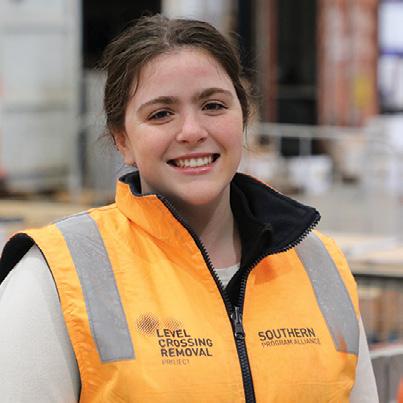
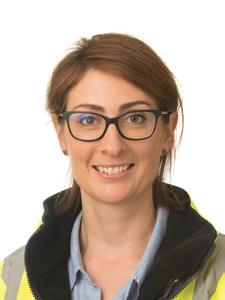
Caitlin’s achievements extend across her education, community service and work experience and has proved her to be an outstanding applicant and well-deserved winner for the ACCIONA Student, Apprentice or Trainee Award. She has committed herself to engaging far beyond participation in course work throughout her education, from challenging the status quo in careers for women in high school through to participation in humanitarian organisations and mentoring during her tertiary education. Caitlin’s contributions to her community through volunteer work, coaching and tutoring, along with her ability create her own opportunities and strong work ethic has gained her experience and achievements beyond her years.
MULTIPLEX AWARD TO A YOUNG ACHIEVER
Winner: Simone Neilsen, Probuild Constructions
Simone challenged how financial information was managed and presented, by developing a tool that removed ambiguity, improved understanding, and opened communication across the entire business. Simone displayed the characteristics of a true leader by taking the time to engage with those affected by the development of this tool. Simone went out of her way to address questions and roadblocks before they appeared. She adapted the tool to ensure that her design delivered what they needed to make good business decisions. It is no easy feat convincing senior leaders to change a system that they are comfortable with. Simone forged that path and the business is now reaping the benefits. Congratulations Simone on an outstanding achievement. You do not get to this position at such a young age without excelling in what you do.
SYMAL AWARD TO AN EMERGING LEADER
Winner: Amy Cassidy, Seymour Whyte
As Seymour Whyte’s Project Communications Manager, Amy actively drives for social procurement, local industry participation and supplier diversity, exemplifying her as a future leader. Serving a purpose greater than herself, Amy is a leader who is breaking down barriers to have a workforce more representative of our social demographic and to be able to recruit and retain the next generation of industry professionals. Amy has found new solutions to having an inclusive and robust sustainable social procurement strategy across the business and in the localised context of achieving the best for the communities in which Seymour Whyte operates. Furthering her commitment to Seymour Whyte’s social performance, Amy championed and implemented their new sustainable social procurement strategy. Amy is the future leader who strives for excellence, always maintaining a social consciousness that ensures the best for project and community.
84 THE NAWIC JOURNAL 2022
BUILT AWARD FOR COMMUNICATION, STAKEHOLDER & MEDIA MANAGEMENT
Winner: Kim Norton, CYP Design & Construction Joint Venture
Coordinating communications for a large-scale infrastructure project for multiple stakeholders with competing needs requires forethought, resilience and agility. Kim’s real-time and multifaceted approach to maintaining relationships with businesses and residents was smart and thoughtful. She took advantage of widely-used mediums, apps and technology to help keep people informed every day. Kim conveyed the complexities of the project in simple and easy to understand terminology, which is not an easy feat as construction language is often technical. In each update she also went to great lengths to share how far both tunnel boring machines – Joan and Meg – had travelled in relation to the stakeholders’ geographical locations. These updates went so far as to explain how vibration and noise experienced varies by person and provided resources for additional information and support. Whenever the impacts from construction work became all too great, Kim provided 24/7 support to assuage their concerns. We commend Kim’s comprehensive communication engagement approach. She tailored upcoming notifications based on the type of milestone and activity, and quickly changed tack when traditional methods of communication were no longer at her disposal during the height of the pandemic.
ICON AWARD FOR OUTSTANDING ACHIEVEMENT AS A BUSINESSWOMAN
Commendation: Sarah-Anne Munro, Alchemy Construct
Winner: Georgina Mahony, Ediom
One of two founding directors of Ediom Pty Ltd, Georgina Mahony’s achievements and ongoing contribution to women in the industry epitomises a high achieving NAWIC Businesswoman. Building Ediom from the ground up, the organisation is a specialised engineering and design management company which has grown to 13 employees and a $4.5m per annum turnover business in just 2 years. Georgina takes a leading role in the operational management of the business in addition to her role as Chair of the Ediom Board. A popular initiative demonstrating Georgina’s strength of communication is her development of the phrase ‘Technical Translation’. The judges admired the unique admission and recognition that at times, communication inefficiencies of engineering and design services can be challenging.
LENDLEASE AWARD FOR OUTSTANDING ACHIEVEMENT IN BUILDING AND CONSTRUCTION
Commendation: Kate Webb, Lendlease
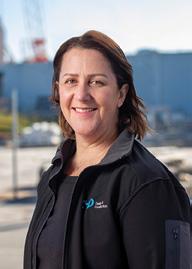
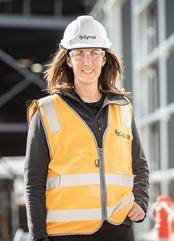
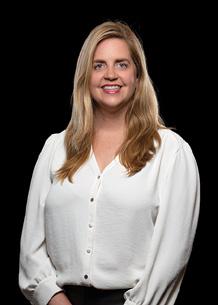
Commendation: Sarah Henderson, Kane Constructions
Winner: Holly Sanders, Symal
Holly is the Senior Project Engineer on the Mt Pleasant Operation, responsible for the control and delivery of more than $16m worth of bridge works and $3m plus in precast elements. Leaving her family and friends behind in Victoria to tackle this significant project in the Hunter Valley NSW, Holly managed all subcontractor works and materials across two simultaneous bridge packages in the challenging timeframe of the COVID-19 pandemic with labour and material shortages and delays. Clear communication and planning, whilst constantly critiquing the program were the keys to Holly’s success meeting project deadlines. Driven to deliver the best possible solutions for the client, Holly led the team in delivering an innovative solution for the construction of the 4.5m wide, 13m tall, hollow octagon piers. By utilising sacrificial polystyrene void formers to create a solid internal block, they eliminated the need to strip the formwork, avoiding working at heights and confined spaces. This solution eliminated two significant safety issues and created greater efficiencies, saving up to three days on the program. Holly’s work on this project, overseeing and implementing innovations in bridge and column construction is an outstanding contribution to the wider construction industry. Congratulations to Holly for an outstanding achievement
Georgina’s ongoing vision, recognition of the value of employees, and an eye on new business and expansion, Ediom is an emerging leader in the market. The company’s 50/50 gender diversity target has been achieved with Georgina further impressing judges in detailing her focus on cross-team collaboration, stakeholder and industry relations. Drawing from collaborative relationships across the industry, Georgina’s 20 years of experience have greatly supported the continual improvement of Ediom since its establishment in late 2019.
Georgina believes that there has “never been a better time for women to lead new business initiatives in the construction market” and with such a role model as Georgina, the judges are encouraged that more women will be inspired to follow in her footsteps.
85 THE NAWIC JOURNAL 2022
JOHN HOLLAND CRYSTAL VISION AWARD
Winner: Shauna Moore, Coleman Rail
It’s rare to find an individual in the construction industry that advocates for the interests of women with such diversity as this year’s Crystal Vision winner Shauna Moore. Judges were inspired by Shauna’s tireless endeavours for the progression of women in the industry by way of driving new initiatives now embedded into Coleman Rail and the Southern Program Alliance (SPA) way of business. This broad scope included highlights such as establishing the SPA Women in Construction Committee, installing female sanitary stations in all site toilets, reviewing procedures to close the pay gap between genders, implementing miscarriage leave companywide and Cultural Change Workshops that identify and tackle key issues and barriers facing women in construction. In addition to doing her job and supporting colleagues through coaching junior engineers and mentoring (locally, nationally and internationally), the judges were particularly impressed with Shauna’s actions outside of her work. Promoting the industry and encouraging more females to consider a career in construction, Shauna speaks at events including career days and council events,
PROBUILD AWARD FOR OUTSTANDING DESIGN
Winner: Shana Besanko, Kane Constructions

distributes posters, presents at local AFL games and attends community markets. Shauna has brought initiatives into her community by developing key activities such as hi-vis dress-up days for primary schools, a one-week Year 10 Work Experience program, and site walks/open days for primary and secondary students. In addition, Shauna has written a book, predominantly for female students in Grade 3 and 4, about careers in construction. Aiming to self-publish towards the end of 2021, Shauna’s contribution to the progression of women in the industry particularly by identifying opportunities to inspire early childhood development is exceptional. Women have benefitted from Shauna’s ongoing tireless efforts as a positive role model within the industry. Most significantly, the judges foresee Shauna will continue to inspire more females to begin a career in construction which will positively develop the industry as a whole.
Shana truly went above and beyond in her role as Design Manager on the Melbourne Sports Centre – Parkville project. It was evident that she did an incredible job managing a complex brief and stakeholder group to achieve an amazing design and project outcome. However, it was her ability to use this high-profile project as a platform to promote women in construction that really made her submission stand out. Shana is clearly passionate about everything that NAWIC stands for and her promotion of this at a company, project and in this case a State Government level should be applauded. Well done Shana
CPB CONTRACTORS AWARD FOR SAFETY
Commendation: Jen Robertson, Symal
Jen Robertson is selected for a commendation for her work in overhauling Symal’s Integrated Project Management Plan (IPMP). This allows a consistent and comprehensive approach for all project teams, consulting with key stakeholders to ensure implications of the new management system are understood and mitigated. Judges also recognised Jen’s support and mentoring for project teams through incident investigations ensuring education and lessons learnt were implemented to mitigate against future incidents.
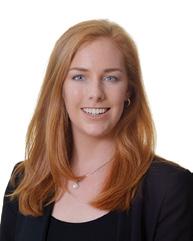
Commendation: Chloe Rees, Kane Constructions
As National Health and Safety Manager, Chloe Rees is commended for her demonstration of safety leadership in her management of the ever-changing COVID pandemic requirements for Kane Constructions. Chloe successfully leveraged her knowledge and lessons learnt in Victoria to assist Kane’s NSW and QLD branches, working closely with Project Managers and the executive team to ensure business continuity. Judges also noted Chloe’s leadership role as a role model for her female colleagues, leading the “Lean-In” group, mentoring and supporting Kane’s female cadets.
86 THE NAWIC JOURNAL 2022
2021 NAWIC QLD awards for excellence
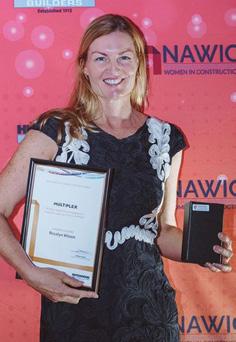
International Convention Centre, Brisbane QLD
22nd October 2021
MULTIPLEX AWARD FOR ACHIEVEMENT IN HEALTH & SAFETY AND/OR ENVIRONMENT
Winner: Rosalyn Wilson, Wilson Environmental Compliance
Rosalyn is the business owner, director and principal environmental scientist at Wilson Environmental Compliance. She works with builders and developers to achieve environmental compliance within project time and cost parameters. Rosalyn’s first and foremost passion is to forge a pathway for the many talented and capable women that follow and break the stereotypical views long held by the construction industry. She has committed time and resources to support and build capacity within young women to enter the construction industry and improve the pathway through education and into employment. When Rosalyn won the award, she was working on a project in Tarragindi to help both the client and the builder achieve best practise in managing the environmental conditions surrounding the site.
CORRS CHAMBERS WESTGARTH AWARD FOR DIVERSITY
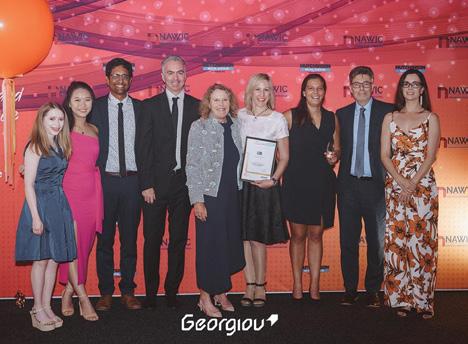
Winner: Constructionarium Australia
Founded in 2016, Constructionarium Australia aims to provide a safe environment for new engineers and construction professionals to develop team working skills, problem solving capabilities and practical experience by working on a real project from start to finish. In 2019 they successfully held its first all-female build and plan many more in the future. The all-female builds are led by a female project manager from industry and the entire team consists of female engineers from construction, services, design engineers or consultants, universities and clients. They are a champion of equality and are committed to ensuring a high presentation of women in all aspects of the activities.
QUT AWARD FOR ACHIEVEMENT IN DESIGN
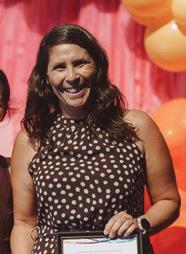
Winner: Nicky Williams, Fulton Hogan
Nicky was Design Manager for the Cocos (Keeling) Island Airfield Upgrade working for Fulton Hogan when she won her award. The location is one of Australia’s most remote with the closest neighbour of Christmas Island more than 1,500km away. This location combined with sensitive natural environments and limited infrastructure led to Nicky
being responsible for a number of unique constraints including managing design consultant in addressing technical challenges of airfield design, temporary infrastructure and enabling works whilst optimising construction methodology to deliver value for money. Nicky wears many hats – she’s a mother, advisor, supporter, mentor, negotiator and enforcer and she approaches each of these roles with the same professionalism that has earned her admiration of many around her.
87 THE NAWIC JOURNAL 2022
CONSTRUCTION SKILLS QUEENSLAND TRADIE OF THE YEAR
Winner: Natasha Kirchner, Airmaster Australia
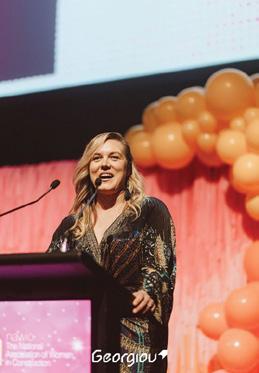
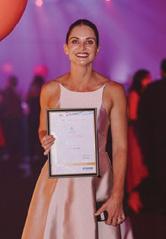
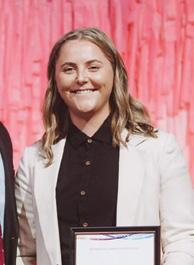
Natasha was a 3rd year refrigeration/ HVAC apprentice technician employed by Airmaster Australia when she won Tradie of the Year. As one of the only female apprentices in her TAFE cohort, Natasha she has overcome many challenges. From classmates not wanting to partner with her as a weak female to becoming the only student in her TAFE Block to pass without having to take any resits. In 2020, she won the 2020 TAFE Queensland HVAC & R Apprentice of the Year. Natasha plans to live by the saying “if you love your job, you will never have to work a day in your life” and hopes to make the world cooler place.
ADCO CONSTRUCTIONS AWARD FOR ACHIEVEMENT AS A BUSINESS WOMAN
Winner: Loren Hickey, John Holland
Loren Hickey is Precontracts Manager in the Infrastructure Division at John Holland. Loren is a member of John Holland’s Top 250 Leaders Forum with only 4% of employees selected to participate. She is currently completing the AICD Company Directors Course with the aim to position herself to gain further experience in meaningful board positions and help other businesses and organisations deliver strong outcomes for the communities, members, employees or stakeholders they serve. She is a visible leader and ongoing advocate for women in construction.
ADCO CONSTRUCTIONS AWARD FOR ACHIEVEMENT AS A
BUSINESS WOMAN
Winner: Ineke McMahon, The Path to Promotion/Objective Recruitment

Ineke McMahon not only runs a successful recruitment business to which she is the sole director but also runs Path to Promotion which was launched in 2019 that helps people of all genders accelerate their career success. She is a champion for women within the industry and actively headhunts women to diversify all her shortlists for candidates.
DIAL BEFORE YOU DIG AWARD FOR ACHIEVEMENT IN CONSTRUCTION (CIVIL WORKS)
Winner: Rasha Al-Badry, Downer EDI Works Pty Ltd
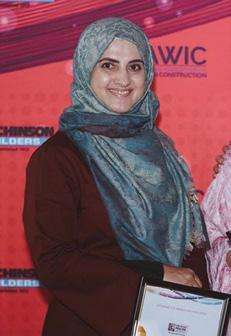
Rasha was a Project Engineer with Downer when she won the award and has since been promoted to Project Procurement Manager. She has built a solid reputation by implementing her technical skills as an Engineer and assisting the delivery team to deliver high quality projects for their clients. Rasha was born and raised in Iraq and overcame the trauma of escaping a war zone. She has successfully navigated having her engineering qualifications recognised by Engineers Australia and migrating to Australia with her young family. Rasha is known amongst her team for her problem-solving skills as well as her ability to think outside the box and work collaboratively with the client and her team.
BLUECOPE AWARD FOR ACHIEVEMENT IN CONSTRUCTION (GENERAL BUILDING)
Winner: Cherise Czislowski, Lendlease Building Pty Ltd
Cherise is Operations Manager with Lendlease and completed the Brisbane Girls Grammar School Science Learning Centre Project whereby she was responsible for the overall delivery of the works safely, on time and budget and led an extensive stakeholder engagement initiative which provided students with insights and hands on exposure to the construction process
from start to finish. She provided the students with access to the site via Student Access Groups as well as spotlighting key trades and unique project attributes. The building featured many unique design ideas to celebrate the teachable moments in science and meant meticulous design coordination and modelling coupled with detailed engineering analysis and extensive sampling were all part of the overall process of delivering the project on time and budget.
88 THE NAWIC JOURNAL 2022
ACCIONA EMERGING LEADER AWARD
Winner: Melissa Hewitt, ACCIONA Construction Australia
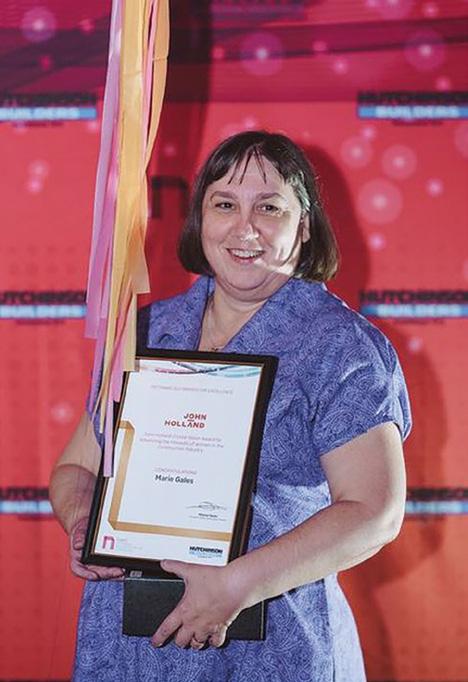
Melissa is the Communications and Stakeholder Manager for Acconia on the Brisbane Metro. She has influenced the culture there and promoted acceptance, equality and participation through the establishment of the Brisbane Metro Wellbeing Committee which champions the mental and physical health of our team through initiatives including internal events, education, training and charity fundraisers. As a leader, she believes that recruiting and retaining excellent female talent is crucial and strives to show other women in her team and project that they are important, valued and actively pursue opportunities to nurture their personal and professional aspirations and show them they are truly supported. She hopes to continue to be able to have the opportunity to demonstrate the significant social value of major infrastructure projects beyond the physical infrastructure.
JOHN HOLLAND CRYSTAL VISION AWARD FOR ADVANCING THE INTERESTS OF WOMEN IN THE CONSTRUCTION INDUSTRY
Winner: Marie Gales, Brisbane City Council
Marie Gales is the Program Manager for the Transport Planning and Operations branch of over 200 people within Brisbane Infrastructure at Brisbane City Council. Marie is a supportive and inspirational leader that has helped build a workforce that reflects the diversity of the Brisbane City Council Customers and creates a work environment that gives all employees an opportunity to engage, develop and perform at their best. She was instrumental in embedding the BI Culture Plan within the Transport Planning and Operations branch which provides a clear and understandable framework for meaningful discussions and its application allows for equitable approach to assessing and managing performance and provides clarity of expectations, career progression, personal development and growth. Marie has a passion for leading by example and enabling growth within her staff. She is incredibly proud that 50% of her branch executive leadership team are passionate female engineers.
Event photography: Jac Lee Photography.
BUSSQ SUPER AWARD TO A YOUNG ACHIEVER

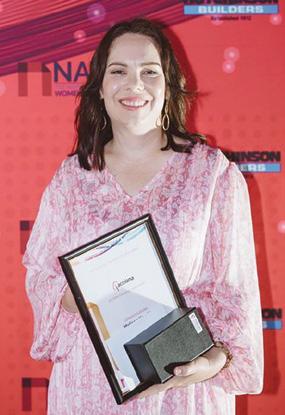
Winner: Melanie Sweeney, Jon Cook Tiling
Melanie is a qualified wall and floor tiler for Jon Cook Tiling working on mainly residential renovations and new builds including indoor and outdoor areas, pool surrounds and bathroom remodels. She was the winner of the 2019 TAFE Queensland Construction (Wet Trades) Apprentice of the Year Award and has also won the World Skills Australia Regional Competition (which is the skills ‘Olympics’ that work to benchmark industry excellence at home and across the globe) and competed in the National Championships. Melanie’s goal is to be able to work with more female apprentices as a leader and mentor and give them the best possible head start in the industry.
89 THE NAWIC JOURNAL 2022
You can be what you can see!
Tell us about your journey, chapter event or workplace.

Simply tag #nawicau and we'll share your . news with our community
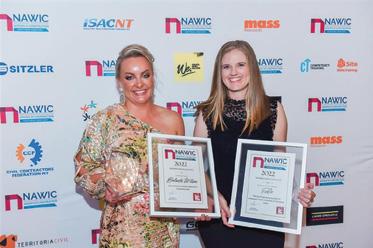
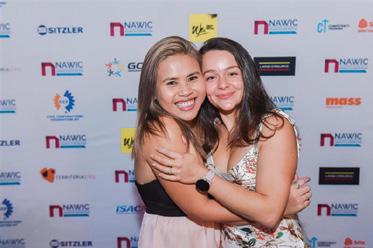

90
HOUSING DEVELOPMENT SETS NEW BENCHMARK FOR WOMEN AT RISK
Some of Western Australia’s most vulnerable women will soon have a new place to call home, with a consortium of charities and private companies donating more than $1 million in goods and services to restore Fremantle’s historic Wyn Carr House.
The first of its kind in Western Australia, the refurbishment and extension of Wyn Carr House, a vacant heritage-listed building, will provide short and medium-term accommodation for women aged 55 and over who are homeless or at risk of homelessness.
The transformation of Wyn Carr House will provide purposebuilt accommodation for women, combined with wraparound support services, to create a safe and dignified space for women to access the support they need to take the next steps on their journey towards long-term, stable housing.
Wyn Carr House is owned by the Community Housing Provider and Not-For-Profit organisation Uniting WA who operates the successful Homeless Accommodation Support Service (HASS) which currently accommodates 34 people in transitional accommodation across Perth. The HASS program addresses the drivers of each individual’s homelessness to break the cycle. Each person residing at Wyn Carr House will have a person-centred care plan that is trauma-informed and strengths based.
The original heritage-listed Wyn Carr House will be accompanied by a new two-story residential building, with both buildings adjoined by a secure courtyard. The ground floor of the new build will include shared living areas, a communal kitchen and laundry, while 12 ensuite bedrooms will be located on the first floor. The restored Wyn Carr House will also include purpose-built spaces to support residents during their tenancy.
The contemporary design by Cox Architects considers the elements vital to promoting healing, improving physical and mental health, and the overall wellbeing of individuals and their communities. To achieve this, the design delivers safe, private, dignified, accessible spaces which contribute
to create a sense of home that will positively impact the lives of those who utilise it, now and into the future.
The development is the first WA project by notfor-profit organisation Housing All Australians (HAA), which has partnered with Uniting WA and more than 20 individuals and private companies (listed below), who are all donating professional services, construction materials and furnishings.
Women in construction supporting women in the community
Uniting WA and HAA have been supported throughout the project by RPS Project Manager
Michelle Clarke and Assistant Project Manager
Madeleine Sammut, Kirstin Beedie, Sally Ross and Ljubica Petrovic from MinterEllison, Ingrid Maher from Planning Solutions, Nerida Moredoundt and Kyra Lomas from Element WA, Verity Campbell from HAA, Gwen Willox from Arup and Sally Bagley from Marawar, WA’s largest Aboriginal-owned construction business.
Michelle Clarke from RPS said, “The opportunity to use my skills to contribute to a project which will assist and empower vulnerable women in our community to create better lives for themselves is one that I will be forever grateful for. Facilities such as Wyn Carr House provide valuable support for women and offer safe and stable accommodation, allowing these women to shift focus from meeting basic survival needs, to planning for and establishing an independent future for themselves.”
Harnessing the collective power of government, notfor-profits, business and philanthropy
As the wait list for social and affordable housing continues to grow, we need to reimagine the way we approach housing and homelessness. Collaboration across the government, private and not-for-profit sectors is needed
91 THE NAWIC JOURNAL 2022
to create pathways that enable people experiencing homelessness to achieve ongoing transformational change.
We know that supported transitional accommodation works as an effective intervention measure, and we are seeking to unite – in a true partnership between a not-for-profit organisation, business, government and philanthropy – to enable and empower vulnerable women to take the first step in their journey to exit homelessness.
Wyn Carr House is a leading example of how private industry can support the community sector in providing vulnerable groups with a modern, safe and respectful space to rebuild their lives. It exemplifies what can be achieved when purposeled private sector organisations partner with the not-forprofit sector to achieve outcomes for the most vulnerable in our community.
HAA is continuing discussions with other property owners in Perth and other cities to create more emergency accommodation, with help from its partners. Changing our approach to housing and homelessness, and funding innovative transitional accommodation projects for women at risk, will also deliver benefits to the State by reducing the financial burden on the Health and Justice systems, as well as the community services sector and delivering lasting social benefits to the broader community.
How you can get involved and help
With an ambitious plan to have the refurbishment and contemporary new green build completed by 2024, Uniting WA is seeking support to help close the funding gap to ensure the reimagined Wyn Carr House becomes a reality.


“As the shortage of affordable housing continues to grow, more women than ever need this critical support. Wyn Carr House has a legacy of nurturing vulnerable women and with your help, we can deliver a solution that enables women in crisis to get the support they need to transition to a secure, stable home,” Lisa Fini, Uniting WA NonExecutive Director and Campaign Chair
$1.5 million is needed from supporters to complete the project, with a further $150,000 needed each year to support residents transitioning to independence. For individuals, trusts and foundations, this is an opportunity to reach out and support vulnerable women over 55 from your community.
Become one of those in the construction industry who actively support women in our community. Generous (and tax deductible) financial contributions and donations of materials and products to construct, fit out and operate this facility will assist Uniting WA to help vulnerable women to rebuild their lives.
Please visit unitingwa.org.au/wyn-carr-house or housingallaustralians.org.au/whatwedo/give-me-shelter for more information on how you can collaborate with Uniting WA and HAA to contribute to this project.
Pro Bono partners are:
⋅ Cox Architecture
⋅ RPS (Project management)
⋅ Planning Solutions (Town planning)
⋅ Element Heritage (architecture)
⋅ MinterEllison
⋅ ARUP Engineers
⋅ Rider Levett Bucknall (Quantity surveyor)
⋅ MNG Surveyors
⋅ Tim Davies Landscaping
⋅ PrintandSignCo (Printing)
⋅ Code Group Building (Code compliance)
⋅ Strategic Fire (Fire engineer)
⋅ Galt (Geotechnical engineer)
⋅ Powerledger Sustainable (energy advisory)
⋅ Braincells (Marketing & Promotional Material)
⋅ Advance Press (Printing)
92 THE NAWIC JOURNAL 2022
HOW CAN WE ENCOURAGE & CREATE MORE PATHWAYS FOR WOMEN ON BOARDS IN CONSTRUCTION?
Research by the 2022 Board Diversity Index suggests that while the number of women on boards increased by 34 (a total of 667) this year, 19% of female directors occupy 48 per cent of female seats.
Recently at a NAWIC lunch for Women on Boards - the question arose:
How do I utilise all my experience and get into a board position?
This fascinating lunch and learn session shared insights around board level positions and how to plan for, position yourself and choose the right board for your career and commitment. There was a clear theme around the roomthere is the interest, there is the drive and there is the hunger for board level positions but, where should someone even start?
1. Focus on your potential over performance
One of the first thing to consider is starting to focus on your potential versus performance. It’s about calling out more boldly and clearly and articulating your potential for these positions. It’s about learning to have the conversations and questions we can often be uncomfortable having to position yourself for success and networking. You may not be ready for that board level role yet, but one of the board level members sitting in the chair at this event took her first board level role at 29 years old. So, the idea is to start before you think you are ready and figure out the rest along the way.
2. Develop some core skills valued in boards
There are a few key skills that are often highly valued in a board position so looking at these as part of your career
development strategy and pathway are highly regarded for board level roles.
Corporate governance: At a board level you need to be able to articulate and practise good corporate governance. This is a skill that permeates a whole organisation and if you want to change, impact the world and leave it as a better place than this needs to be an underpinning value you hold and can demonstrate competence in for board level roles.
Profit and loss: At a board level you need to really get to know your P&L and become comfortable with the financial responsibility and detail required at a board level. Being accountable and understanding the implications of financial results is a universal skillset that came up as being required to get a seat at a board level position.
There are key skills wanted at boards and a spectrum of competencies and skills. Some of these may include a strategic mindset, technical knowledge and behavioural competencies. You need to be able to identify and articulate your skill capabilities and reflect on what boards you would be looking for. Annual reports and reading through the Chairman’s report and key challenges identified can help you understand where you are against that benchmark and develop a strategy as to how you can position yourself for that board’s particular needs.
3. Select the right board
Once you have identified you want to be a board member, the next step is to select the right board for your unique value proposition and this takes research.
You should assess the effectiveness of the board on decision making and culture development and look very closely at the Chair and their values and corporate governance.
93 THE NAWIC JOURNAL 2022
It is the Chair’s responsibility to constructively critique, provide the framework and it is well known that moving from Director to Chair can be three times the increase in responsibility so the person heading up this role is someone you should be looking at very closely.
You need to look at the Chair of the board and ask yourself if they have the right values and look closely at how they steer the ship. The average board level position commitment is 9-10 years so this decision shouldn’t be taken lightly.
4. Volunteer at a school board
Look at the real value you add and match your skill set to the right board. A great way to get exposure is to get board experience at a school. They have complex legal and regulatory frameworks that are a perfect starting point for building your board level career. Schools struggle getting valued members at this level so this is one area you can put your hand up.
5.
Don’t go “overboard”
One thing you should avoid when looking at board level position is “overboarding”. Tread slowly, read the papers and ensure you have that day allocated a week for the board commitments so that if something crops up you need to deal with urgently then you have the time allocated with your schedule.
Being a part of the right Board can be a way to leave a legacy and impact in the world which can be truly rewarding when you make the right commitment.
With women holding just 29% of board level positions, there has never been a better time to start planning for change and steer your ship towards a future Chair position. You’ll never get there if you don’t start somewhere.
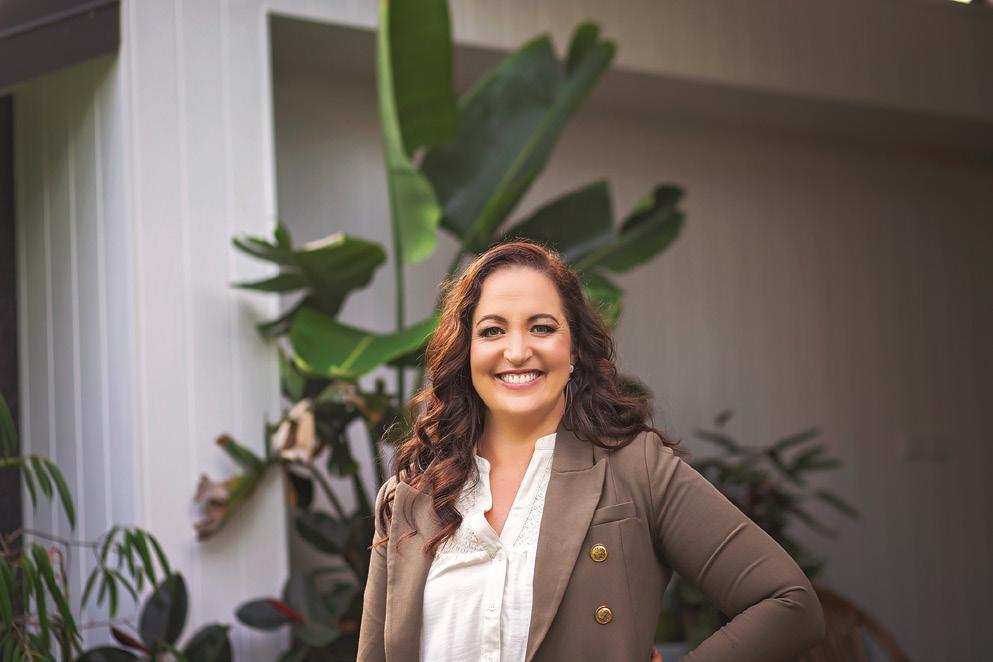
94 THE NAWIC JOURNAL 2022
Lauren
Talent Director at Karan & Co
Karan
EMPOWERING GIRLS TO FIND THEIR PLACE IN CONSTRUCTION
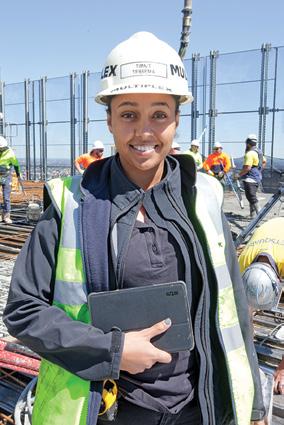
One of our industry’s greatest challenges is encouraging more women into construction. In helping to tackle that challenge, Multiplex has enabled its own people to shape a program for schools that has both meaning and impact.
Jump Start is an award-winning mentoring initiative that gives students in Years 9-12 a holistic view of what the construction industry is really like via workshops, panel discussions, site walks, and mentoring sessions.
It was founded in 2019 by a group of Multiplex women working on the One Denison project in North Sydney, who wanted to give female school students a different experience to their own.
“As school students, we weren’t given an opportunity to learn about the different career options within the built environment, and we had to rely on trial and error to find what was right for us,” said Jump Start co-founder and Multiplex Project Engineer Timnit Tessema.
“We drew on that experience to develop the kind of program we wished we had as students.”
Jump Start was piloted with students from local schools invited to the One Denison project site, to see first-hand what a day in the lift of delivering a project is really like.
“The industry is clouded by many stigmas that deter young women from entering this field. We wanted to help change the way girls perceive construction and break down some of the stereotypes,” said Timnit.
“We also wanted to show them what’s possible and excite them about the prospect of a career in construction. It’s such a rewarding career choice with so many different people coming together to deliver a project.
“With Jump Start, girls can see for themselves that the construction industry is broader, better, and more diverse than they think.”
A key point of difference from any other program in the industry, is that Jump Start works not just with students, but also their extended communities.
“We not only educate these young women, but we also aim to educate their educators, career advisors, and parents to ensure accurate information is being distributed,” said Timnit.
By breaking down stereotypes and providing a more accurate look at the industry, Jump Start helps foster not only the students’ natural interest in construction and but helps provide guidance for their support networks to empower them to pursue it if they choose.
From on-site pilot to national expansion
Following a successful pilot and collaboration with schools to fine-tune the syllabus, Jump Start has been embraced by Multiplex and become an important part of its overall Diversity and Inclusion commitment.
Multiplex now rolls out Jump Start across projects in Queensland, Western Australia, and the Australian Capital Territory. It is also proudly run on every project in New South Wales.
“We know from research that to attract more women into construction, we need to educate them early at the point at which they are beginning to consider their future careers,” said Executive Director of People at Multiplex Caitriona Comerford.

“Jump Start is allowing us to do that in a very grass roots way. It works because it is grounded in our people and their experiences; the same group of women that started it continue to be instrumental in its expansion.”
Reflecting on the success of Jump Start, Timnit says it’s the impact it has on students that is the most rewarding.
“I have seen students who were in our pilot program in 2019 now start to enter the construction workforce – I am most proud of that. I am proud that change is happening, and I can assist with that.”
95 THE NAWIC JOURNAL 2022
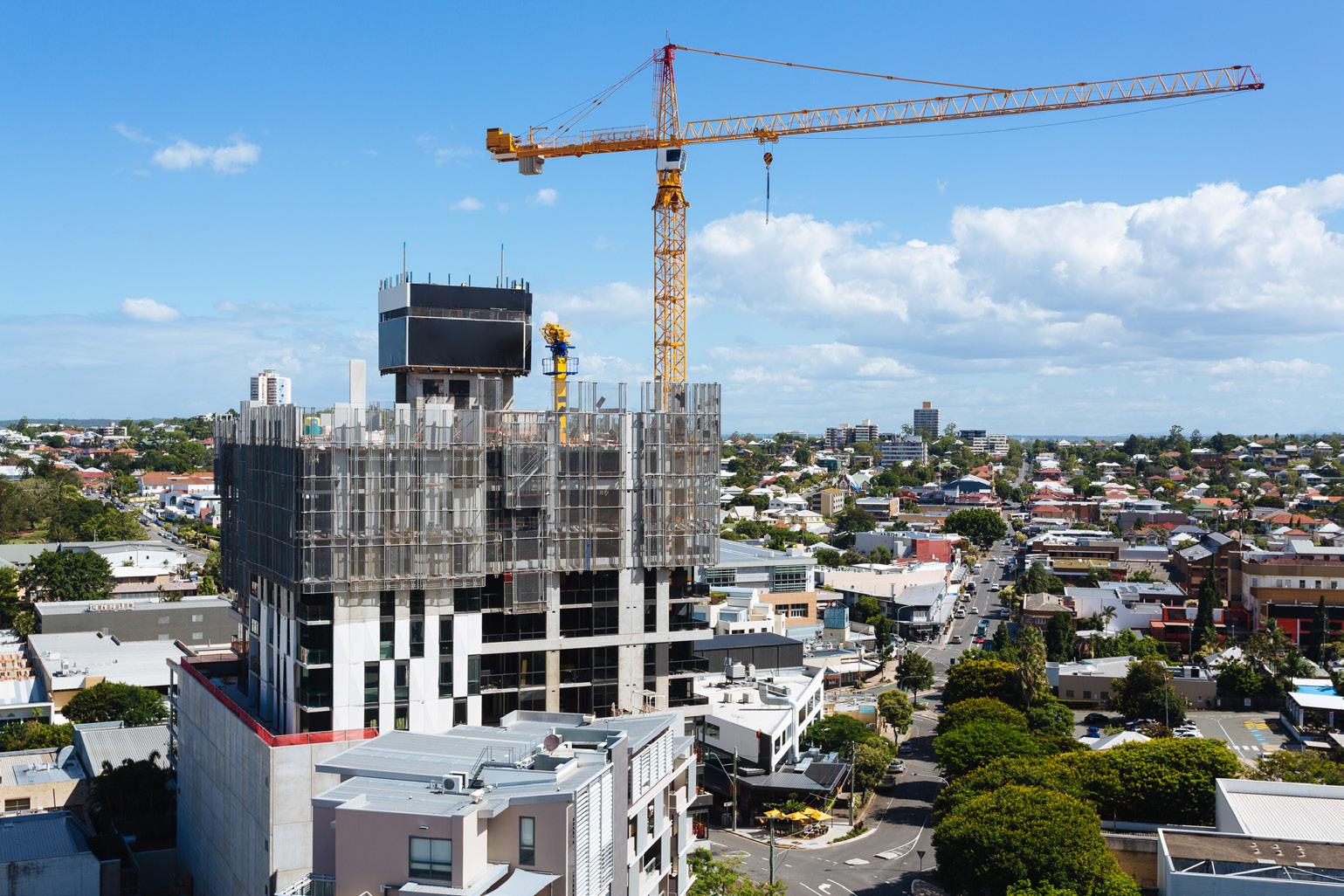


96 THE NAWIC JOURNAL Inside Construction is a leading source of construction news, features and comment. Regular news updates on construction contracts and tenders, the latest in construction technology and expert analysis and research keep our readers informed with the latest developments in the industry. Exclusive offer for NAWIC members Scan QR code or email subscriptions@primecreative.com.au and enjoy a FREE 3 month subscription. Scan QR code FREE 3 MONTH SUBSCRIPTION TO kane.com.au Celebrating our women leading the way in construction Congratulations to our award nominees for 2022 | Kelsey Icardi and Lindsay Rattray


Call 24/7 1300 878 379
Here to help when you need it












 LYN O’BRIEN Director
KYLIE JUDD Director
LISA HOGBEN Director
LYN O’BRIEN Director
KYLIE JUDD Director
LISA HOGBEN Director



 Dr Niki Vincent Public Sector Gender Equality Commissioner, Victoria
Dr Niki Vincent Public Sector Gender Equality Commissioner, Victoria






















 Steele (Architect)
Steele (Architect)






 Fremantle Docker and Electrician Ebony Antonio
Fremantle Docker and Electrician Ebony Antonio
 Jo Matai-Taylor, Commercial Manager for Lendlease Construction
Jo Matai-Taylor, Commercial Manager for Lendlease Construction










 DRIVEN BY CHALLENGE, BUILT WITH PRIDE
DRIVEN BY CHALLENGE, BUILT WITH PRIDE















































 Brisbane | Gold Coast | Sydney
Founded in 2018 by Rosalyn Wilson
Brisbane | Gold Coast | Sydney
Founded in 2018 by Rosalyn Wilson













































































































